Excursiones y Viajes en Autobús Valencia, España
Descubra y explore con una aventura de su elección.
- LO MÁS POPULAR
- Hour Glass 2 Horas
- User Todas las Edades

Explora Valencia al Completo en Tuk Tuk
¿Estás preparado para vivir una experiencia en Tuk Tuk en Valencia? ¡Únete a nosotros en esta increíble aventura! El tour comienza en uno de los lugares más importantes de Valencia, la Estación del Norte, en la oficina de TourismHub. Desde allí, comenzaremos nuestro épico recorrido turístico.
- Hour Glass 48 Horas
Bus Turistico en Valencia
Un autobús turístico es una de las formas más emblemáticas de disfrutar de Valencia. Contemple las vistas desde la comodidad de su asiento mientras le conducen por las calles y sube y baja en las 17 paradas de Valencia, lo que le permitirá seguir haciendo turismo durante más tiempo.
Albufera Bus Turistico
Con el servicio Albufera Bus Turistic, podrá conocer el Parque Natural de la Albufera y disfrutar de un paseo en barco por el lago incluido en el precio.
Alquiler de Bicicletas por Día
Visitar Valencia en bicicleta es para muchos la mejor manera de hacerlo. Una de las características de la ciudad de Valencia es que es llana en toda su extensión, ideal para recorrerla en bicicleta. Vive la experiencia de pedalear por este bello lugar a tu ritmo y de forma sostenible.
- Hour Glass Hasta 7 días de Alquiler
- User A partir de 11 años
LAS MEJORES VISITAS Y EXCURSIONES
En TOURISMHUB le ofrecemos las mejores opciones turísticas para la ciudad de Valencia, aquí podrá encontrar las mejores visitas y excursiones que la ciudad ofrece

Tourism Hub es una marca registrada de Noc Renting, S.L., que a su vez pertenece al prestigioso grupo empresarial Transvia. Nuestra experiencia nos avala ya que llevamos desde 1999 ofreciendo diferentes servicios turísticos en la ciudad de Valencia.
Tourism Hub es un centro turístico tanto físico como digital que ofrece las mejores excursiones y servicios turísticos para realizar en la ciudad de Valencia: desde divertidas visitas culturales en tuk tuk, alquiler de bicicletas, recorridos panorámicos en autobuses de dos pisos, visitas al Parque Natural de la Albufera y dispositivos de audioguía en alquiler para ser tu propio guía de la ciudad, entre otros servicios.
Nuestra experiencia, como transportistas y agencias de viajes, nos ha llevado a innovar y mejorar nuestros servicios año tras año, incorporando nuevos productos al mercado, como Valencia Bus Turístic y Tuk Tuk Valencia, y mejorando nuestra flota.
En el ámbito tecnológico, hemos desarrollado un sistema de audio propio, que nos permite ofrecer hasta ocho idiomas simultáneamente en nuestros autobuses turísticos.
Nuestros tuk tuks son 100% eléctricos para causar el menor impacto ambiental posible en nuestros recorridos y apostamos siempre por el turismo sostenible, promoviendo el alquiler de bicicletas como medio de transporte alternativo para visitar nuestra ciudad.
DESCUBRA POR QUÉ NUESTROS CLIENTES VUELVEN UNA Y OTRA VEZ ⭐⭐⭐⭐⭐

Adrian el guia fue espectacular, recomiendo la experiencia, distinta y a las ves muy novedosa. El recorrido es muy didáctico

Muy recomendable. Hicimos un recorrido muy completo. Es una manera genial de hacerte una idea de Valencia. Nuestro guía Nacho genial. Nos dio un montón de información y fue adaptando el recorrido a nuestras necesidades.

Ha sido una ruta muy chula...visitando lo mejor de Valencia y el conductor que nos ha tocado ha sido espectacular....mi niña lo ha pasado estupendamente.....desde luego que lo voy a recomendar ...

Muy recomendable. Nos lo hemos pasado genial y hemos conocido cosas que no sabíamos de nuestra propia ciudad.
Travel Safe
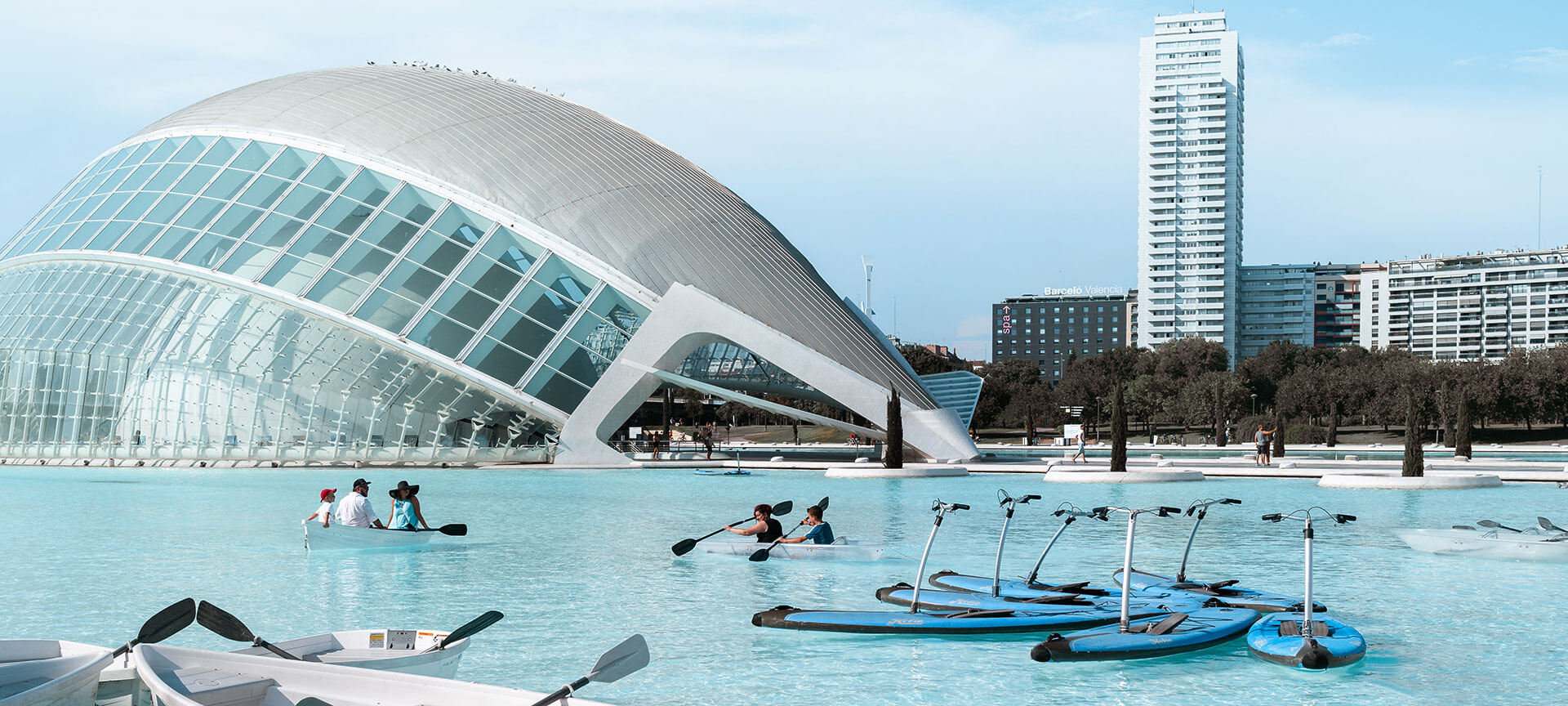
The Mediterranean as a city
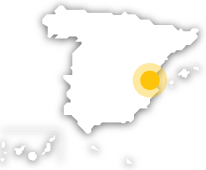
Valencia Institute of Modern Art (IVAM)

Science Museum
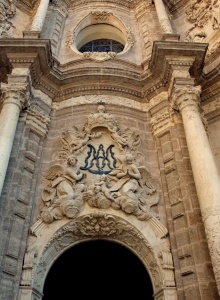
Valencia Cathedral
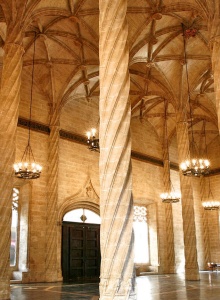
The Silk Exchange
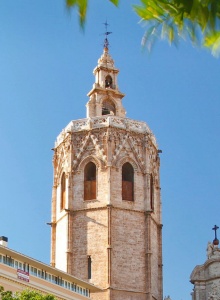
El Miguelete Tower
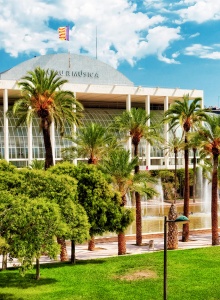
Palau de la Música auditorium
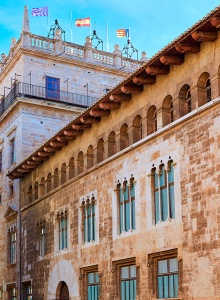
Valencia Regional Government Palace
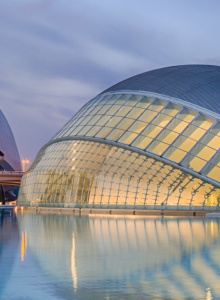
City of Arts and Sciences
Other ideas for your trip
Valencia in two days
If you just have two days to visit this city, we recommend a route taking you to some of its most famous sights.…
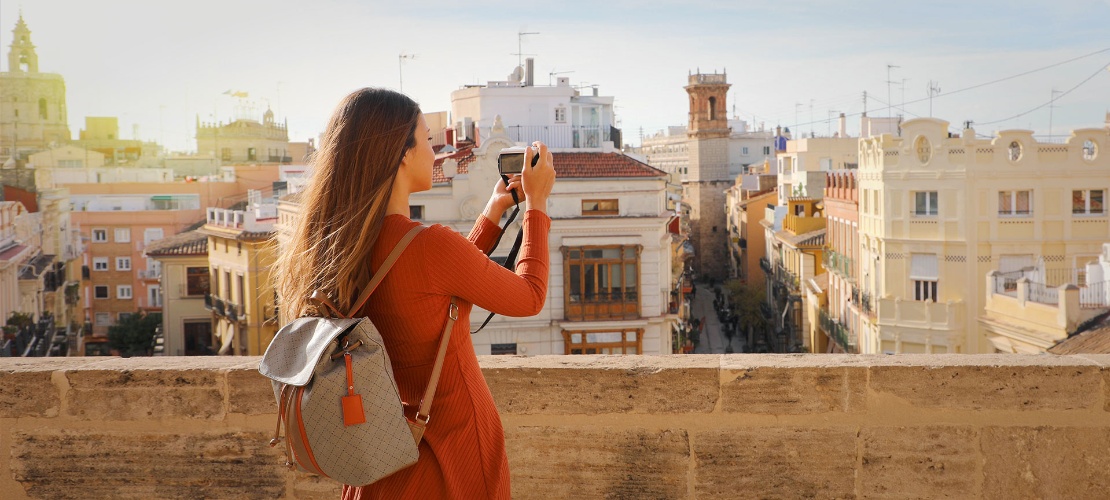
The Silk Route in Valencia
The silk route reveals the importance of silk and its trade to Valencia. The city has Europe’s largest archives relating to silk, and important collections of…
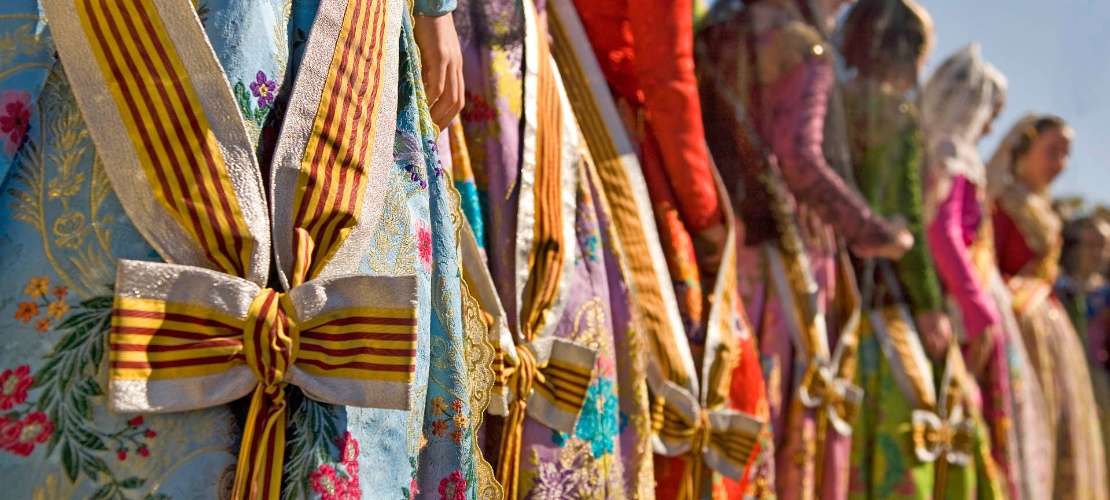
A road trip along Spain’s east coast
A road trip along Spain’s Mediterranean coast is a guarantee of sunshine, lovely beaches, and plenty of destinations with things to see and do.…
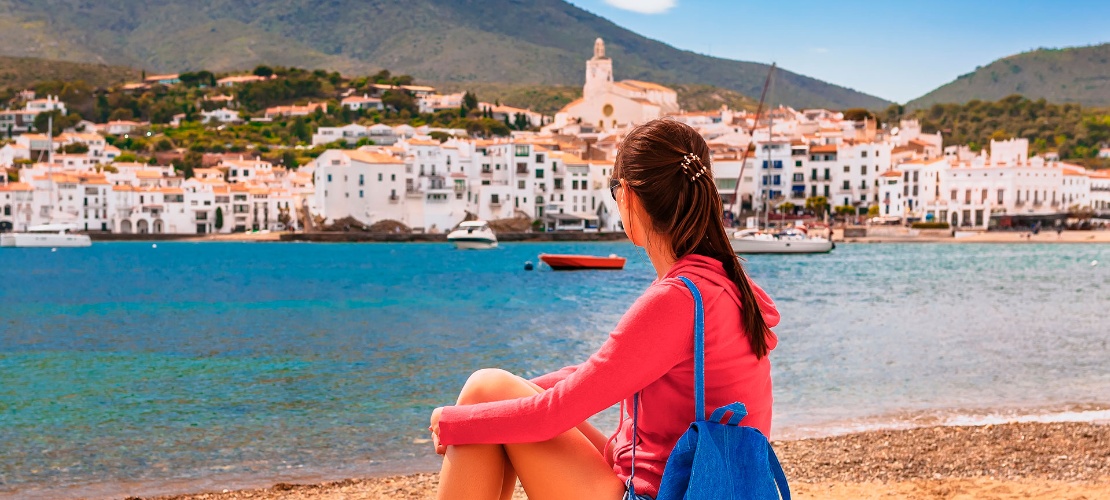
Valencia Marina, plaza of the Mediterranean
The modern seafront of the city of Valencia offers a wide array of activities next to the Mediterranean Sea.…
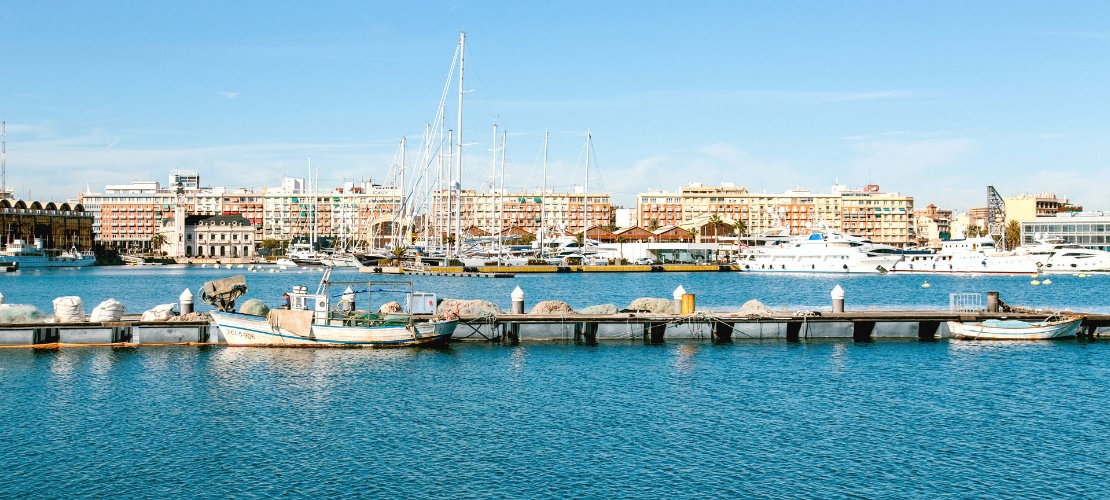
Two weeks in Valencia and the Balearic Islands
If you are thinking of spending your next holiday in Spain and have around 15 days, a great option is to combine Valencia with the Balearic Islands.…
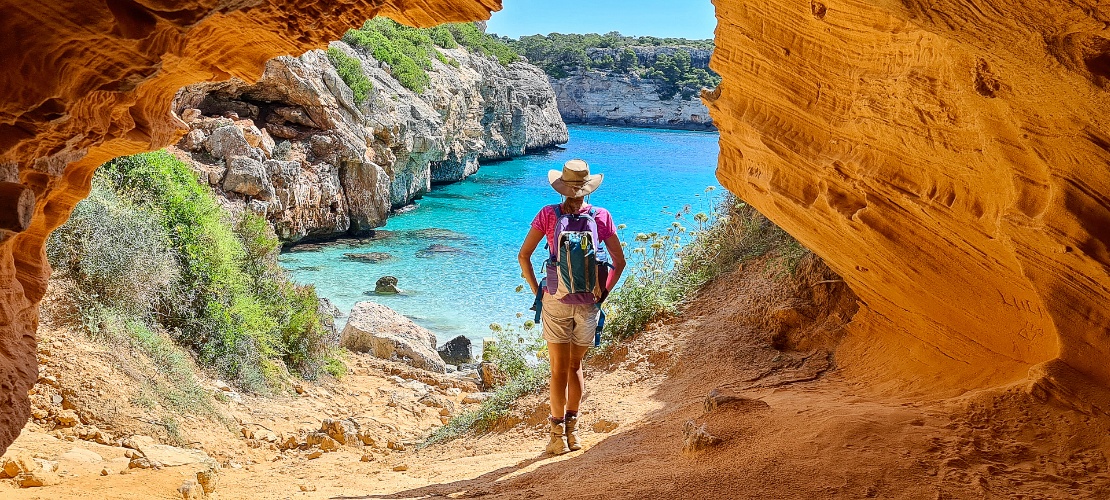
Why Valencia is so much more than a beach destination
When you visit "la terreta" (Valencia's nickname), you will be amazed by what you can do and explore in the capital of the Region of Valencia.…
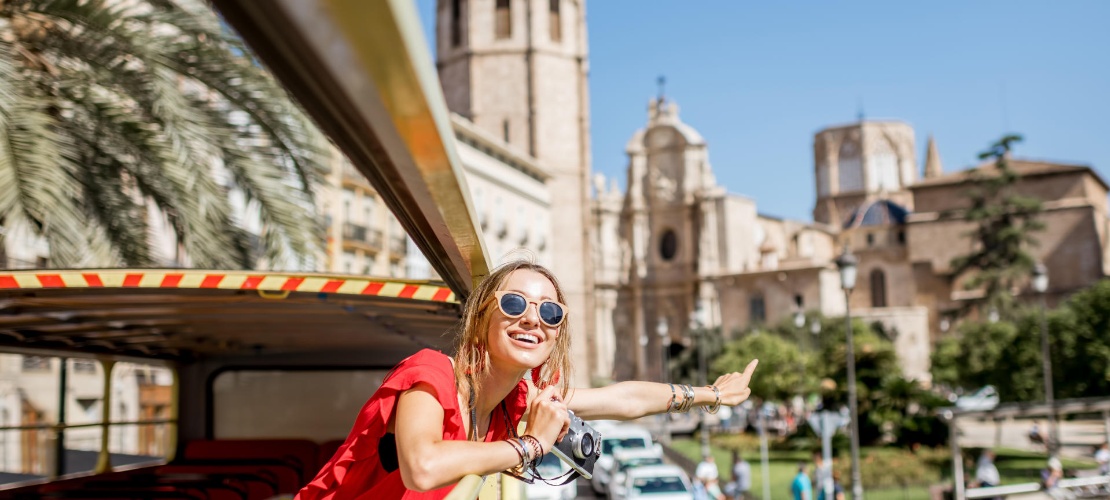
Different ways to explore Valencia
Valencia is a city worth taking time over, exploring every detail and discovering the places you might miss on a first trip.…
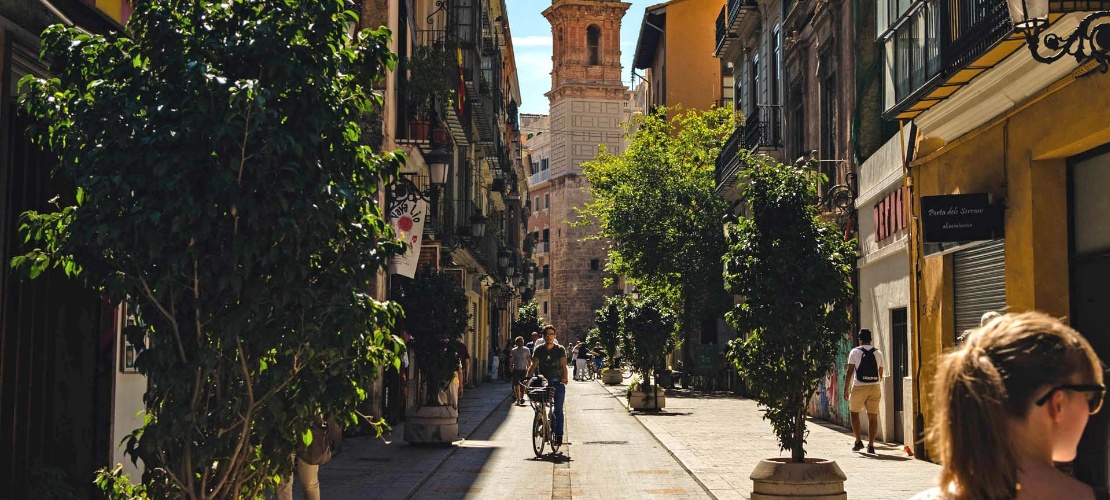
The silk route reveals the importance of silk and its trade to…
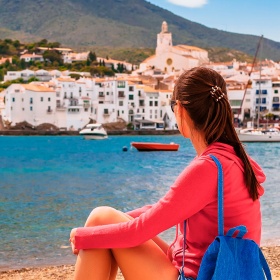
A road trip along Spain’s Mediterranean coast is a guarantee of…
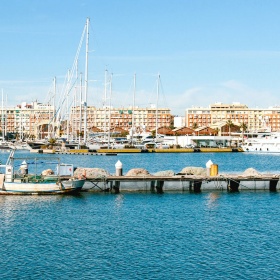
The modern seafront of the city of Valencia offers a wide array…
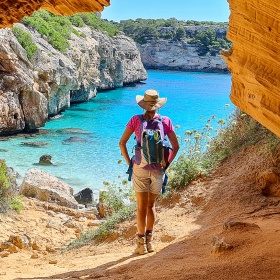
If you are thinking of spending your next holiday in Spain and…
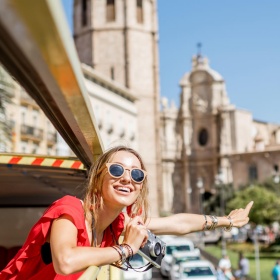
When you visit "la terreta" (Valencia's nickname), you will be…
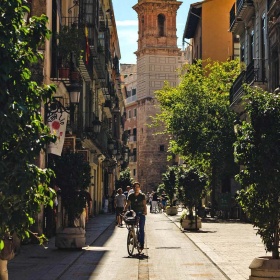
Valencia is a city worth taking time over, exploring every detail…
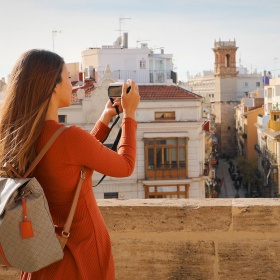
If you just have two days to visit this city, we recommend a…
How to get there - transport information
Select the means of transport to see how to get there or how to get around at your destination.
How to get to aeroplane
The airport is 8 kilometres from the city, about a 15-minute drive on the V-11 motorway.
Metro lines 3 and 5 run between the airport and the city from the metro station on the ground floor of the regional flights terminal. The journey takes around 20 minutes.
City bus 150 takes you into the city centre in about 35 minutes. The bus runs from Monday to Saturday.
More information
How to get to train
Valencia has two main railway stations:
Joaquín Sorolla Station : High-speed AVE trains to Madrid, Cuenca, Seville, and Cordoba, and long-distance Alvia or Euromed trains between Valencia and Barcelona or other cities. There is a free bus service to and from Estación del Norte for travellers arriving by train. You can easily leave the station by public transport: metro lines 1 and 5, bus line 64 and taxi services.
Estación del Norte : This station is mainly for local trains, known as the Cercanías network. You can easily leave the station by public transport: Metro lines 3 and 5, bus lines 5, 6, 7, 8, 10, 11, 14, 15, 19, 32, 35, 40, 63, 70, 71, 73 and 81, and taxi services.
Book your ticket
How to get to boat
The Port of Valencia is about 5 kilometres from the city centre.
Many cruise lines stop here, mostly on routes to and from Italy and France.
There is a free transport service between the cruise terminals and the main terminal.
There are plenty of transport options from the port: bus routes 4 (to the city centre), 95 (to the City of Arts and Sciences) and 95 (to the beach). It also connects with bus line 30.
How to get to bus
Valencia bus and coach station is in a very central location.
The following city bus routes run from the station: 1, 63, 79, 80, 90
Metro line 1 connects to the rest of the metro network.
How to get there by road
The AP-7 motorway links Valencia to Barcelona and Alicante.
The A-3 motorway runs to Madrid.
During 2023, a large part of the city centre will become a Low-Emissions Zone, where driving and parking are restricted. If you plan to visit Valencia by car or motorbike, find out about the possible restrictions before your trip through your accommodation.
Practical information
The main tourist areas can be explored on foot.
Tourist pass: Valencia Tourist Card can be used on the bus, metro and tram for 24, 48 or 72 hours, or you can choose a 7-day option without transport. Free entrance to some museums and monuments and discounts on leisure.
How to get around in metro/tram
The metro network operates from 4 a.m. to 11:30 p.m. during the week. On Fridays, Saturdays and the eve of public holidays, the hours are extended until 3 in the morning.
How to get around in bus
Over 60 routes cover every neighbourhood in the city.
They normally run from 6 a.m. to 10 p.m..
The night bus service begins at 10:00 p.m., at different intervals, on 23 lines (4, 6, 7, 8, 9, 10, 11, 12, 14, 16, 18, 19, 23, 24, 25, 26, 27, 28, 30, 31, 32, 40, 60, 62, 63, 67, 70, 71, 72, 73, 81, 92, 93, 95, 98, 99, C1, C2 and C3).
Take bus routes 24 or 25 or the Albufera Bus Turístic to get to La Albufera Natural Park.
How to get around in other means of transport
Taxi: easily identifiable white vehicles with a red stripe. A green light on the roof shows they are available.
Bicycle: an easy, unusual and sustainable way to get around the city. The city has an extensive cycle lane network. There are many bike rental companies, plus the municipal service Valenbisi.
Excursions to nearby destinations
Castellón de la Plana
The capital of the county of La Plana, situated on the Costa del Azahar, ha...
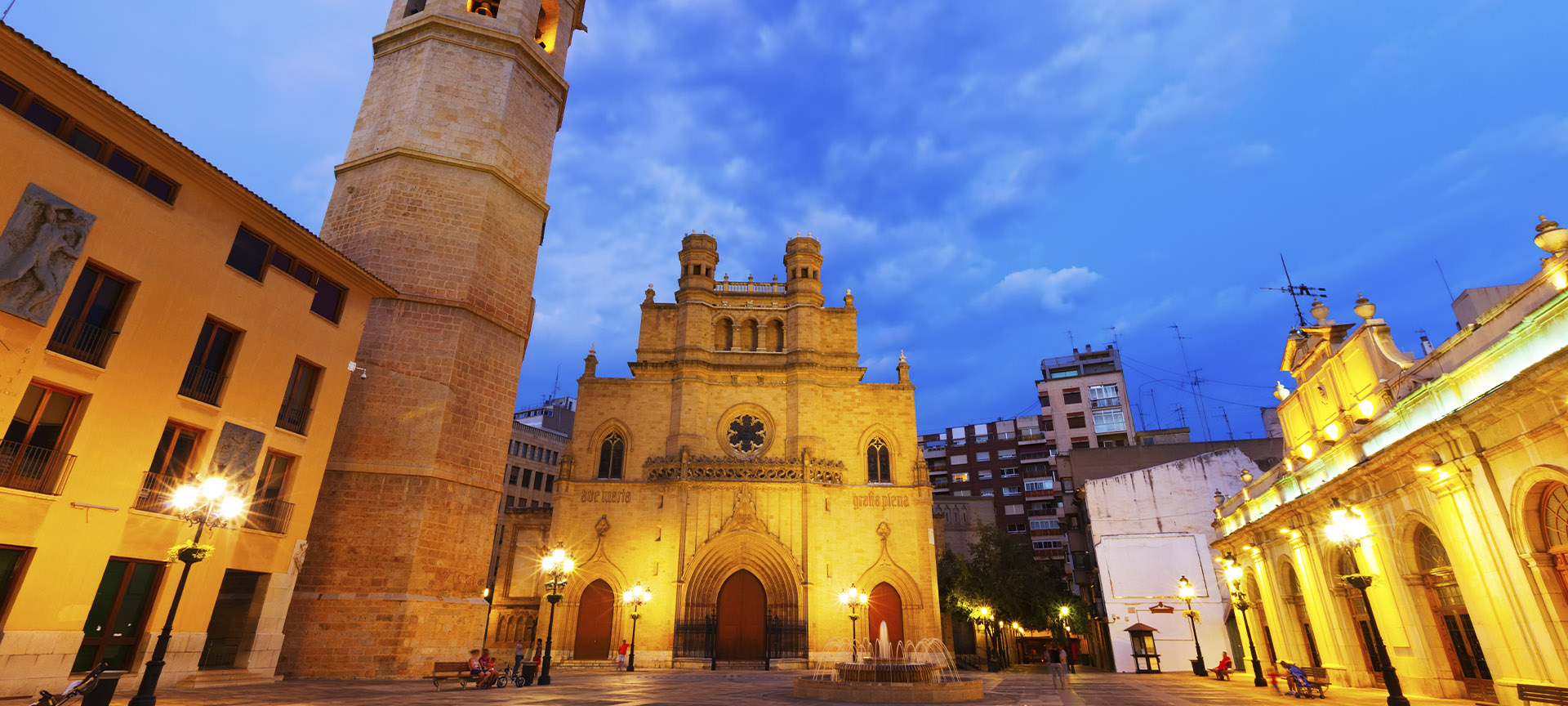
Peñíscola is one of the most popular tourist resorts in the province of Cas...
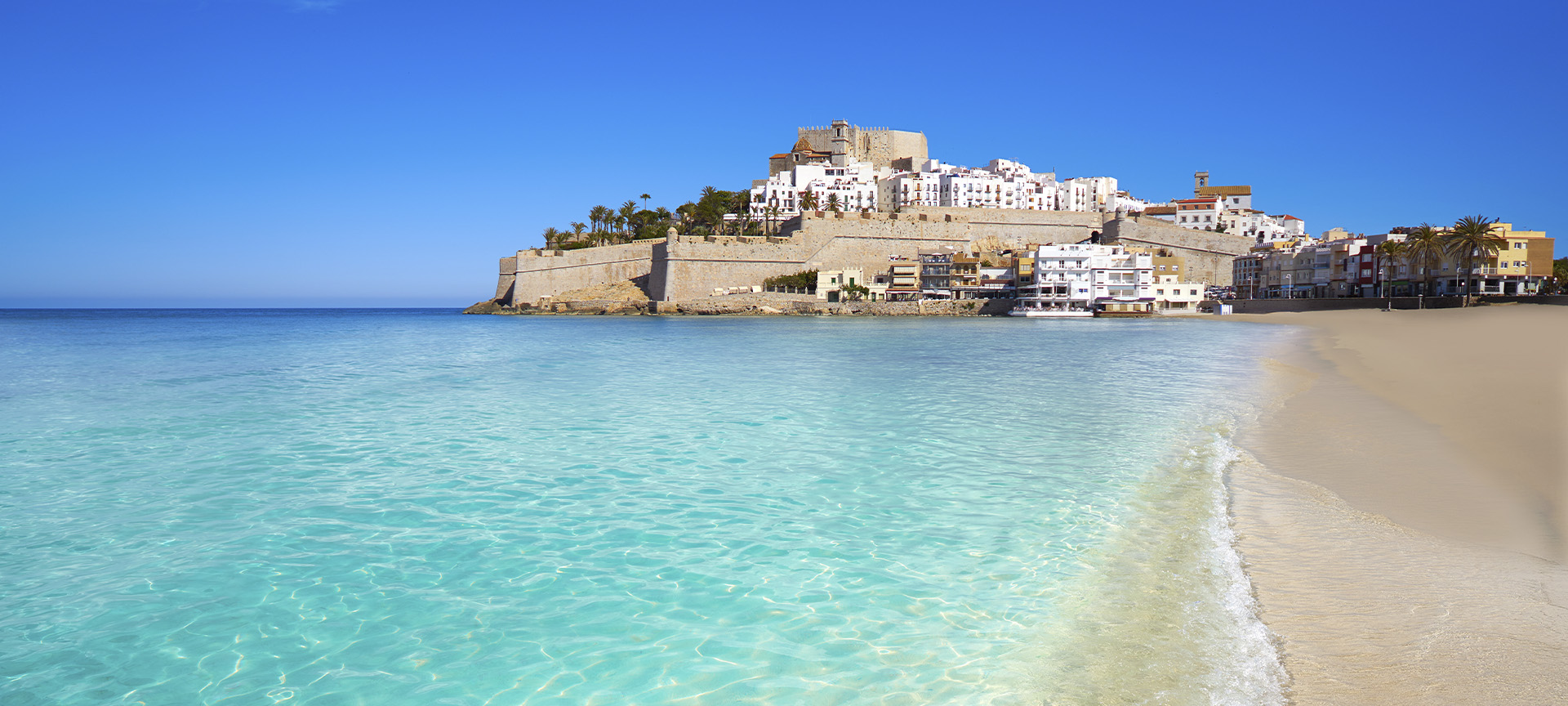
"Arse" for the Iberians, "Saguntum" for the Romans, it still preserves many...
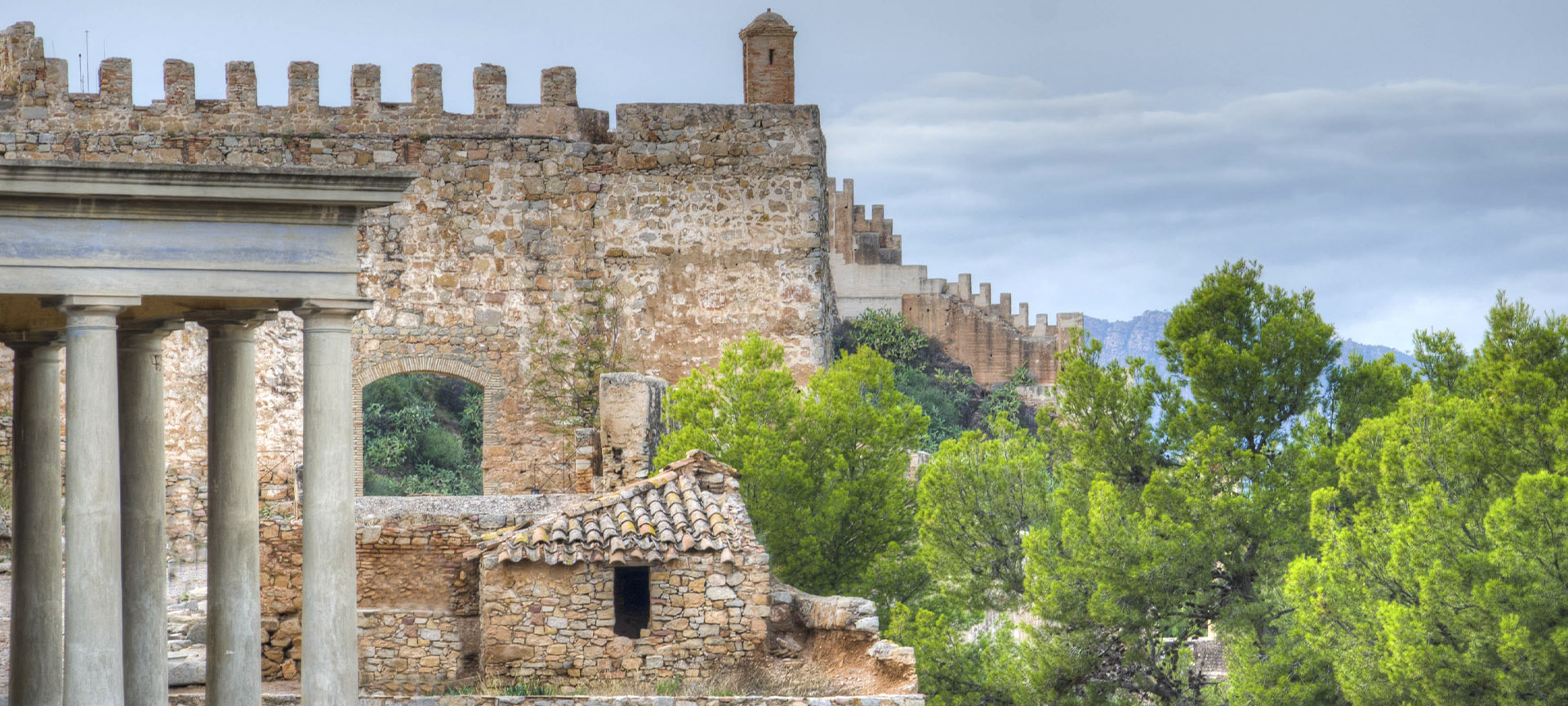
Gandía, capital of the county of La Safor, is set in unusual landscape betw...
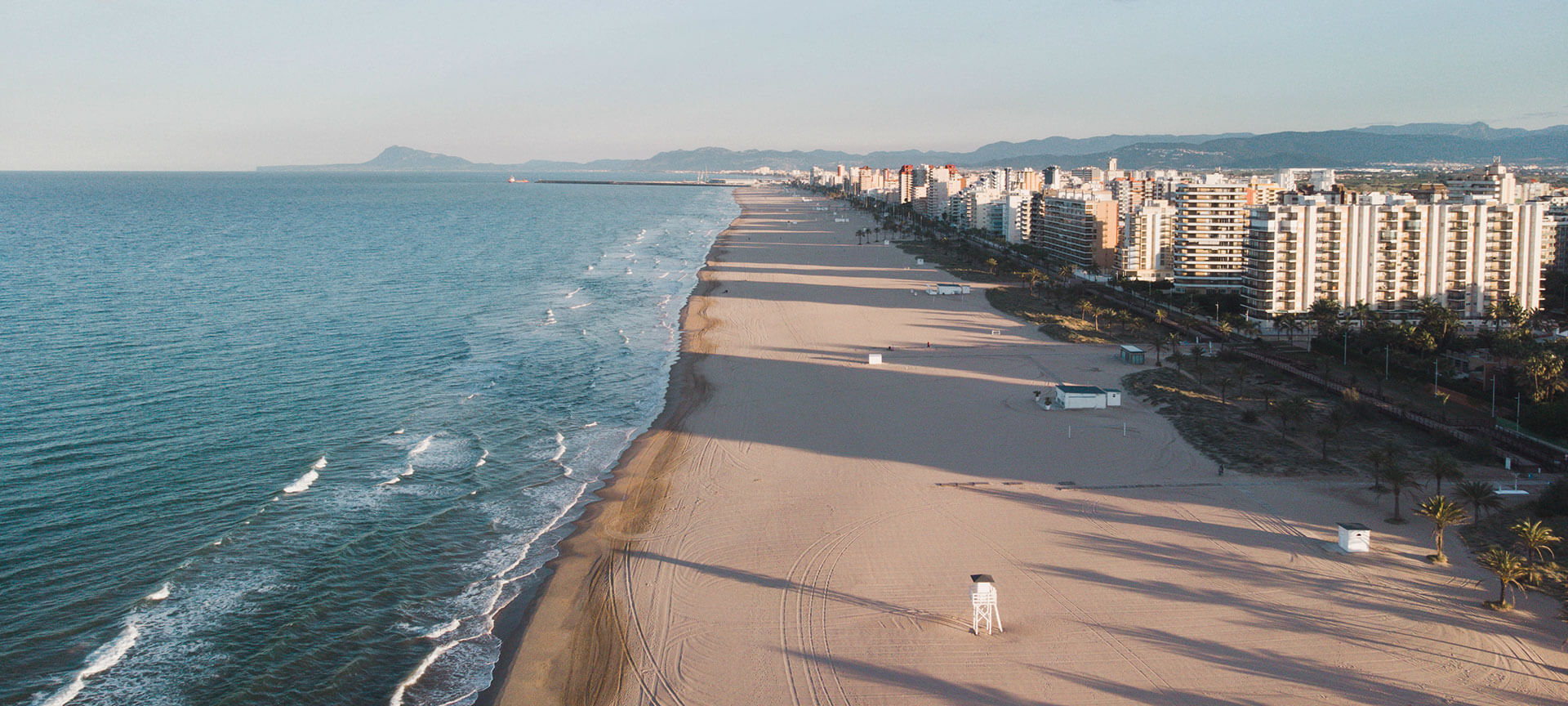
Located in the Marina Baixa region in Alicante, Benidorm is one of the top ...
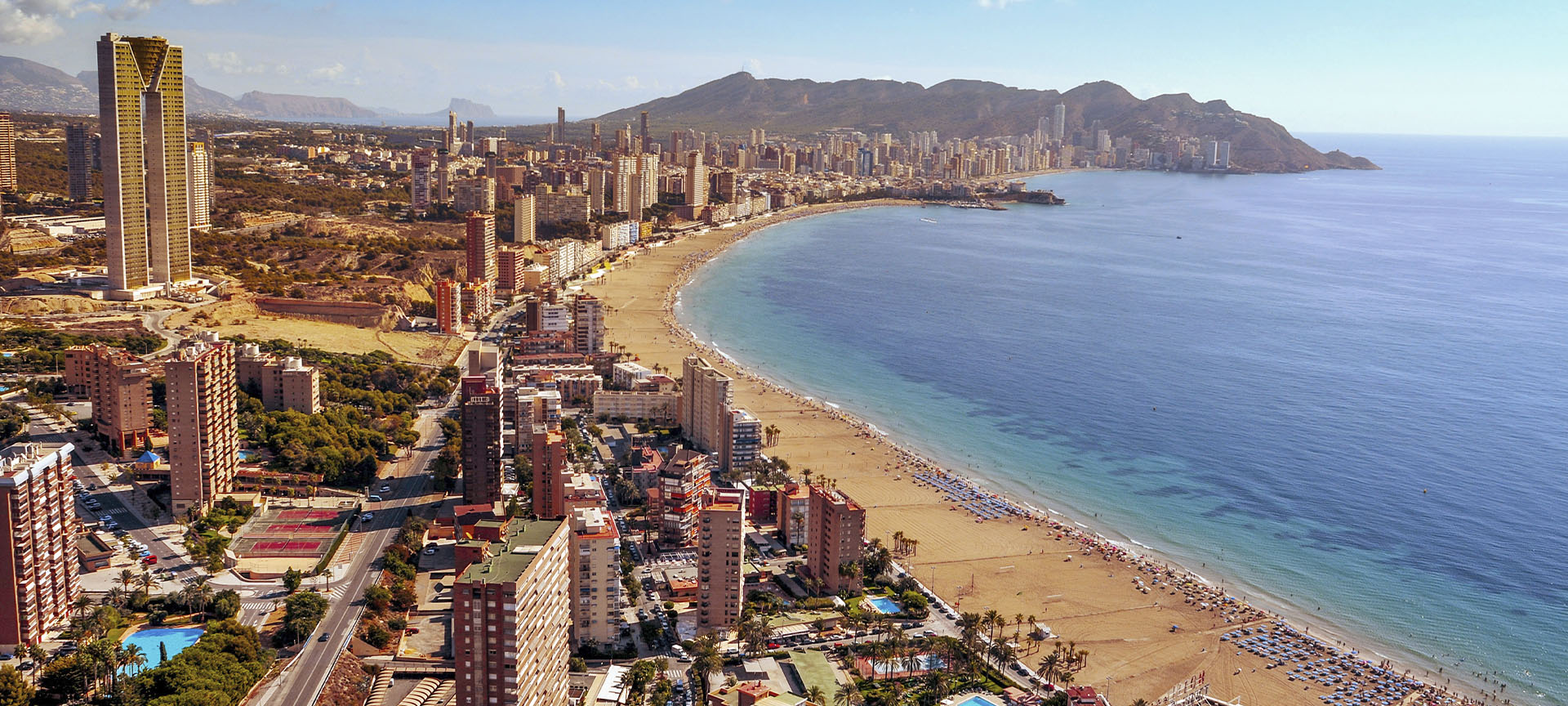
Shows, festivals, sports...
View some of the most relevant events you will be able to enjoy at the destination.

Valencia Cuina Oberta - Restaurant Week
11 April 2024 - 21 April 2024
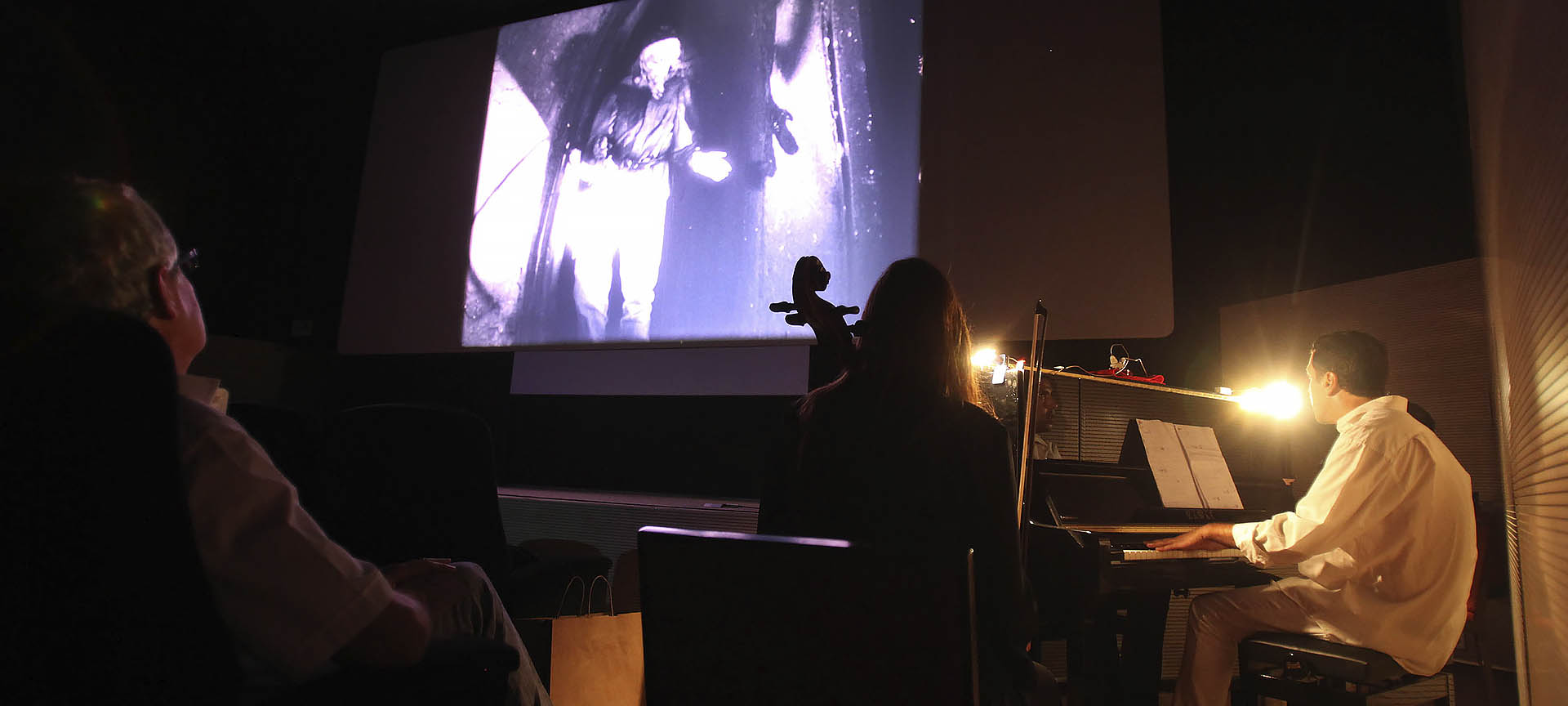
International Youth Film Festival
20 June 2024 - 29 June 2024
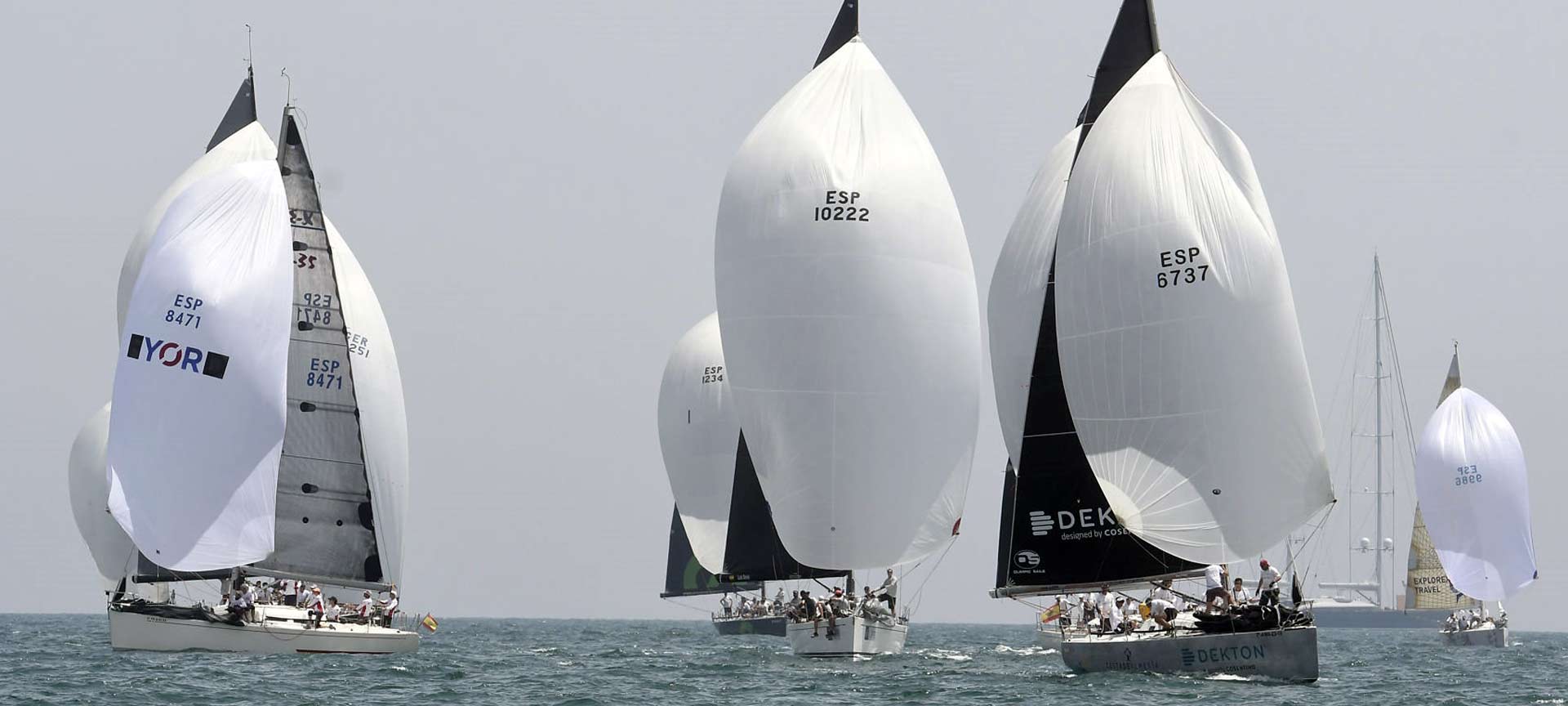
Sailing: S. M. La Reina Trophy
28 June 2024 - 07 July 2024

Choose between thousands of activities to live your best life on holiday.

14 Best Things to do in Valencia (City Trip Guide)
Valencia, the birthplace of Paella and the third-largest city in Spain , is often overlooked and underestimated in favor of its big brother Barcelona . However, it offers much the same in terms of its striking architecture, fantastic food, beautiful parks, and beaches. Not only this, but it comes with a big plus side- far fewer tourists and smaller price tags! Discover the best things to do in Valencia on a city trip.
Day 1 – Ancient Valencia
Welcome to historical Valencia. A city that is split into the old and new city. Spend your first day soaking up the history of the charming old town on foot. Start your morning early to avoid the crowds and make sure to grab yourself a typical Spanish breakfast of ‘tostada con tomate’ to gain energy for your day ahead.
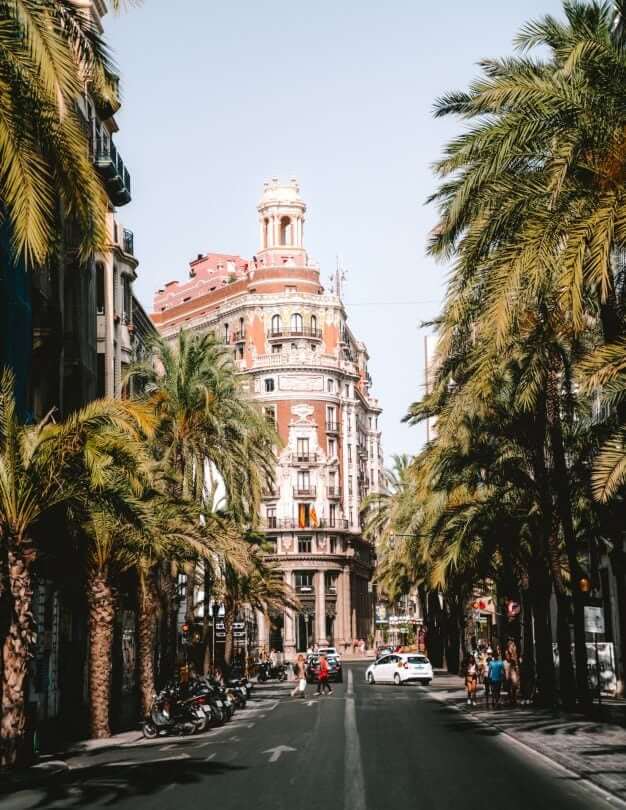
1. Eat Your Way Through the Central Market
Mercado Central, one of the biggest markets in Europe , boasts some of the best local fruits, vegetables, and fish caught that morning. The market ceiling is a huge dome painted with oranges, Valencia’s trademark fruit.
Here are all your hotel options in Valencia.
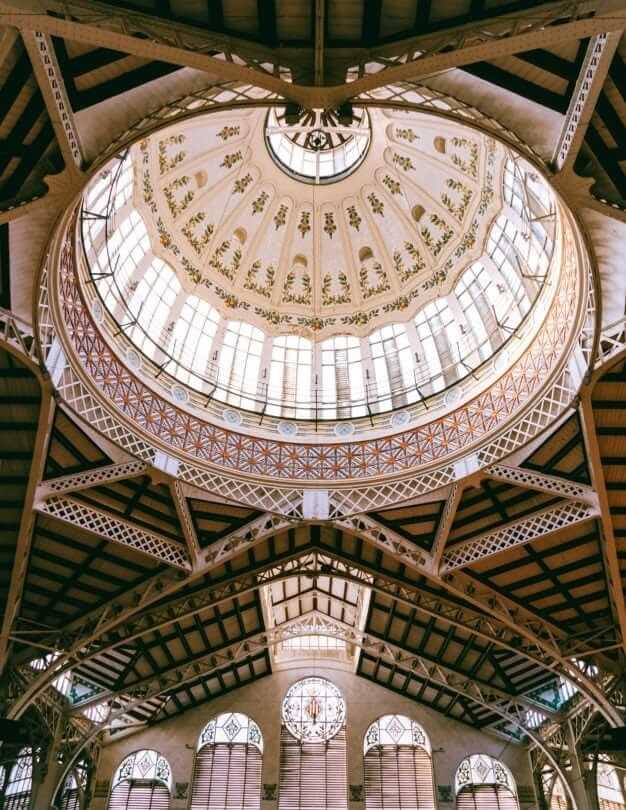
2. Valencia Silk Exchange
After the market, stroll across the road to the old Silk Exchange (La Lonja de la Seda) and buy a ticket for 2 EUR to go inside. Prepare to be blown away by the beautiful stained glass and stone pillars built to look like twisted palm trees. Alternatively, join a guided walking tour of Valencia’s Old Quarter and learn more about its history.
Tip: On Sundays the entrance is free.
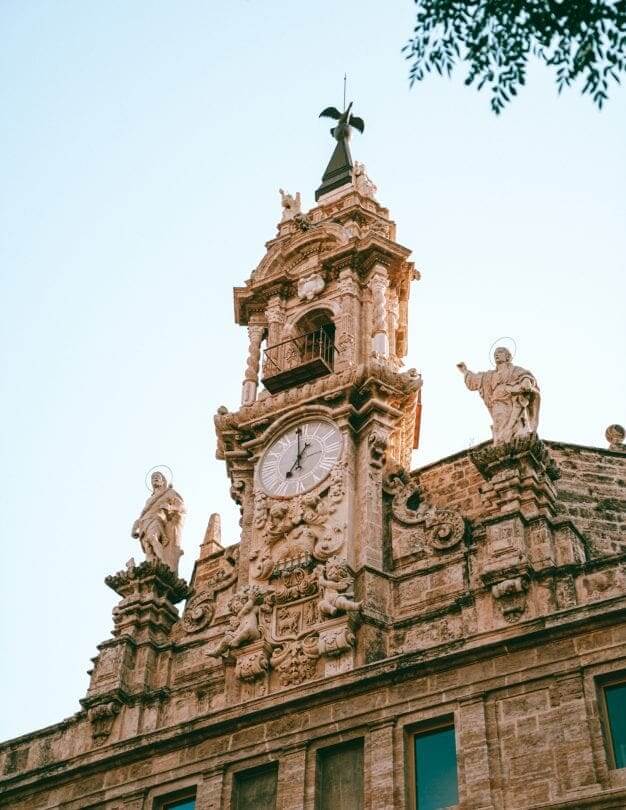
3. Get Lost in the Streets of El Carmen
Valencia was under Moorish rule for hundreds of years, and this Northern African influence is clear to see within El Carmen with narrow roads, water features, and palm trees.
Hotels in Valencia 😴

From the Silk exchange, the heart of El Carmen is only 2 minutes away. Get lost in the back streets and see the contrast between some of the oldest buildings in the city, next to modern and colorful street art- undoubtedly one of the best things to do in Valencia.
To learn more about Valencia’s fascinating history, join a walking , bike , or segway tour. You’ll be led by a knowledgeable guide who can tell you all the secrets of Valencia’s streets. Even better, join a food and history tour where you can stop off at various bars and restaurants to try the local delicacies.
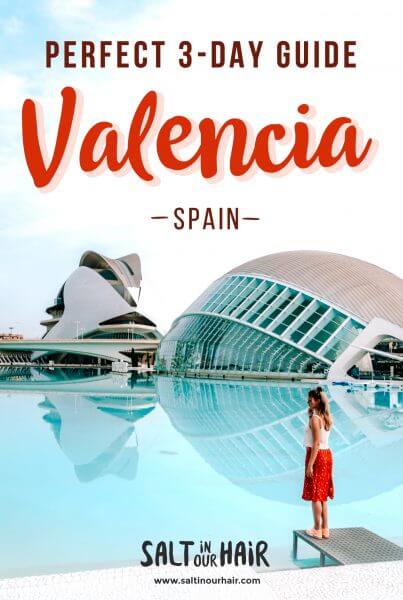
Time for lunch? Saona (Plaza de la Virgen) does an amazing 3-course menu of the day for under 10 EUR. Be sure to book ahead.
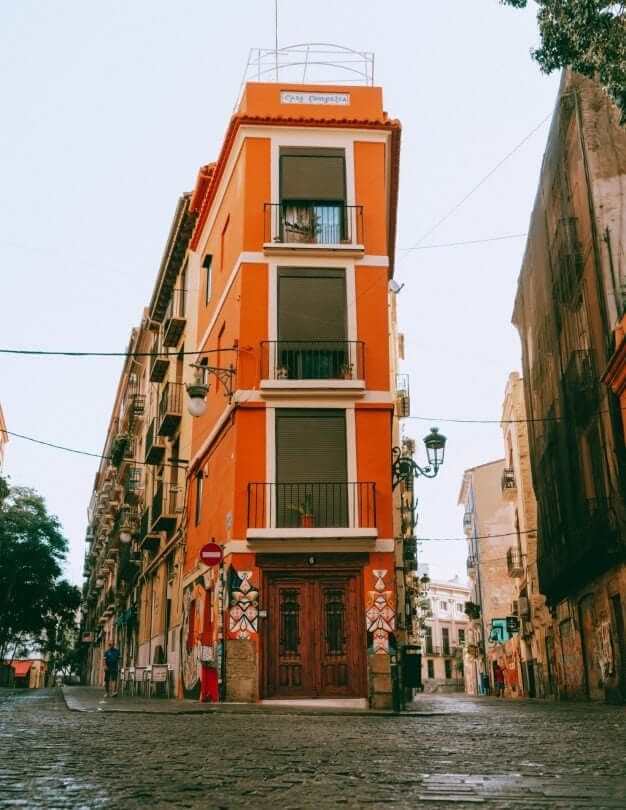
4. Climb the Cathedral
After lunch, make your way to the cathedral of Valencia. El Micalet, the name of the cathedral tower, is a 207 steps climb but one hundred percent worth the beautiful views over Valencia and its many blue-domed rooftops.
Entrance: 2 EUR. If you have an interest in religious history, visit the cathedral on your way down to see the Holy Grail!
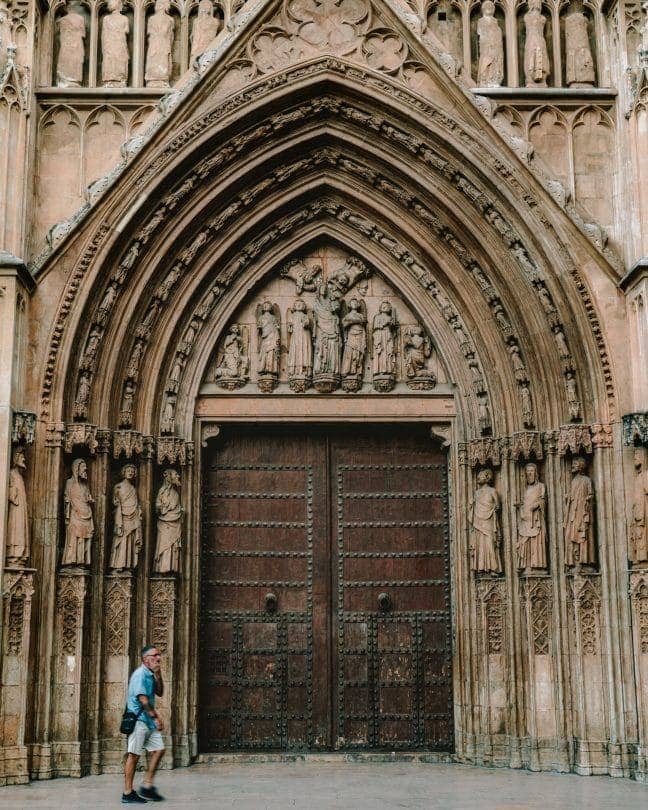
5. Plaza de la Virgen
Once you have finished up at the cathedral, make your way under the Arco de La Calle de la Barchilla and around the cathedral to Plaza de la Virgen. At night the square really comes alive and is filled with people from circus performers to musicians. For dinner, get a delicious pasta around the corner at La Papardella.
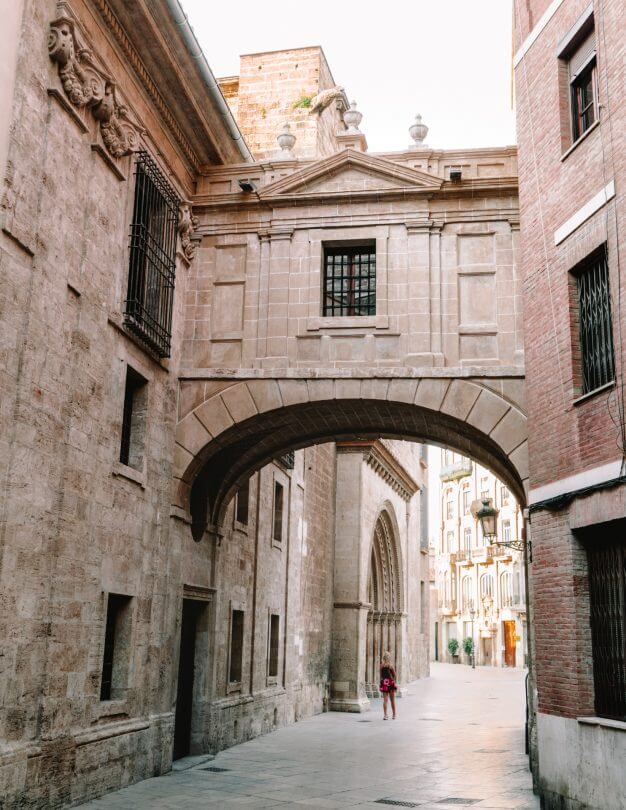
Day 2 – Futuristic Valencia, Spain
The new City of Arts and Sciences is one of the most popular things to do in Valencia. Spend day 2 of your trip exploring the park and new city by bike.
Join a guided bike tour exploring the City of Arts and Sciences
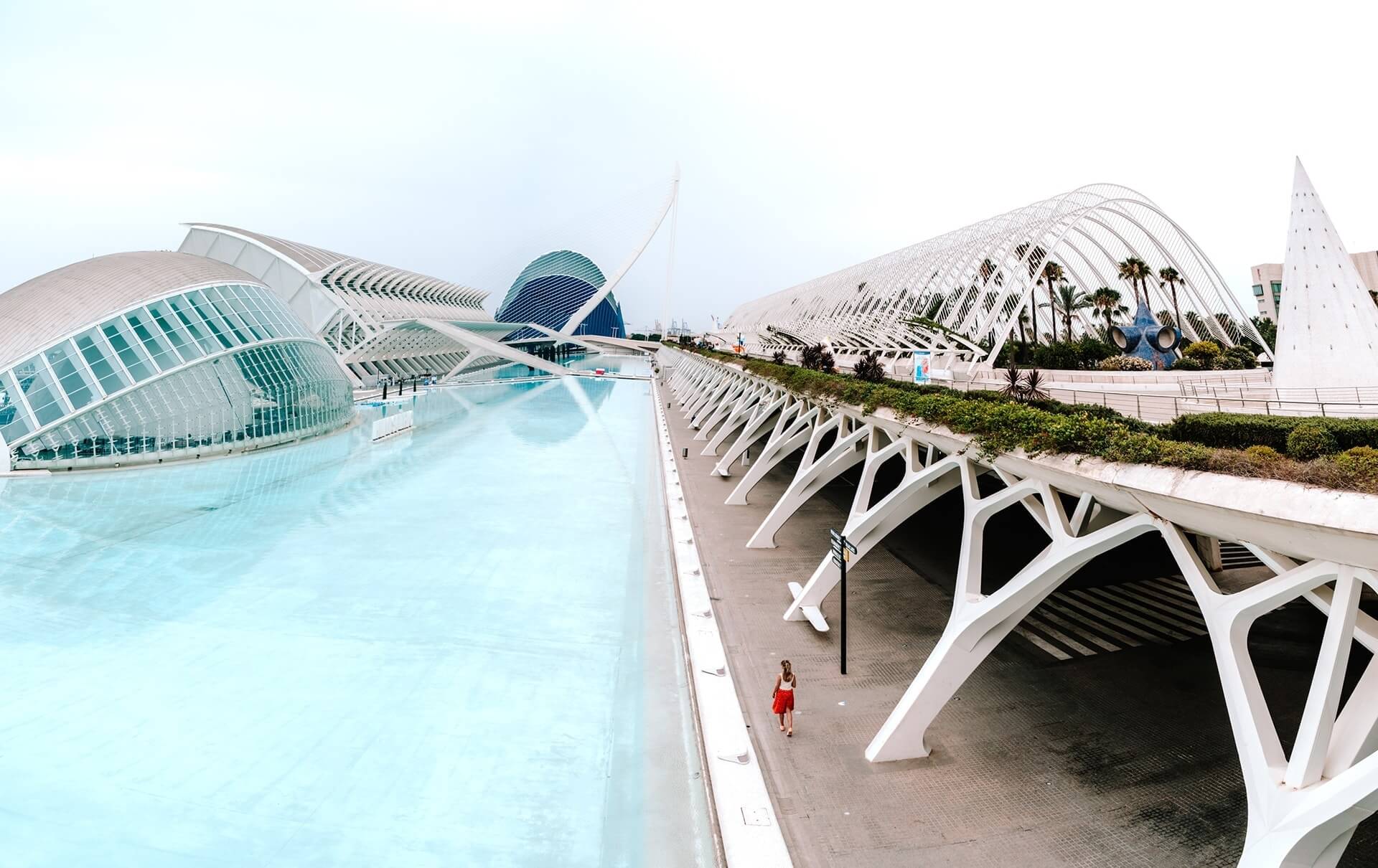
6. Cycle Through the ‘River’
Start your day by hiring a bike and cycling through the incredible 7 km long park, which winds around the city, admiring its many orange trees, palm trees, and water features. This used to be the River Turia, but as it was so prone to flooding, the river was redirected, and the area was turned into a green space for the people of Valencia.
Tip: Make sure to cross over the Pont de las Flores when arriving into the park from the city center, a beautiful bridge made up entirely of pink flowers.
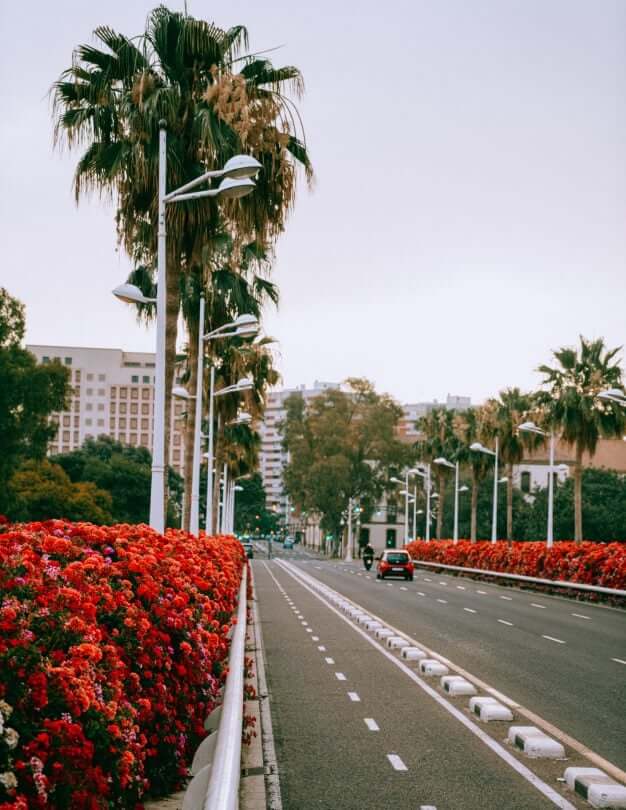
7. The City of Arts and Sciences – Unique thing to do in Valencia
At the south end of the park, you will find the ‘new city’ of Valencia. This extremely futuristic complex was designed by Valencian-born architect Santiago Calatrava and was only finished in 2005. Initially budgeted at 300 million euros, it is estimated to have cost three times the amount!
Get your entrance tickets here
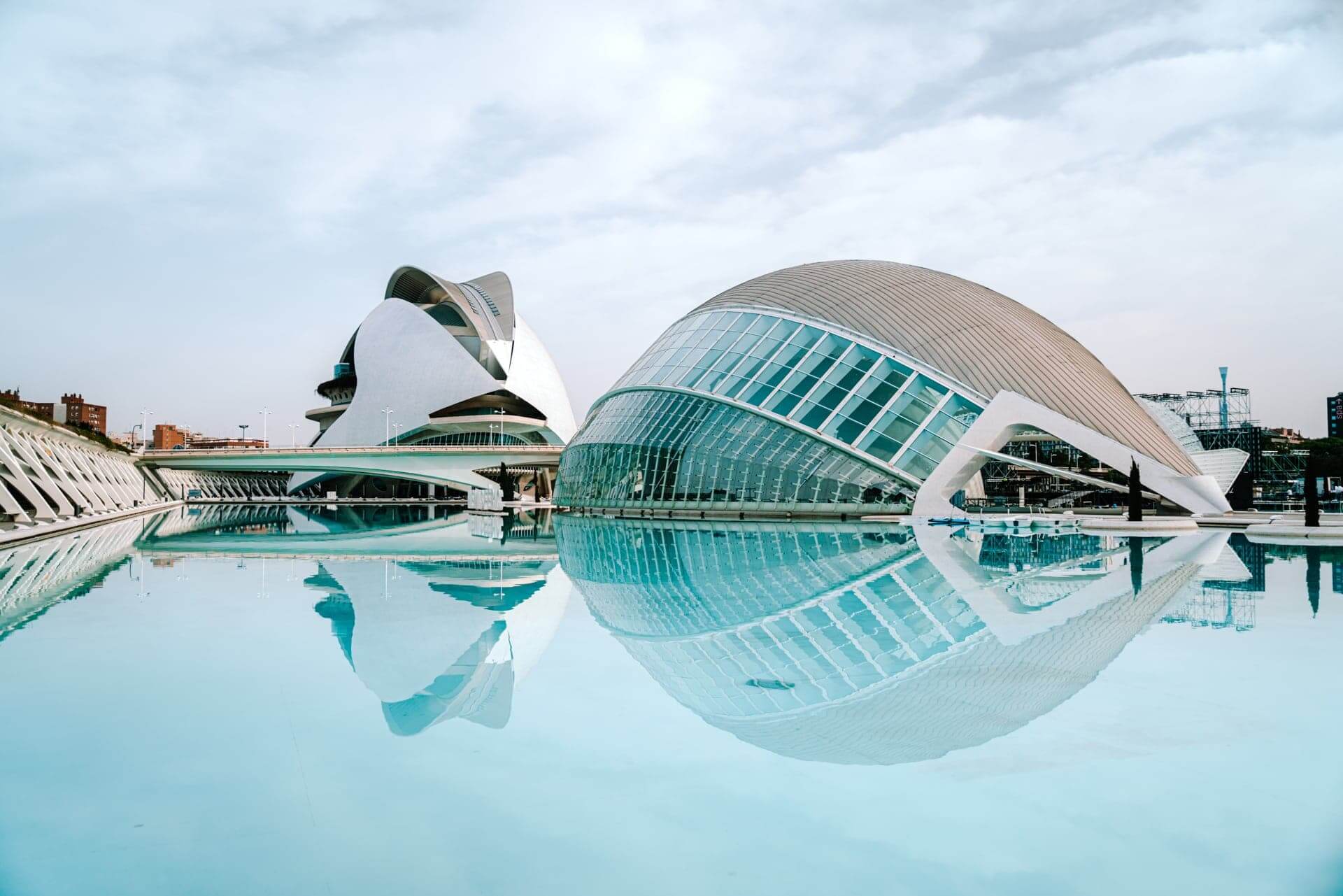
Admire the eyeball of ‘La Hemisferic’, the shell of ‘La Palau de la Reina Sofia’, and the whale skeleton of The Science Museum. During the summer months, kayak or paddleboard in the water that surrounds the buildings.
Did you know? Valencia is also home to Europe’s largest aquarium, which is situated next to the city of arts and sciences. You can even enjoy an ‘underwater’ dinner experience here, where you dine among sea life.
Get your tickets for the aquarium here
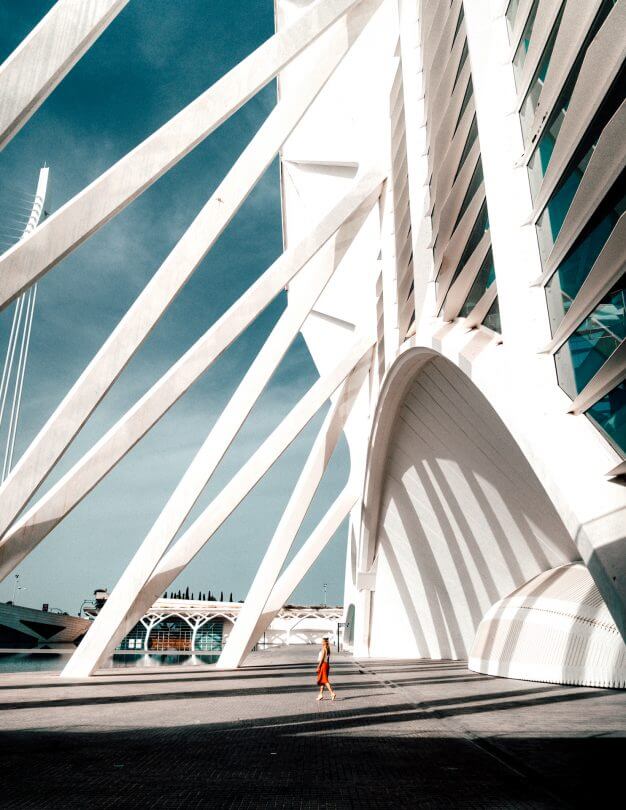
8. Trendy Rusafa
Make your way back to the city center via the neighborhood of Rusafa, one of Valencia’s coolest and most up-and-coming areas. Shop at one of the many vintage clothing stores and grab a healthy lunch at Bluebell Cafe or Artysana.
9. Palau Marques de Dos Aguas
On your journey back from Rusafa, make one last stop at the impressive marble mansion ‘Palau de Marques de Dos Aguas’, a symbol of Valencian wealth which is now a ceramic museum. This is arguably one of the most outstanding buildings to see in Valencia.
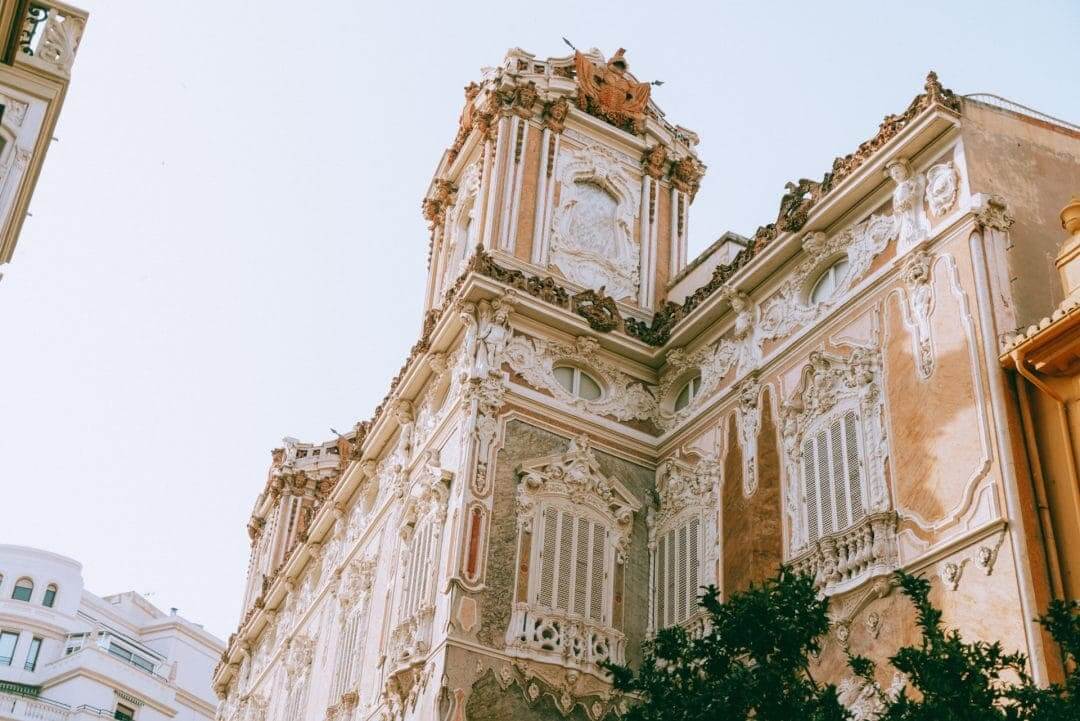
10. See a Flamenco show
Although Andalucia is the home of flamenco, Valencia still does a great job of showcasing this traditional Spanish dance. See a late-night show at Cafe del Duende for only 12 EUR including a drink.
Get tickets for a Flamenco show
Hungry? Around the corner from Cafe del Duende is La Greta, serving some of the best tapas in town. Go before the show and order the Patatas Bravas.
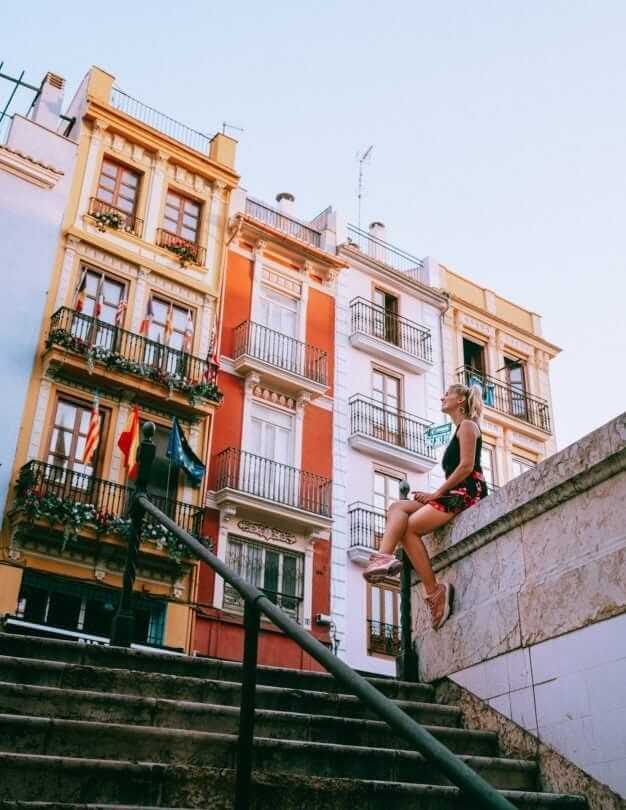
Day 3 – Eat, Beach, and Repeat in Valencia
After two beautiful days of sightseeing, take your last day to relax and enjoy the best things to do by the sea in Valencia.
11. Colorful Streets of Cabanyal
On your way to the beach, do not miss the colorful houses of Cabanyal, which feel more reminiscent of Cuba than Spain . If you are in Valencia for more than three days, continue cycling to the colorful harbor of Port Saplaya, which has been coined as Valencia’s own ‘little Venice ’.
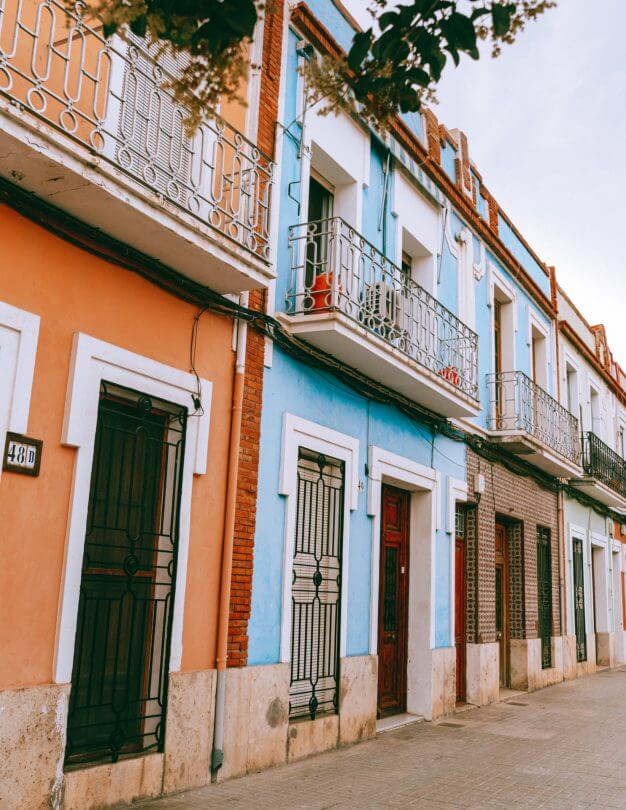
Getting there – From the city center, take the metro to Maritim Serreria and then the tram the rest of the way OR take the tram from Pont de Fusta, depending on where you are located. Even better, cycle! The city is extremely bike-friendly, with bike paths almost everywhere.
12. Relax on Valencia beach
Valencia’s beach lies just beyond Cabanyal, a long stretch of white sand lined with palm trees. At the closest end, you have Malvarossa, but if you have the energy, it is worth going a little further down to Patacona, which has lots of great beach bars and delicious places to eat.
Tip: Grab brunch at La Mas Bonita for great beach vibes!
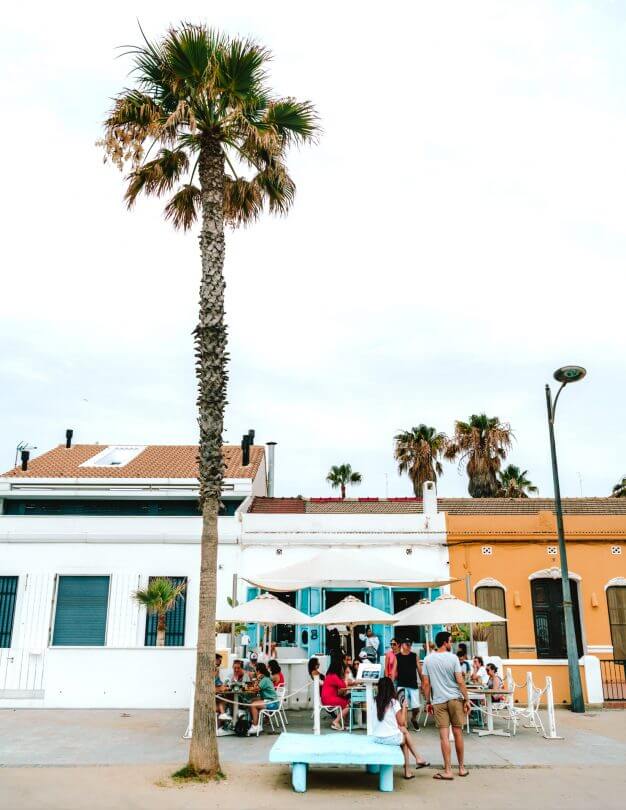
13. The Old Gates of Valencia
Take the tram back to Pont de Fusta, where you can walk across the bridge to the Serrano Towers, one of the only remaining gates that used to surround the city. Climb to the top for views of the mountains surrounding Valencia.
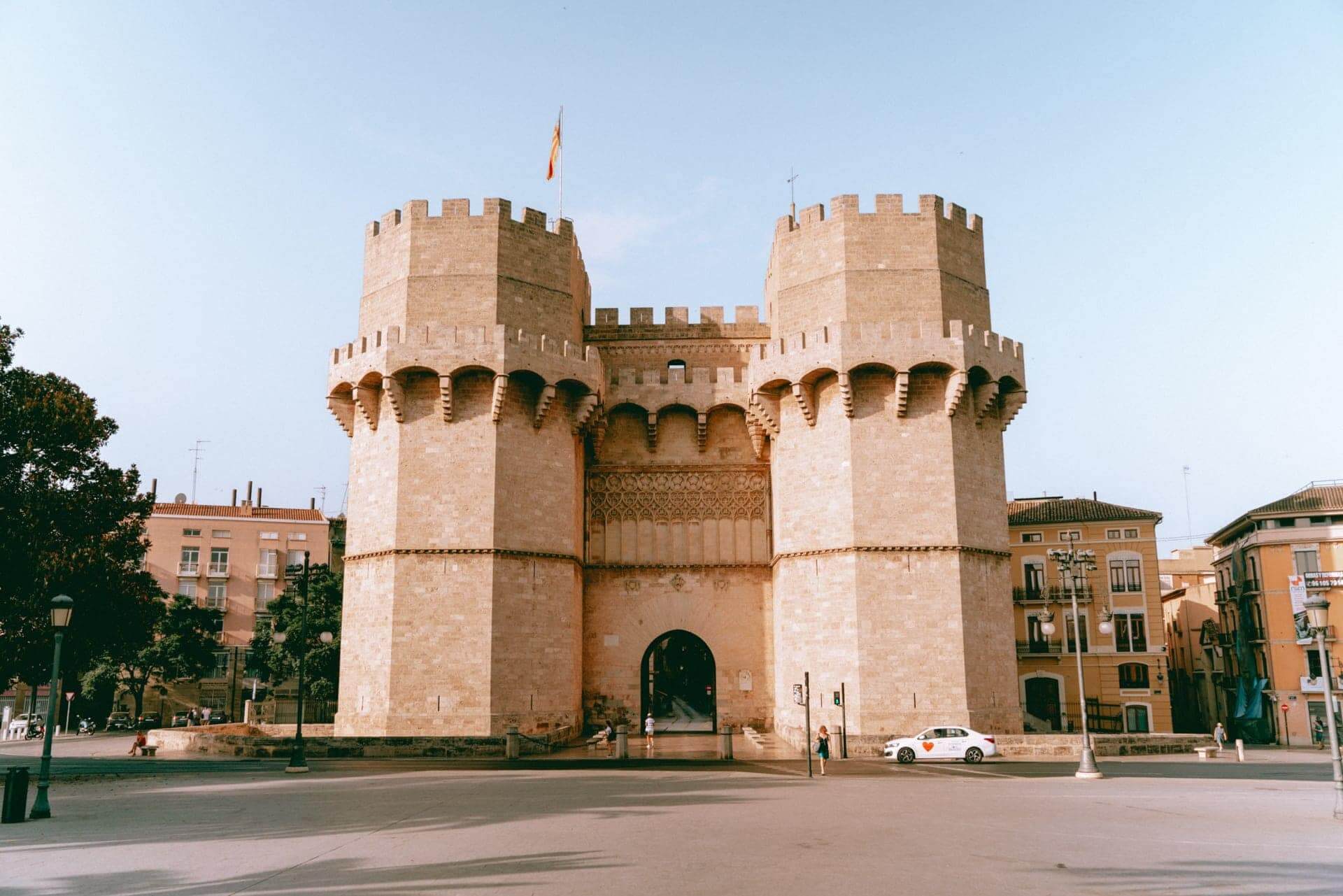
14. Valencia Rooftop Sunset
Finish your Valencia city trip in the main city square, ‘Plaza Ayuntamiento’. Here you will find a rooftop bar where you can see spectacular views over the city during sunset.
How Much Does Valencia Cost?
Although Valencia is the third largest city in Spain, it’s considerably cheaper than other destinations like Madrid or Barcelona. You can eat in delicious restaurants for next to nothing, especially at lunch when a ‘Menu del Dia’ can cost as little as 8 EUR for 3 courses.
Costs of Traveling in Valencia
Travel on a budget in Valencia, from $320 − $350 USD weekly per person, mid-range $710 − $1710 USD, and high-end from $1630 − $2480 USD. However, costs depend on factors like accommodation, transportation, and activities. We did not include flights. Check flight prices here
- Hotels: $60 − $200 USD Check available hotels
- Hostels: $20 − $40 USD Check available hostels
- Transport: $5 − $10 USD Book public transport
- Car Rental: $30 − $100 USD Book a rental car
- Food: $15 − $40 USD
- Activities: $3 − $5 USD See tickets & tours
- Sim: $1 − $3 USD Get an eSIM or SIM here
- Travel Insurance: $2 − $6 USD Get Travel Insurance
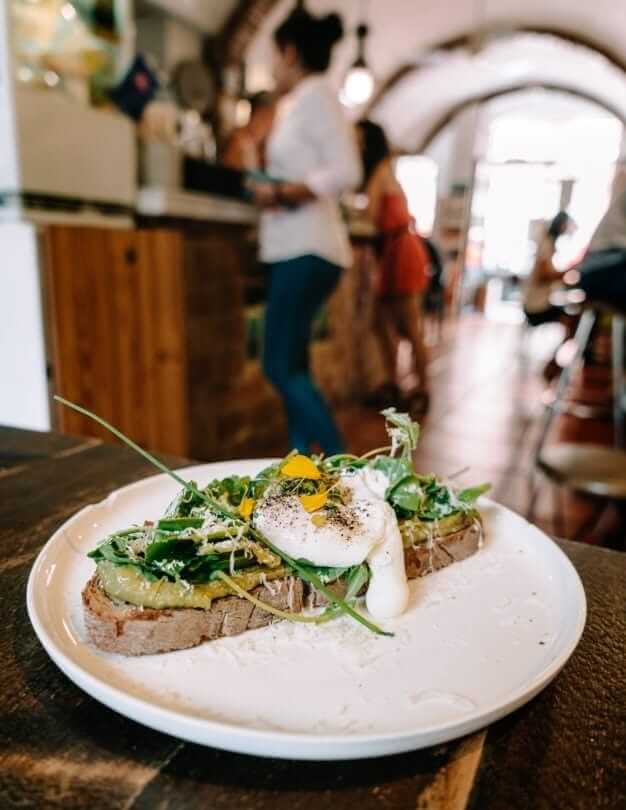
How to Visit Valencia
Valencia has a fairly big airport with flights leaving to destinations all over Europe . If your city doesn’t offer flights to Valencia, consider flying into Barcelona or Madrid and taking a direct train from there.
The city is easily accessible from the airport. Simply walk downstairs to the metro from the terminal, and any line will take you to the main city stops, such as ‘Xativa’ or ‘Colon’, in around 20 minutes. Price: 4.90 EUR.
Getting Around
Valencia is a small and walkable city. If you choose to hire bikes, you may not need to take public transport at all! However, there is a very affordable tram and metro with many stops throughout the city and down to the beach. The price for a 10-trip ticket is between 7.60 – 21 EUR, depending on which zones you need.
We recommend to rent a car in Spain through Sunny Cars with free cancellation and insurance included. Book your rental car here .
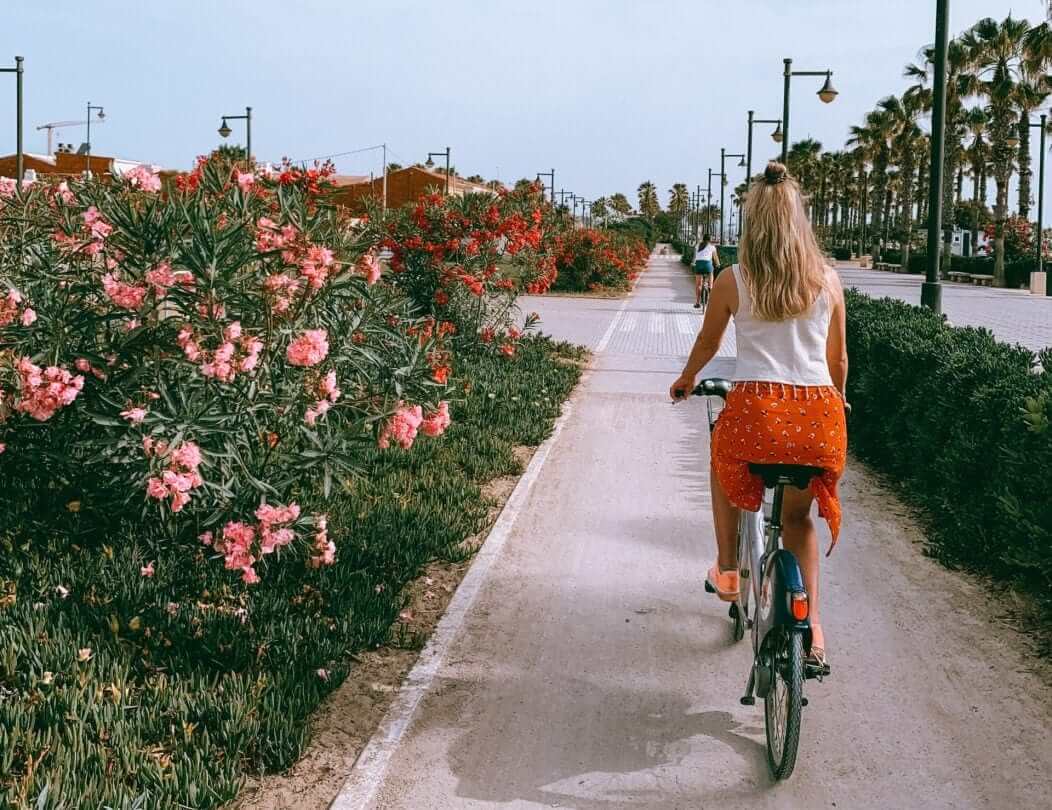
Where to Stay in Valencia
Accommodation in Valencia is reasonably affordable. Aim to stay in the city center, near to the old town or Rusafa, for easy access to the key sights.
For a more affordable option, stay a little outside of the center on the metro line for easy access to the city. Alternatively, find a hostel down by the beach.
Best Time to Visit Valencia
The best time to visit is out of the prime summer months when the weather is cooler, and it’s more pleasant to walk around and see all the things to do in Valencia.
During the winter months of December- February, the days are sunny, and the temperature is between 15-20 degrees. If you’re visiting during the summer months of June-September, expect highs of up to 40 degrees!
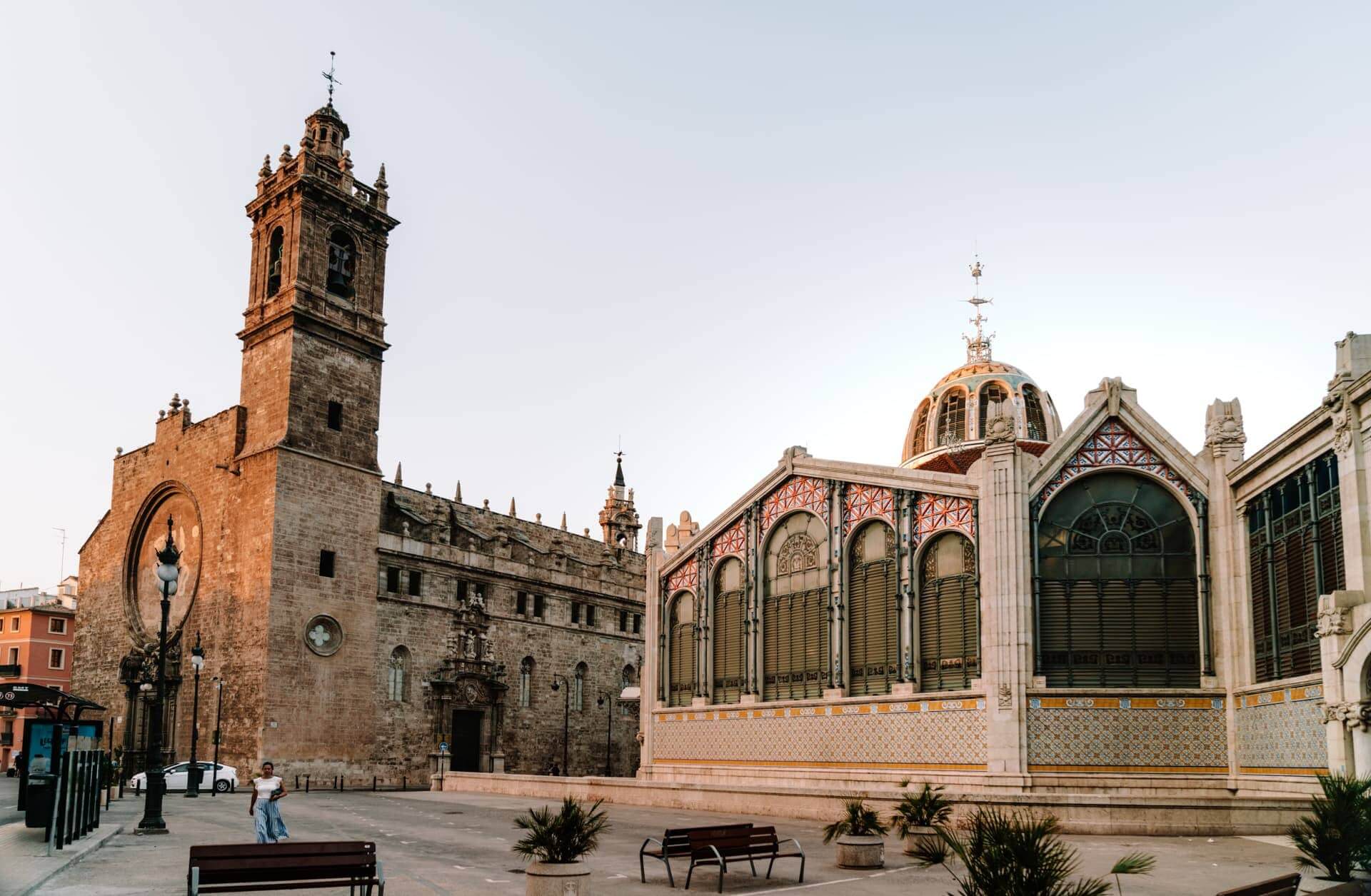
Extra: Experience ‘Las Fallas’ in March, a unique month-long festival that centers around the dates 15-19, where each district creates a giant sculpture, which is burned on the last night. Expect a lot of noise, fireworks, and street parties lasting until the early hours of the morning.
By purchasing through our links, you support us at no additional cost. Thank you for your support. ♥️
- Find Hotels via Booking.com
- Find a Rental Car via Sunny Cars
- Find Flights to Valencia via Skyscanner
- Get a Travel Insurance via Heymondo
- Book Tours & Attractions via GetYourGuide
- Book a Bus/Train/Transfer via 12Go
Seville, Spain: 14 Best Things to do
Best things to do in madrid, spain, best things to do in barcelona (travel guide).
Looking for more travel information? Plan a chat with us for personalised travel advice or get an answer from the Salt in our Hair Travel Community on Facebook.
I Love Valencia visited the city some time ago. I Love horchata also. Valencia is a lovely city
Incredibly extensive post. The city is expanding the metro and opening up more areas to visit by the water in the coming years too.
Your email address will not be published. Required fields are marked *
Notify me when new comments are added.
Valencia Travel Guide
Courtesy of Sergio Formoso | Getty Images

26 Best Things to Do in Valencia, Spain
Valencia's three beaches feature soft golden sand and spectacular views of the Mediterranean. Visitors who enjoy exploring outdoors can spend their days strolling dozens of gardens, parks and plazas located within the city or hiking the trails of
- All Things To Do

Central Market (Mercado Central) Central Market (Mercado Central) free
This is where local Valencians gather to do their shopping, though you'll find the atmosphere a bit different than your local supermarket. One of the oldest food markets in Europe, Mercado Central (Central Market) is adorned with Valencian-style mosaics and filled with residents purchasing local foods from more than 1,200 trusted vendors selling everything from meat and vegetables to pastries and take-away items. Spanning more than 86,000 square feet, the building occupies land once used as an open-air market in the mid-19th century. Opened in 1928, the visually stunning building sits in the El Mercat neighborhood, opposite two other architecturally significant monuments: La Lonja de la Seda and Los Santos Juanes Church.
Recent visitors were invariably impressed by the expansive range of food and beverages on offer here, with some describing the market as a "foodie paradise." Reviewers recommended stopping by, even if you don't plan on purchasing anything, though they do warn that prices are high because vendors recognize this is such a tourist magnet.

City of Arts and Sciences (Ciutat de les Arts y les Ciencies) City of Arts and Sciences (Ciutat de les Arts y les Ciencies)
The Ciutat de les Arts y las Ciències (also known as the City of Arts and Sciences) is a traveler favorite for its futuristic design. Built on the old riverbed of the Turia River, the museum's contemporary architecture (by Santiago Calatrava) shelters the Museu de les Ciències (a science museum), the Hemisfèric (a planetarium and IMAX theater), the Oceanogràfic – the largest aquarium in Europe – and the Palau de les Arts Reina Sofía (a performing arts venue), among other attractions.
Past travelers raved about the complex's myriad offerings, and suggested you wear comfortable shoes; the attraction is so massive (about 452,000 square feet), you'll be doing a lot of walking. Reviewers recommended setting aside an afternoon or even two to three days to see the entire complex. Travelers praise the science museum for its hands-on exhibits and the aquarium for its stunning design.

Turia Gardens (Jardi del Turia) Turia Gardens (Jardi del Turia) free
The Jardí del Túria (or the Garden of the Turia) might seem odd to newcomers, seeing as how it boasts more than a dozen bridges built to span a river that's no longer there. One of the country's largest urban parks, Jardí del Túria was built after a fatal 1957 flood of the Turia River, which was then diverted over the course of the mid- to late 1960s. Today, the gardens shelter orange and palm trees and rose bushes among a wide variety of flora. The park's facilities also include cafes, football (i.e., soccer) fields, children's play areas, rugby pitches, fountains, baseball diamonds, running tracks, skate parks and miniature golf courses. Predictably, the park is especially popular with runners and cyclists. It is also ideal for families with children.
The green space is highly appreciated by recent visitors for the range of activities on offer as well as the peaceful atmosphere.

Popular Tours

Valencia Old Town Tour with Wine & Tapas in 11th Century Historic Monument
(1559 reviews)
from $ 82.96

San Jose Caves Guided Tour from Valencia
(346 reviews)
from $ 76.32

Valencian paella workshop and visit to the Algiros market
(194 reviews)
from $ 70.79

Oceanografic Valencia (L'Oceanografic) Oceanografic Valencia (L'Oceanografic)
Though part of the Ciutat de les Arts y les Ciències , Oceanogràfic Valencia stands as one of the top things to do all on its own. It's the largest aquarium in Europe and also boasts the longest underwater tunnel on the continent, which facilitates close-up views of sharks. The aquarium reproduces multiple habitats, including Arctic, Antarctic, temperate and tropical as well as, appropriately enough, Mediterranean. Some visitors may be disappointed to know it also (controversially) hosts the only family of beluga whales in Europe as well as dolphinarium, which features bottlenose dolphins. The grandstand at the dolphinarium seats more than 1,500 people, making it (you guessed it) the largest in Europe. The attraction also shelters a sizable crocodile preserve.
Past visitors marveled at the aquarium's unique architecture as well as the range of sea creatures on view. Unsurprisingly, perhaps, the place is especially popular among families with children, though some travelers found the tickets rather expensive.

Bioparc Valencia Bioparc Valencia
The Bioparc Valencia is a 25-acre zoo, located in the northwest area of the city. But this isn't just any kind of zoo – it's an immersion zoo, which means it removes or hides many of the barriers most zoos put in place between different species, including humans. Species that naturally (and safely) reside together in the wild are placed together, while other gentle species, like lemurs for instance, are free to meet humans face to face. Other barricades are simply hidden to give visitors the feeling of being out in the wild, a particular highlight for recent travelers. The park aims to recreate the African continent, with animals like zebras, Nile crocodiles, giraffes and elephants spread across four main habitats.
Past visitors enjoyed the chance to see the animals close up and found the unique layout an interesting departure from the typical zoo. Keep in mind the Bioparc's rules concerning the animals: They shouldn't be touched or fed, nor should they be disrupted by yelling or flash photography. Other than that, use your common sense: No jumping over the fence to meet the tigers.

La Lonja de la Seda (Silk Exchange) La Lonja de la Seda (Silk Exchange)
The Lonja de la Seda (Silk Exchange) was built between 1482 and 1533 and is considered a great example of the late Valencian Gothic-style architecture. Today, it's a UNESCO World Heritage Site, partly because of this style, but also because that style was applied to a secular building rather than a religious one, as was the norm in that time. Pay close attention to the gargoyles that crouch throughout the Silk Exchange: Their expressions range from funny to naughty.
Recent visitors found the architectural details endlessly fascinating. Many reviewers also advised opting for an audio guide, which they say helps explain the building's history and various architectural elements. Plus, recent travelers said there is little information available without the aid of the audio guide. Others suggested enjoying the courtyard, which is filled with orange trees.

Valencia Cathedral Valencia Cathedral
Located in the Plaza de la Reina , the Valencia Cathedral is probably most famous for its claim of owning the Holy Grail. Dating back to 1262, the cathedral was raised on the site of a former mosque and displays a number of architectural styles, including Romanesque, Baroque and Gothic.
Past visitors were impressed with the cathedral's interior, though they bemoaned the entrance fee. Others applauded the audio guide that is included with admission, saying it provided important historical context. Audio guides are available in a variety of languages, including English.

Church of St. Nicolas (Parroquia de San Nicolás de Bari y San Pedro Mártir) Church of St. Nicolas (Parroquia de San Nicolás de Bari y San Pedro Mártir)
With more than 20,000 square feet of elaborate frescos adorning its interiors, the Parroquia de San Nicolás de Bari y San Pedro Mártir has been called the Sistine Chapel of Valencia. Originally constructed in 1242, the church was remodeled and restored several times, perhaps most famously between 1690 and 1693 when the interiors were decorated with fresco paintings of scenes depicting San Nicolás de Bari (Saint Nicholas) and San Pedro Mártir (Saint Peter Martyr).
Recent travelers described the frescoes as "beautiful" and "outstanding." Many strongly recommended renting the audio guide, which reviewers say provides important commentary for understanding all of the beautiful frescoes. However, a few were disappointed with the entrance fee required to view the interiors of the church.

E-Bike Grand Valencia Private Tour
(65 reviews)
from $ 88.49

Valencian Paella cooking class, Tapas and Market Visit
(545 reviews)
from $ 66.36

Valencia Private Walking Tour with Official Valencian Guide
(132 reviews)
from $ 99.55

Plaza de la Virgen Plaza de la Virgen free
Adjacent to the Valencia Cathedral , the marble-floored Plaza de la Virgen is an ideal spot to appreciate some of the city's architecture – and to people-watch. From this viewpoint, you can take in the Gothic Valencia Cathedral (where the chalice from the Last Supper is said to be preserved), as well as the pink walls and blue roof tiles of the Baroque Real Basílica de Nuestra Señora de los Desamparados.
Other points of interest include the beautiful Túria Fountain, which represents the Turia River and features sculptures of eight women pouring water from pitchers as well as a large sculpture of Neptune sitting atop the fountain. The Tribunal de las Aguas meets every Thursday at noon outside the Door of the Apostles – a continuation of a 1,000-year-old tradition. The Water Tribunal is made up of eight farmers dressed in black, who sit in a circle and discuss (in the Valencian language) water access to the orchards. This scene is a curious spectacle through the eyes of tourists.

Palace of the Marques de Dos Aguas (Palacio del Marques de Dos Aguas) Palace of the Marques de Dos Aguas (Palacio del Marques de Dos Aguas)
The Palace of the Marqués de Dos Aguas, or Ceramics Museum, is widely regarded as among the best displays of Baroque architecture in Spain. (It takes its name from a Valencian noble family.) When it was first constructed in the 15th century, it was a Gothic building; it was reworked in the Baroque style in the 18th century, when the ornate entryway was added. Some of the rooms retain the original Gothic look. Since 1949, when the Ministry of Education bought the building, it has housed the González Martí National Museum of Ceramics. The museum boasts the largest collection of ceramics in the country and features pieces from the 18th century to the present, including work by Pablo Picasso.
Recent travelers reported feeling awe-struck by the opulent architecture. Though the building itself may be what impresses people the most, the ceramics museum is also generally deemed well worth a visit.

Plaza del Ayuntamiento Plaza del Ayuntamiento free
This beautiful city square contains the ayuntamiento (town hall). Within the town hall is where you'll find the main tourist office, which offers a variety of tourist information (including ticket sales) in various languages.
Many travelers say the Plaza del Ayuntamiento is a good place to start off any sightseeing, as the square is filled with decadent buildings constructed during Valencia's golden age. In the square's center is a fountain, which is surrounded by fragrant flower stalls. In the winter, an ice rink and carousel adorn the square, and during Fallas festival it becomes the main hub of the celebrations and the grand finale, when the event’s biggest papier-mâché statue is set alight.

Albufera Natural Park (Parc Natural de l'Albufera) Albufera Natural Park (Parc Natural de l'Albufera) free
To commune with nature – specifically 300 bird species and miles of walking and biking trails – make a visit to the Albufera Natural Park, a large freshwater lagoon. The park is surrounded by the rice fields that helped prompt the invention of paella. Indeed, there are a number of restaurants nearby in the towns of El Palmar (the village where paella was born) and El Saler, and many travelers find the food alone a reason for taking a trip to the area.
Visitors can explore the country’s largest freshwater lake in traditional flat-bottomed wooden boats with the help of local boat operators. During the 40-minute trip, they will explain (in Spanish, Valencian or English) how the lake was formed and was used to develop rice farming, whilst punting passengers past 16-foot-high reeds. Some passengers are lucky enough to spot elusive otters. The boats depart from the main jetty and cost 8 euros (approximately $8.70).

Plaza de la Reina Plaza de la Reina free
Within walking distance of the Valencia Cathedral , the Plaza de la Reina is a great space to sit and observe activity in the old part of town. While smaller than Plaza de la Virgen , it offers a different perspective of the Valencia Cathedral (from the main entrance), as well as excellent views of the famous Miguelete bell tower. Occasionally, the square is filled with craft market stalls, and the zone between Plaza de la Reina and Plaza de la Virgen is lined with artists demonstrating their skills and selling paintings.
Past travelers found the area lively at all times of the day and said they visited on several different occasions during their trip. Multiple options for food and beverages flank the square, including ice cream shops and tapas bars. The streets surrounding it offer a cornucopia of shopping options, from independent fashion retailers to artisanal products.

Adventures day: Thermal Springs and Waterfalls
(462 reviews)
from $ 105.08

Albufera Natural Park Tour with Boat Ride from Valencia
(149 reviews)
from $ 65.26

Valencia Highlights with Private Vehicle (Private Tour)
(32 reviews)
from $ 276.52

Gulliver Park (Parque Gulliver) Gulliver Park (Parque Gulliver) free
If a park designed with the giant from Jonathan Swift's "Gulliver's Travels" in mind sounds fanciful, that's because it is. Yet Gulliver Park is not merely a literary tribute; rather, it's a playground consisting of numerous slides and staircases arranged in the shape of its prone namesake. The figure's hat contains a smaller version of Gulliver, providing a sense of what the massive character looks like when glimpsed from above. To give a sense of the size of the "giant," the strands of Gulliver's hair are huge slides. According to past visitors, the park is best suited to adventurous kids 10 and older.
While some adults appreciated the bibliophilic reference, the park is a hit with children. However, adults will be grateful for its recent refurbishment in November 2022, which includes safety ropes at the edge of the steepest drops and soft floor surfaces. Recent visitors warn the slides can get hot in the Valencian sun, and to be prepared for your kids to go home dusty, but happy.

Old Town Old Town free
U.S. News Insider Tip: Look behind the cathedral to find the glass-bottomed artificial pond where you can see part of the Roman city walls below. Then, head inside to La Almoina Archaeological Museum to see the remains of Roman and Moorish streets. – Sarah Harvey
The Ciutat Vella, or Old Town, is a buzzing combination of historical sights, bars and restaurants, set within the former boundary of the ancient city walls. This UNESCO-listed district encompasses some 2,000 years of history, and conveniently, you’ll find many of the top attractions in close proximity. They include Valencia Cathedral , the city hall, the Central Market and the Silk Exchange , as well as numerous displays of vibrant street art. While the ancient walls have been lost to time and urban development, the Serranos Towers and Torres de Quart (fortified city gates) still mark the boundaries.

Miguelete Miguelete
Adjacent to the Valencia Cathedral is the imposing Miguelete bell tower. This 166-foot-high tower was built in the Gothic style between 1381 and 1424. An 18th-century steeple was later added. At the top, incredible views of the city (and even the fields beyond) await. However, there is no elevator, so visitors must be prepared to climb the more than 200 steps of the spiral staircase to the top. Inside is the largest collection of Gothic bells in Spain. Some of them are still rung by bellringers while others have been automated, but you can hear the peals throughout the day.
Travelers commented on the tough, 10- to 20-minute climb to the top, but said the views were worth the effort. Some mentioned how the “traffic signal” system helped make the ascent easier, as you don’t have to squeeze past anyone heading in the opposite direction.

Malvarrosa Beach Malvarrosa Beach free
The golden sand and shallow blue waters of Malvarrosa Beach have been inspiring artists and travelers for generations. At an average of 440 feet wide, the beach is ideal for sports, as well as relaxation. As with Playa de las Arenas, its vibe is similar to that of southern California beaches. What’s more, it offers almost everything beachgoers could wish for, from juice bars and cafes to free gym equipment, as well as chairs and parasols for rent. There’s an area set aside for water sports, including paddleboarding and windsurfing, and even dive centers offering access to the nearby reef.
Visitors appreciate how easy Malvarrosa is to get to by tram, as well as the cleanliness of the water (it earned a Blue Flag, a European award granted to beaches that are recognized for their clean sand and water). Despite the promenade being lined with homes rather than cafes (unlike at Playa de las Arenas), travelers were impressed with the range of cuisine available in close proximity. However, some were disappointed with the lack of public restrooms and changing rooms.

Serranos Towers Serranos Towers
The Serranos Towers are a surviving feature of Valencia’s long-gone city walls. They were built in 1392 as a defensive structure surrounding the city gates, and used as a prison for aristocrats between 1586 and 1887. Today, they are an iconic Valencian landmark, and only one of two remaining towers of its kind in the city. Visitors can climb the ancient steps to take in views of the city and the Turia River. During Fallas festival, crowds gather at the foot of the towers to watch a fireworks display.
Travelers praised the Valencian Gothic architecture, as well as the convenient location (just a stone's throw from the Valencia Cathedral ). Some visitors cautioned that climbing the towers isn’t suitable for small children because there are no handrails, but most agreed the views were worth it.

Valencia Best Food, Traditions & History Tour
(61 reviews)
from $ 96.23

Valencia Complete Tour by Tuk Tuk
(304 reviews)
from $ 44.24

Valencia Bike Tour from the City to the Beach
(856 reviews)
from $ 38.71

The Fallas Museum (Museo Fallero de València) The Fallas Museum (Museo Fallero de València)
If you're not in Valencia in time for Las Fallas – a raucous annual celebration of spring and Saint Joseph's Day – then be sure to check out the Museu Faller. The distinctly Valencian museum displays ninots , individual figures made of papier-mâché that are part of a bigger falla composition. These usually satirical effigies are paraded through the city and then burned in bonfires during their yearly namesake festival. Only the ninots deemed to be the best are spared and then preserved here. The museum also contains a variety of other historic items from past festivals, including posters and images of the large Falleras Mayores .
Museumgoers invariably found the Museu Faller fascinating, and exhibits are believed to offer insights into the city's culture and folklore.

Barrio del Carmen Barrio del Carmen free
U.S. News Insider Tip: While you’re soaking up the sights of El Carmen, don’t forget to look up! You’ll notice that the underside of many of the balconies are adorned with beautifully patterned tiles. – Sarah Harvey
El Carmen is the most famous of all six neighborhoods in the Old Town (El Carmen, La Seu, La Xerea, El Pilar, El Mercat and Sant Francesc). This hip, gentrified, yet still slightly rough-around-the-edges area is an exciting blend of some of the most attractive historical landmarks with some of the city’s best street art, restaurants and bars. Quirky and fascinating museums and landmarks pepper the area, from the 2-foot-tall House of Cats to the Portal de Valldigna – an ancient entrance to the Moorish quarter, where the Muslims lived after Spain’s King James reclaimed Valencia from the Moors.

El Cabanyal El Cabanyal free
U.S. News Insider Tip: Rent a paddleboard from the nearby marina and use it to cruise around. It’s a great way to admire local landmarks from a new angle like the ultramodern Veles e Vents America’s Cup building, and the ornately-decorated tinglados warehouses dating back to 1910. – Sarah Harvey
El Cabanyal is the neighborhood visitors head to when they want to catch some rays on the broad, golden sands of Playa de las Arenas. Playa de las Arenas is the most southerly of Valencia city’s three beaches, which all run into one another, creating a 3.7-mile-long span of sand. From here, the sand runs north all the way to Port Saplaya.

Mercado Colón Mercado Colón free
U.S. News Insider Tip: The tiger nut drink known as horchata is a must-try at Colón Market, accompanied by fartons (fluffy pastries topped with light frosting or filled with cream). Horchata was brought to Valencia by the Moors and quickly spread across Spain, and beyond. – Sarah Harvey
This popular market is a haven for epicureans. Housed within a Modernist structure dating from 1916, it’s not only a destination for shopping, but also for leisure. That’s because the stalls, shops and a range of temporary exhibitions are surrounded by cafes. The latter was added as part of the 2003 refurbishment, in the form of large glass cubes scattered around the circumference. Tourists rub shoulders with locals at this buzzing spot, including well-heeled staff from offices in the surrounding area, who hit the market’s cafes for after-work drinks. The basement level offers gourmet stores and restaurants.

Mestalla Stadium (Estadio de Mestalla) Mestalla Stadium (Estadio de Mestalla)
Mestalla Stadium can seat approximately 50,000 football (i.e., soccer) fans, and those in Valencia are among the sport's most ardent. The home of the Valencia Club de Fútbol (VCF) since 1923, the stadium is known for its unusually steep grandstands and is regarded as an especially exciting place to catch a match – and absorb a notable side of the local culture.
Stadium-goers generally enjoyed the upbeat atmosphere and noted that the venue is quite family-friendly.

Walking the Famous Hanging Bridges of Chulilla
(36 reviews)
from $ 152.64

Discover Valencia Bike Tour - City Center Meeting Point
(192 reviews)
from $ 27.65

Paint a neon fluorescent picture while drinking unlimited wine
(11 reviews)
from $ 53.09

Fine Art Museum of Valencia (Museu de Belles Arts de Valencia) Fine Art Museum of Valencia (Museu de Belles Arts de Valencia) free
If you're a fan of Spanish artists, such as Velázquez, Goya and El Greco, you won't want to miss the free Museu de Belles Arts, which also houses a sizable collection of medieval paintings, with a heavy emphasis on religious art and relics. Among its holdings are approximately 2,000 paintings and statues, some dating back to the 14th century. The building itself is also quite interesting. It was once the home of the Seminary College of Saint Pius V, which dates back to the 17th century.
Recent visitors appreciated the wide array of artistic styles on display. However, a few said this is not a must-see unless you're interested in Spanish artists, with a strong slant on religious art.

Institut Valencia d'Art Modern (IVAM) Institut Valencia d'Art Modern (IVAM)
The Institut Valencià d'Art Modern (IVAM), or the Valencian Institute of Modern Art, is filled with modern and contemporary works. Its permanent collection, which boasts more than 10,000 pieces, centers on the 20th century and features important works by Julio González and Ignacio Pinazo, among others.
Recent travelers said the museum is worth a visit if you're a fan of modern art. Those who enjoyed it said it offered a wide breadth of exhibits and noted that it would be difficult for an art lover to find fault with its offerings.

Ruzafa Ruzafa free
Ruzafa is a neighborhood just outside the city center that’s better known as a local hangout than as a tourist spot. However, there is plenty to appeal to visitors, particularly those wanting to see another side of Valencia. It’s a gentrified area, popular amongst young expats and local hipsters and artists (think: street art, cupcake bakeries, art galleries and vintage clothing shops). There is also an eye-catching market building, which was built in 1962 in the Brutalist architectural style, then painted in bold graded colors in 2010. Despite the numerous recent changes, Ruzafa still retains a lot of its original character, including cheap and authentic tapas joints and quirky bars.
Many recent visitors commented on the neighborhood’s cool, bohemian vibe.

Things to Do in Valencia FAQs
Explore more of valencia.

Best Hotels

When To Visit
If you make a purchase from our site, we may earn a commission. This does not affect the quality or independence of our editorial content.
Recommended
The 50 Best Hotels in the USA 2024
Christina Maggitas February 6, 2024

The 32 Most Famous Landmarks in the World
Gwen Pratesi|Timothy J. Forster February 1, 2024

9 Top All-Inclusive Resorts in Florida for 2024
Gwen Pratesi|Amanda Norcross January 5, 2024

24 Top All-Inclusive Resorts in the U.S. for 2024
Erin Evans January 4, 2024

26 Top Adults-Only All-Inclusive Resorts for 2024
Zach Watson December 28, 2023

Solo Vacations: The 36 Best Places to Travel Alone in 2024
Lyn Mettler|Erin Vasta December 22, 2023


26 Cheap Beach Vacations for Travelers on a Budget
Kyle McCarthy|Sharael Kolberg December 4, 2023

The 50 Most Beautiful White Sand Beaches in the World
Holly Johnson December 1, 2023

The 26 Best Zoos in the U.S.
Rachael Hood November 16, 2023

44 Cheap Tropical Vacations That Feel Expensive
Holly Johnson|Alissa Grisler November 10, 2023


Tourism offices in Valencia
System messages
VALÈNCIA TOURISM OFFICES
The Tourist Info Network offices are the best support for visitors to Valencia who require any information. There are seven centers spread across the key points of the city, where you can discover events and routes, obtain tourist plans and transport passes, as well as find out about the exclusive discounts of the València Tourist Card. They are open from Monday to Sunday, but their hours are reduced on weekends and on the days before holidays.

We solve your doubts by chat
CHAT HOURS: Monday to Friday from 09:00 to 18:00. Saturdays, Sundays and holidays from 10:00 a.m. to 2:00 p.m. Closed: January 1 – January 6 – December 25 WHATSAPP: +34 667 630 430 (same hours) E-MAIL: [email protected]
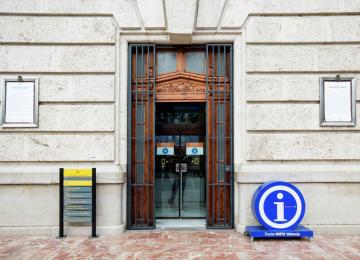
Tourist Information Office City Hall-Ayuntamiento
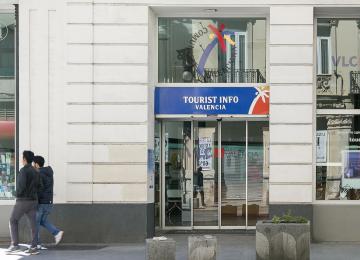
Tourism Information Office Paz
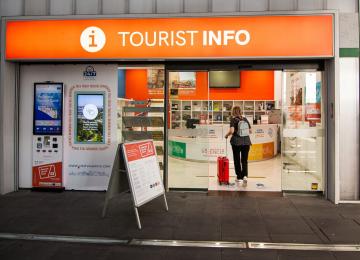
Tourist Information Office - Joaquin Sorolla
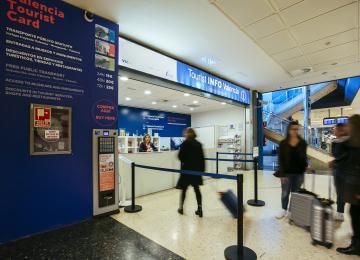
Tourist Information Office - Airport

Tourist Information Office Beach
Digital kiosks.
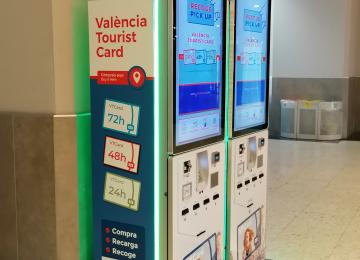
Digital Kiosk at the Airport
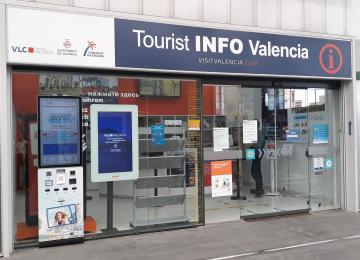
Digital Kiosk Tourist info Joaquín Sorolla
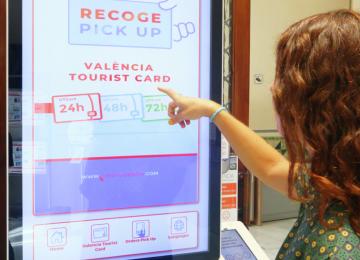
Digital Kiosk Town Hall (Ayuntamiento)
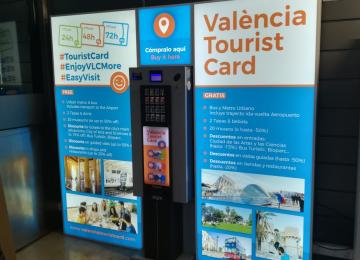
Vending Machine Tourist Card

Valencia Tourist Card
Travel around the city for FREE, enter museums and monuments for FREE and get amazing discounts
Subscribe to our Newsletter!
Do not miss the best plans in Valencia!
© VISIT VALÈNCIA 2024 | FUNDACIÓ VISIT VALÈNCIA

17 Top-Rated Tourist Attractions in Valencia
Written by Lisa Alexander Updated Dec 22, 2023 We may earn a commission from affiliate links ( )
In a dreamy seaside setting, this balmy Mediterranean port town lives up to the local saying "a piece of heaven fallen to earth." Under the warm rays of the southern sun, Valencia's palm-fringed plazas are full of life, and its churches sparkle with brightly colored azulejo domes.
As the old capital of the kingdom of Valencia, the city is rich in cultural attractions. Magnificent historic monuments, such as the 15th-century Silk Exchange, the 18th-century Marquise Palace, and the Museum of Fine Arts, tell the story of a wealthy merchant and aristocratic past.
Valencia has a charming historic center, the Ciutat Vella (Old Town), but the city has entered the 21st century with gusto. The sleek Modern Art Institute, along with the futuristic City of Arts and Sciences immerse visitors into a brave new world of artistic and scientific discovery.
Learn about the best places to visit with our guide to the top attractions and things to see and do in Valencia, Spain.
1. La Ciutat de les Arts i les Ciències
2. las fallas festival, 3. oceanogràfic de valència, 4. la lonja de la seda, 5. go shopping at mercado central, 6. iglesia de san nicolás de bari y san pedro mártir de valència, 7. admire the catedral de valència, 8. plaza de la virgen, 9. iglesia de santo tomás y san felipe neri, 10. meet the animals at bioparc valència, 11. museo arqueológico de la almoina, 12. palacio del marqués de dos aguas (ceramics museum), 13. museo nacional de bellas artes de valència, 14. institut valència d'art moderne, 15. torres de serranos (ancient town gate), 16. spend a day at playa del saler, 17. day trip to the medieval town of requena, where to stay in valencia for sightseeing, map of tourist attractions in valencia, valencia, spain - climate chart.
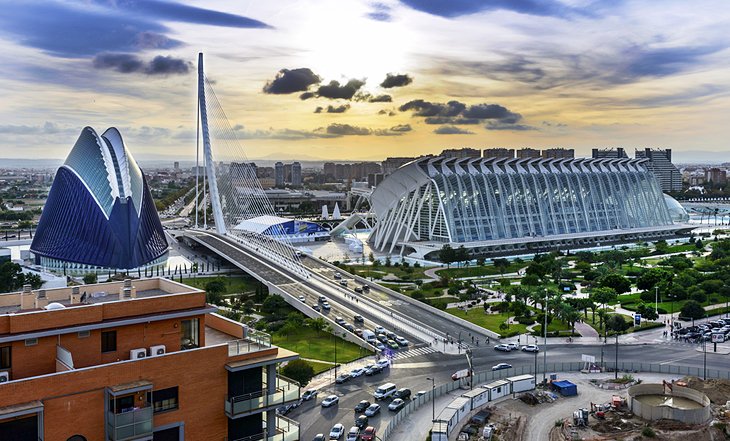
You can discover the fascinating world of arts and sciences at this futuristic complex on the outskirts of Valencia. La Ciutat de les Arts i les Ciències (The City of Arts and Sciences) is one of Europe's most impressive centers dedicated to cultural and scientific exhibitions.
In a two-kilometer space along the Turia River, the complex includes several stunning examples of avant-garde architecture designed by architects Santiago Calatrava and Félix Candela.
The Ciudad complex has six main areas: the Hemisfèric IMAX Cinema , which screens 3-D digital films and serves as a planetarium; the Umbracle landscaped area that features shaded walkways; the Museu de les Ciències , an interactive museum with exhibits about science, the environment, and technology; the Oceanogràfic , Europe's largest aquarium; the Palau de les Arts opera house; and the Ágora concert space.
The City of Arts and Sciences also hosts conferences, exhibitions, and workshops related to science and art topics.
Address: 7 Avenida del Professor López Piñero, València
Official site: http://www.cac.es/en/home.html
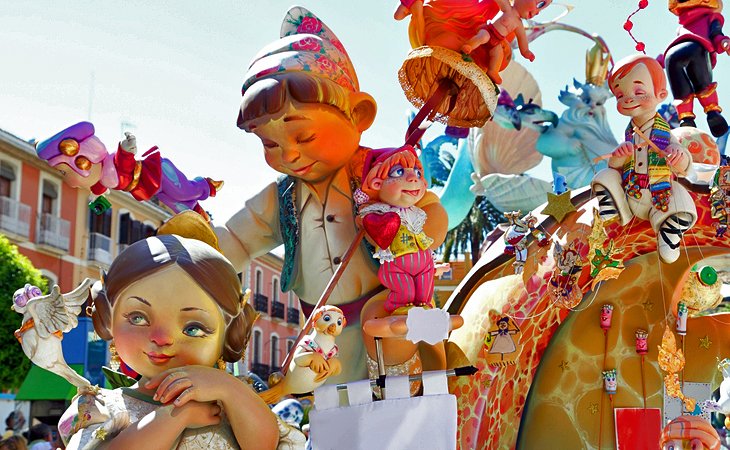
Valencia is one of the best places to visit in March . For over two weeks during the month of March, the city becomes a scene of joyous celebration during the Fiesta de San José (Feast Day of Saint Joseph), a lively religious festival that brims with creative spirit and interesting things to do. The festival includes traditional music and food (paella), a parade, fireworks, and unique art exhibits.
This festival is known for its creative installations called fallas , large floats featuring figures made of papier-mâché. These creations are set up in the streets and then burned at midnight on the last day of the fiesta. The custom originated in the Middle Ages, when carpenters and other craftsmen would burn leftover scraps of wood and other materials on the feast of Saint Joseph.
The Museo Fallero (Fallas Museum) on Plaza Monteolivete offers a chance to see the ninots (figures) that have been created over the years. It is interesting to see how the ninots have evolved with technology, from early wax figures dressed in real clothes to cartoon-like modern figures made of papier-mâché and most recently of polystyrene.
Address: Plaza Monteolivete 4, València
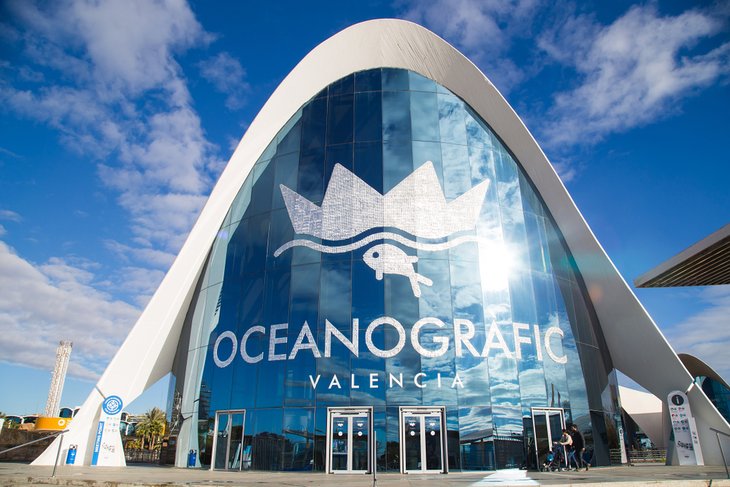
This striking building designed by architect Félix Candela as part of The City of Arts and Sciences houses the largest aquarium in Europe .
It is actually a complex of several buildings, each dedicated to one of the earth's most important marine ecosystems and environments: Wetlands, Temperate and Tropical, Oceans, Mediterranean, Antarctic, Arctic and Islands, and the Red Sea.
More than 500 different marine species are represented by 45,000 sea creatures, visible in nine towers that allow viewing as though you are underwater. The most dramatic of these is the tunnel, where you walk surrounded on both sides and overhead by swimming sharks.
Some of the most popular things to see are the beluga whales, sea lions, walruses, penguins, seals, sea turtles, and dolphins. Along with watching the sea life, you can experience mangrove swamps, marshlands, kelp forests, and other wetland environments with their native plant species.
If you're looking for something special to do, enjoy a meal at the Submarine Restaurant within the Oceanogràfic de Valencia building. The dining room is surrounded by a circular aquarium and features a chandelier that looks like a swarm of jellyfish. The menu focuses on modern-fusion cuisine with a Mediterranean influence. The restaurant serves lunch every day and dinner Monday through Saturday.
The Oceanogràfic de Valencia is open every day year-round. You can purchase combined tickets for admission to the Oceanogràfic aquarium and the Museu de les Ciències or the Hemisfèric.
Address: 1 Carrer d'Eduardo Primo Yúfera, València
Official site: https://www.oceanografic.org/en/
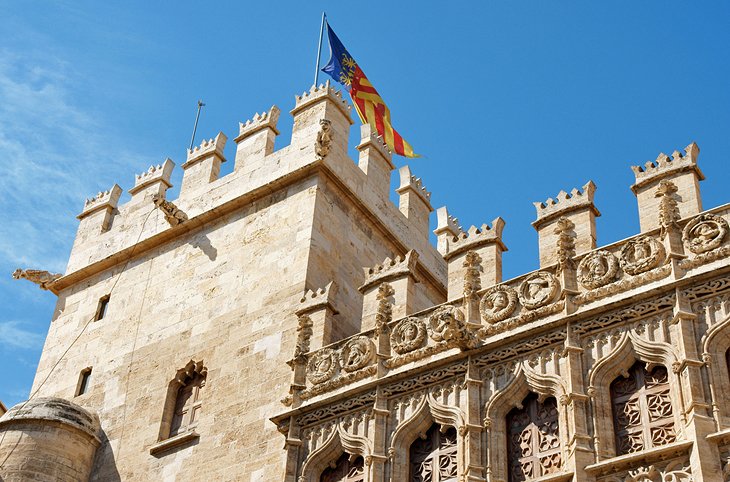
This magnificent Gothic structure was built in the 15th century to house the city's Silk Exchange , the marketplace where the famous Valencian silk was traded with merchants (to be sold all over Europe). The monument is listed as a UNESCO World Heritage Site .
One of the finest examples of Gothic civil architecture in Europe, La Lonja de la Seda resembles a medieval castle with its crenellated exterior and formidable tower. The façade features richly decorated doorways, decorative windows, and gargoyles (the grotesque carved creatures that function as water spouts). The main hall has rich stellar vaulting borne on twisted columns.
You can climb the 144 stone steps of the tower's helical staircase. From the top of the tower, the views of the town are stunning. This attraction is open to the public daily (except Mondays).
Address: Plaza del Mercado, València
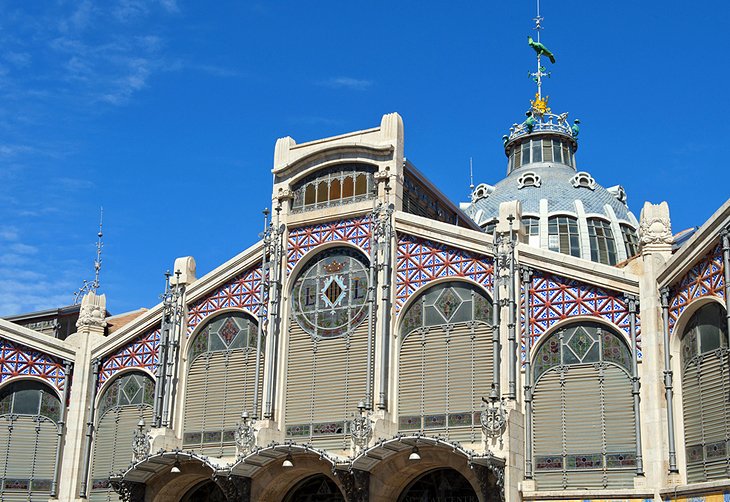
Just steps away from La Lonja de la Seda, the Mercado Central ( Central Market ) is a spacious marketplace built in 1928.
The Art Nouveau building is lavishly adorned with azulejos, decorative ceramics typical of the region. The hall contains hundreds of market stalls where vendors sell fresh fruits, vegetables, and food products from the Valencia region, as well as other areas of Spain.
The Iglesia de los Santos Juanes , a lovely historic church, is found on the Plaza del Mercado immediately next to the Mercado Central. This National Historic and Artistic Monument was built between the 14th and 16th centuries on the site of a hermitage church that replaced an old mosque.
While the interior is Gothic in style, the exquisite Baroque façade was designed by Vicente García in the 17th and early 18th centuries. Gorgeous frescos grace the interior's vaulted ceiling; the fresco paintings were created by Antonio Palomino in 1700.
Address: Plaza de la Ciutat de Bruges, València
Official site: https://www.mercadocentralvalencia.es/
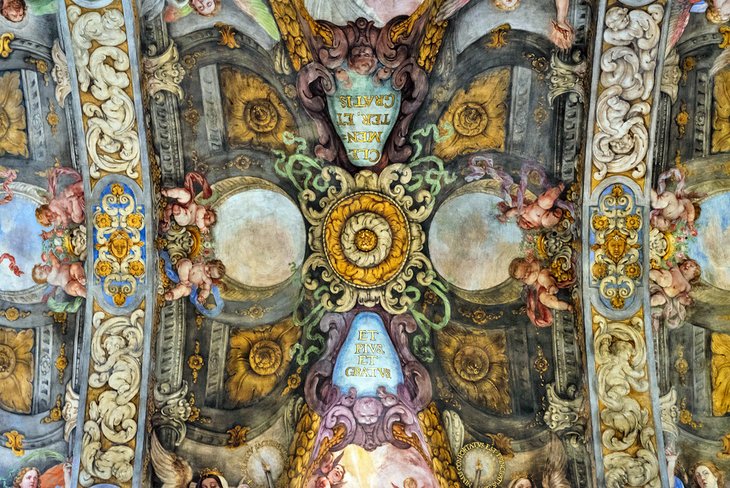
This church dedicated to St. Nicholas of Bari and St. Peter the Martyr was founded in the 13th century on the site of a Roman sanctuary. The Romanesque church was renovated in the Gothic style in the 15th century, and its interior was finished in the 1690s in the Baroque style.
Although the exterior is quite simple and somber, the church has a sumptuous interior that is one of the most ornate of all Valencia's churches. The sanctuary features breathtaking wall and ceiling frescoes designed by Antonio Palomino, while the actual painting was completed by Dionis Vidal. The frescoes represent scenes from the lives of Saint Nicholas and Saint Peter Martyr.
With its lavish frescoes and sculptural embellishments, this church is a gem of Baroque art and is sometimes compared to the Sistine Chapel in Rome . The impressive scale of the ceiling frescoes is unique in the world.
Address: 35 Calle de los Caballeros, València
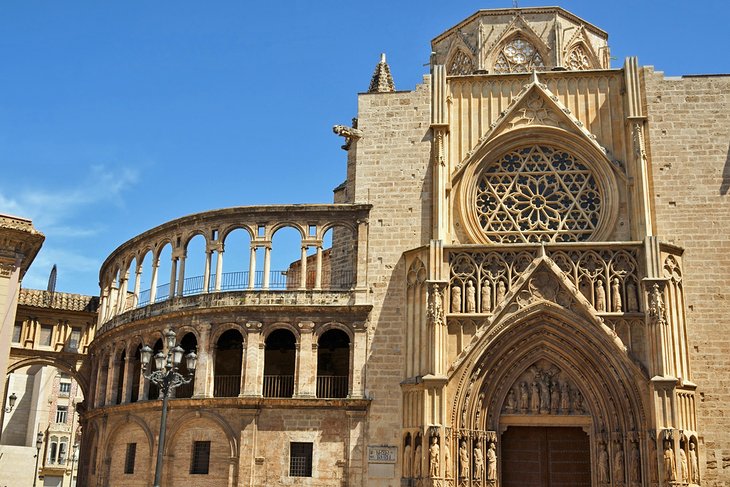
The Catedral de València (Catedral del Santo Cáliz) stands out as one of the most unusual cathedrals in Spain owing to its mishmash of architectural styles. Originally this location was the site of an ancient Roman temple and then a Moorish mosque.
At this spot that is steeped in history, the cathedral was constructed beginning in the 13th century. Renovations were made in the 15th century and 17th century.
The exterior combines original Romanesque architectural elements with sculptural details added later in the Middle Ages. Spend some time admiring the façade before entering the cathedral. The splendid Puerta del Palau doorway dates to the Romanesque era, while the Puerta de los Apóstoles (Apostles' Doorway) dates from the 15th century.
The interior has an inspiring ambience with its majestic domed ceiling and a rose window illuminating the space. Dazzling in its Gothic splendor, the somber high-vaulted nave is embellished with Renaissance paintings and elegant Baroque art. The various chapels are adorned with masterpieces of art, including paintings by Goya and a crucifix by Alonso Cano.
A highlight of the sanctuary is the Chapel of the Holy Grail (Capilla del Santo Cáliz), with delicate vaulting and star motifs. This chapel illustrates a scene of the 12 apostles in Heaven and the coronation of the Virgin Mary. The most sacred object is a reliquary containing the Holy Chalice, an artifact from the first century CE said to be the goblet that Jesus used to perform the Holy Eucharist.
The Cathedral of Valencia also has a museum, the Museo Catedral de València , which displays a prestigious collection of religious art. A variety of styles from different time periods (Gothic, Renaissance, etc.) are on display. The museum boasts many exceptional artworks including paintings by Mariano Salvador Maella and Francisco de Goya.
In addition to visiting the interior of the cathedral and the cathedral museum, you may ascend El Miguelete (the Miguelete Tower) to admire superb views. The 207-step climb to the top of the tower rewards with panoramic vistas of Valencia's cityscape.
The Cathedral of Valencia and the Cathedral Museum can be visit with an admission fee, which includes an audio-guide with various language options. Both the cathedral and its museum are open to the public year-round every day (except for Sundays during wintertime). The Miguelete Tower is open daily year-round; admission requires a small entrance fee.
Address: Plaza de l'Almoina, València
Official site: http://www.catedraldevalencia.es/en/
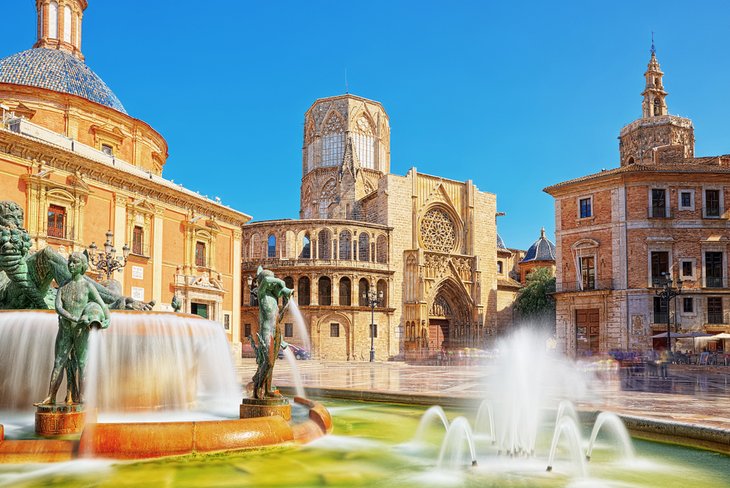
Overlooking the cathedral, the Plaza de la Virgen is among the oldest (it dates to Roman times) and loveliest of Valencia's many plazas.
The graceful Neptune fountain at the center of the Plaza de la Virgen is the work of Valencia sculptor Silvestre Edeta. Lighted at night, it's a favorite meeting place among locals.
The square is bordered by several landmark buildings. Across the square is the Palace of the Generalitat and next to the Catedral de València is the Real Basílica de Nuestra Señora de los Desamparados , the most important (and also the first) Baroque church in Valencia. This church is renowned for its magnificent fresco on the dome ceiling that was painted by Antonio Palomino in 1701 and is considered a masterpiece of Spanish Baroque art.
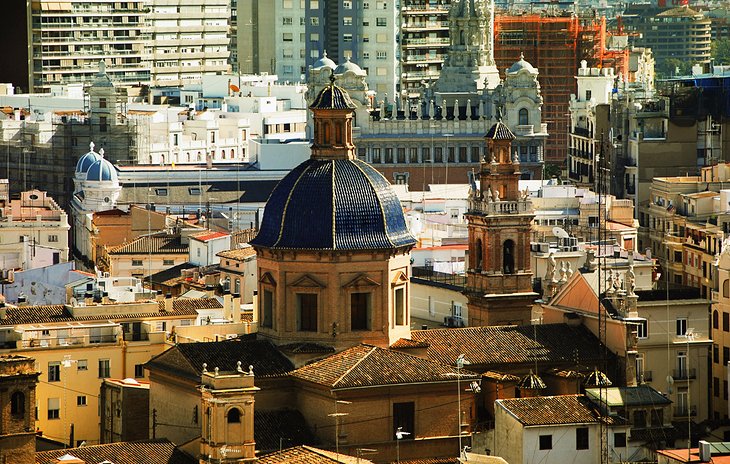
With its dazzling blue-tiled dome, this beautiful church exemplifies the characteristic Mediterranean style of Valencia. Built in 1725, the Church of Saint Thomas and Saint Philip was listed as a National Historic Monument in 1982.
The church has a fancifully decorated Baroque façade, and the architectural layout was modeled after the much-imitated Il Gesú church in Rome . The breathtaking interior has a spacious central nave lined with numerous side chapels.
Catholic mass is held at the church daily. The monument is not open to the public for visit, but tourists may attend a mass to see the lovely sanctuary.
Address: Plaza de San Vicente Ferrer, València

Valencia's zoo covers 25 acres north of the park created by the diversion of the River Turia's course. The landscape was created to house animals in as close to their native habitats as possible, and the zoo is especially known for its large collection of African animals.
The environment is designed so that you immediately feel as though you have been transported to Africa as they view animals almost barrier-free in landscapes typical to the savannah, Madagascar, and equatorial Africa.
Instead of separating different species, they coexist as they would in their native environments. On the savannah, for example, lions, giraffes, antelopes, and rhinoceros all live together as they do in the wild. Gorillas inhabit a dense equatorial forest, while hippopotami and crocodiles cool in the water.
Bioparc is actively committed to sustainability of resources and to wildlife conservation, using solar panels to heat water, and recycling more than 95 percent of it.
Address: 3 Avenida Pío Baroja, València
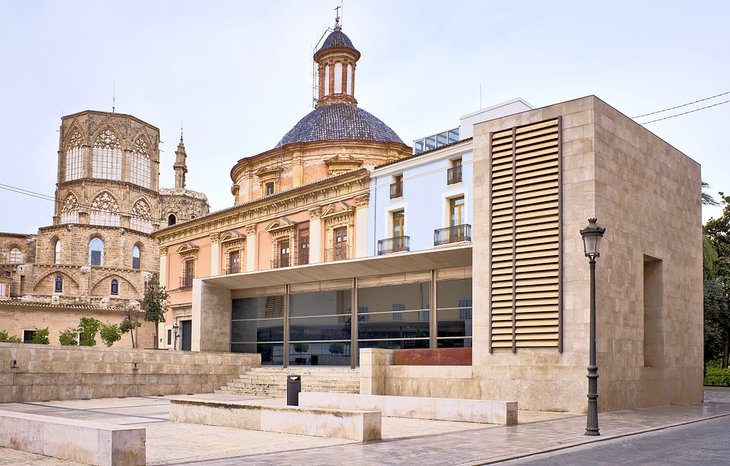
Beneath a sleek modern building across from the cathedral, La Almoina Archaeological Museum offers a glimpse of the civilizations that have contributed to Valencia's heritage. Discovered during excavations between 1985 and 2005 are well-preserved remains of the first settlement here by the Romans, more than 2,000 years ago.
There are remnants (dating to the 2nd century CE) of the Roman baths and streets, including a sanctuary, part of the forum portico. A baptistery and the apse of a church are from early Christian times. The era of Moorish rule is revealed in vestiges of a courtyard, pool, and fortifications from the Alcázar of the old Muslim city.
Together with historic pottery and other artifacts found underneath modern Valencia, the excavated area is considered one of Europe's best archaeological sites . The ancient ruins are covered with plexiglass to allow for easy viewing, and walking paths are lined with railings for a pleasant experience.
Address: Plaza Décimo Junio Bruto, València
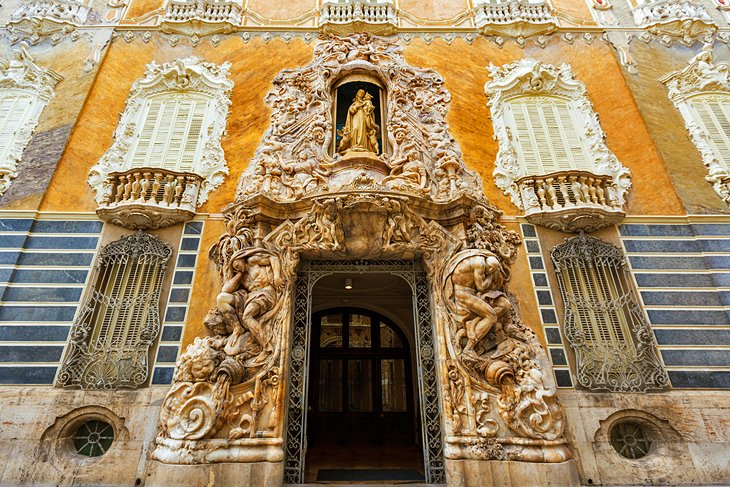
Near the Església de Sant Martí (Church of San Martín) is the Palacio del Marqués de Dos Aguas, an 18th-century aristocratic palace that belonged to a prominent noble family. The palace is renowned for its opulently decorated façade and refined, ornately decorated interior.
The palace now houses the González Martí National Museum of Ceramics , which opened in 1947. The museum presents more than 5,000 examples of traditional pottery from Valencia and the surrounding area, azulejos (blue glazed ceramic) from Teruel, and faience (glazed earthenware) from Toledo and Seville.
Other interesting items on display include ancient Greek, Roman, and Arab pottery; and fine porcelain from the Silk Route (China) and Japan. The collection also contains modern pieces, including works by Picasso, and contemporary items.
A highlight of the collection is the fully-equipped 19th-century Valencian kitchen featuring traditional tiles.
The González Martí National Museum of Ceramics is open Tuesday through Sunday.
Address: 2 Calle Poeta Querol, València
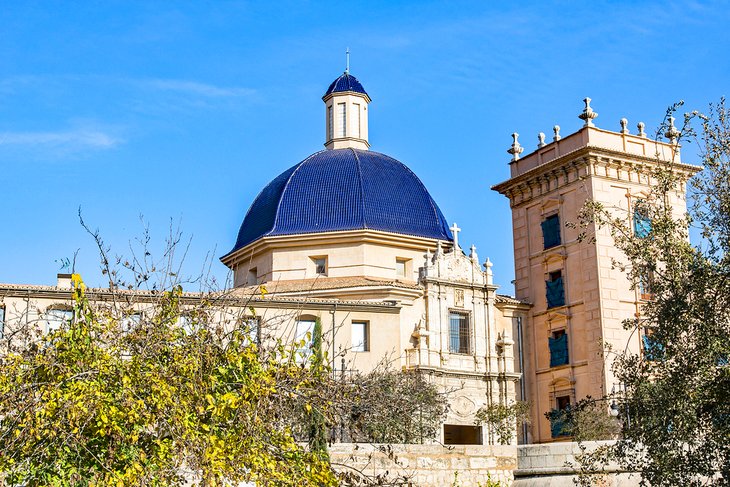
The National Museum of Fine Arts is a wonderful place to discover the artistic heritage of the Valencia region.
The museum displays archeological findings, paintings, and sculptures, from the medieval period to the 20th century. Much of the art collection represents medieval religious paintings created by Valencian artists or works created for Valencia churches.
Among the museum's most precious works are the 14th-century altarpiece of Fray Bonifacio Ferrer (a Valencian friar) and a triptych of the Passion by Hieronymus Bosch. The assortment of 16th- to 19th-century Spanish paintings is also interesting.
Highlights of the Valencian painting collection are the Last Supper and Saint Bruno by Francisco Ribalta and Saint Jerome by Jusepe de Ribera. Other Spanish masters represented include Diego Rodríguez de Silva y Velázquez, Bartolomé Esteban Murillo, El Greco, Francisco de Goya and Luis de Morales.
Adjoining the Museum of Art is the Jardines del Real , a peaceful green space filled with statues, fountains, and walking paths.
The museum is open Tuesday through Sunday. Admission is free of charge.
Address: 9 Calle San Pío V, València
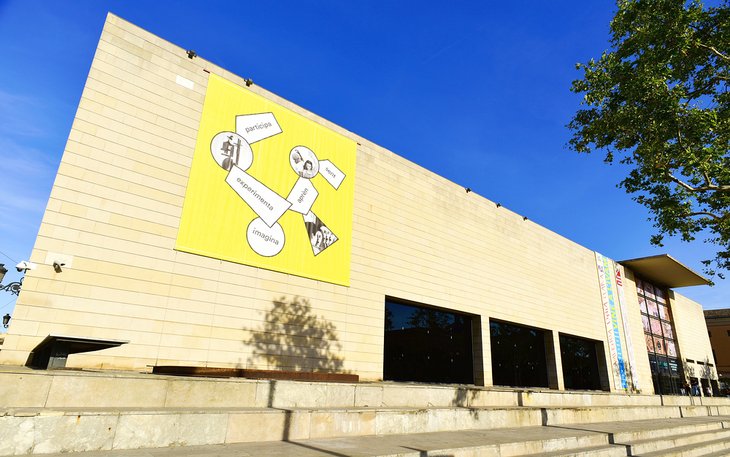
Housed in a surprising space-age building, the Valencia Institute of Modern Art is dedicated to the avant-garde art of the 20th century. The permanent collection covers all movements of modern and avant-garde art, including Analytical Abstraction, Pop Art, and New Figurative.
The museum also hosts temporary exhibitions, lectures, and workshops. In striking contrast to the modern building, an underground room of the museum reveals ruins of Valencia's medieval city wall. The archeological remains were uncovered during construction of the museum.
Well-designed for visitors, the museum has a trendy casual restaurant, Mascaraque , which serves contemporary-style Mediterranean cuisine and has a pleasant outdoor terrace.
There is also a library with a bookshop and Reading Room; the library contains over 40,000 books and documents on topics of modern art.
The Valencia Institute of Modern Art is open Tuesday through Sunday and is open late on Fridays. Admission is free of charge.
Address: 118 Calle Guillem de Castro, València
Official site: http://www.ivam.es/en/
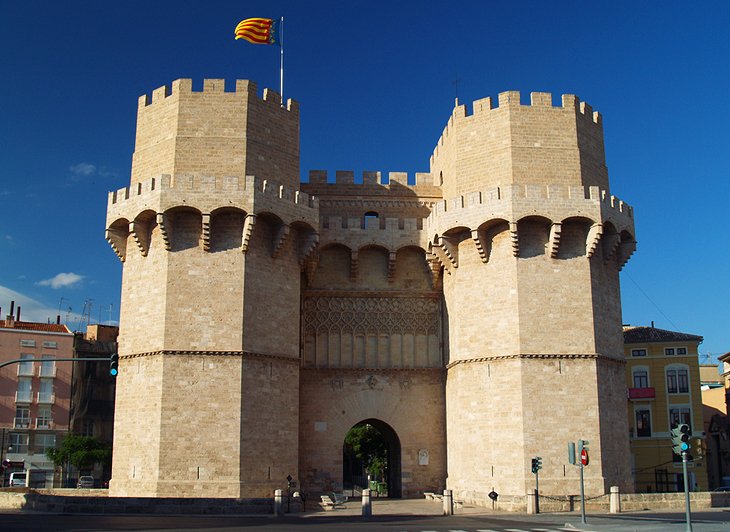
This impressive landmark is a symbol of Valencia . The Torres de Serranos represents an ancient gate of the Old Town and recalls an era when the town was surrounded by defense walls. The town ramparts were built in the 14th century on top of Roman foundations.
In 1930, the Serranos Towers were restored to their former glory. From these massive towers, take in sweeping views of the cityscape. The archway of the entrance gate features decorative Gothic details and two shields of the city.
Address: Plaza dels Furs, València
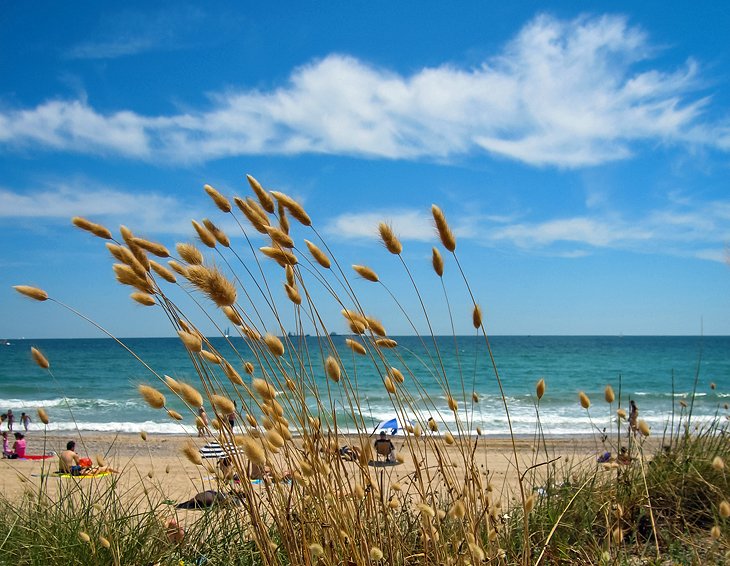
One of the most popular beaches in the Valencia region, this pristine stretch of sand is just 16 kilometers from Valencia in the La Albufera Natural Park . Two other beautiful beaches border El Saler Beach: Playa L'Arbre del Gos; and to the south, La Garrofera beach. This idyllic stretch of fine sandy shoreline extends for 2.6 kilometers and is protected from the wind by dunes and pine trees.
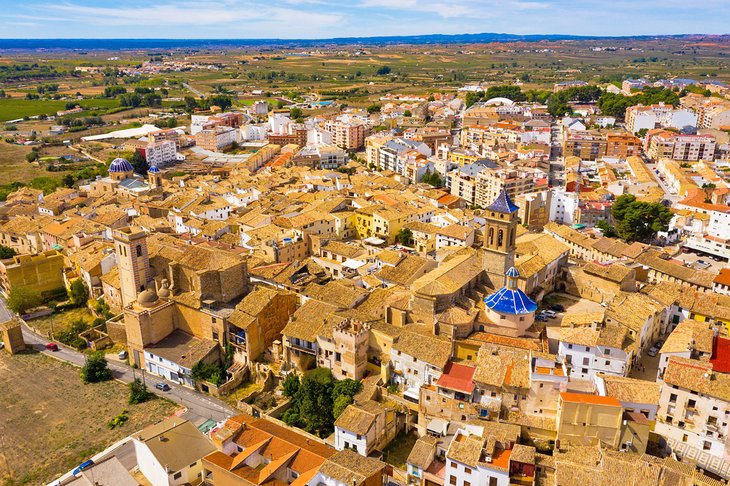
Located 68 kilometers from Valencia, the charming medieval town of Requena reveals a typical Hispanic-Arabic ambience with its old Moorish castle , many narrow pedestrian streets, peaceful squares, and houses adorned with decorative tiles and wrought-iron balconies.
The town has two important 14th-century churches, the Iglesia de Santa María and the Iglesia del Salvador ; both feature ornate Isabelline Gothic facades. Other noteworthy medieval monuments include the El Cid Palace and the Iglesia de San Nicolás .
For those seeking relaxation, the Fuente Podrida spa resort is a worthwhile 30 kilometers from Requena in a pristine natural environment.
The top tourist attractions in Valencia are mostly in the Ciutat Vella (Old Town), the historic city center around the cathedral and Plaza del Ayuntamiento. Fortunately for tourists, other attractions (such as the beach) are accessible by an excellent transit system. These highly rated hotels in Valencia are convenient for sightseeing:
Luxury Hotels :
- On a quiet street near the cathedral, the five-star Caro Hotel occupies the Palacio Marqués de Caro, a historic monument that has been beautifully restored. The recently updated interior décor is sleek and minimalistic. Amenities include a concierge, small swimming pool, and a Michelin-starred gastronomic restaurant.
- Styled with Art Deco interiors, the five-star The Westin Valencia is in a quiet neighborhood near The City of Arts and Sciences. Lush Mediterranean landscaping, a fitness center, spa, indoor swimming pool, and three restaurants make for a resort-like atmosphere.
- The five-star Hotel Las Arenas Balneario Resort is a beachfront property with a large outdoor swimming pool. Many guest rooms feature private balconies with sea views. The hotel is on a metro line to the center, a good compromise between the beach and sightseeing.
Mid-Range Hotels:
- Ideally located in the center of Valencia on the Plaza del Ayuntamiento, the four-star Meliá Plaza is within walking distance of many historic attractions, as well as shops and restaurants. Some rooms have balconies with views onto the Plaza de Ayuntamiento. The hotel's restaurant specializes in Mediterranean cuisine.
- The three-star Petit Palace Plaza de la Reina is located in the historic center of Valencia near the cathedral and the Palacio del Marqués de Dos Aguas. The contemporary-style guest rooms feature modern amenities such as flat-screen televisions and iPads. Some rooms feature balconies with city views.
- The SH Ingles occupies a beautifully restored 18th-century palace in the historic La Xerea neighborhood near Palacio del Marqués de Dos Aguas. This four-star boutique hotel has a concierge, 24-hour front reception desk, and a gourmet restaurant known for its authentic paella. The guest rooms are spacious, bright, and minimalistic in style.
- Within easy walking distance of The City of Arts and Sciences, the four-star AC Hotel by Marriott Colón Valencia offers sleek contemporary-style guest rooms, a fitness center, and room service.
Budget Hotels:
- Just off Plaza del Ayuntamiento, near restaurants and historic attractions, the three-star Catalonia Excelsior offers well-situated accommodations at affordable rates. The hotel provides a 24-hour front reception desk, concierge services, and a buffet breakfast.
- The four-star Barceló Valencia is just opposite The City of Arts and Sciences, with great views of the iconic buildings. The hotel offers many luxuries for the price, including a rooftop terrace with a swimming pool and sundeck.
- Another hotel overlooking The City of Arts and Sciences, the three-star NH Valencia Las Ciencias is a 15-minute drive to the beach and a 10-minute bus ride to the historic center (Ciutat Vella) of Valencia. Amenities include concierge service and a 24-hour front reception desk.
More Related Articles on PlanetWare.com
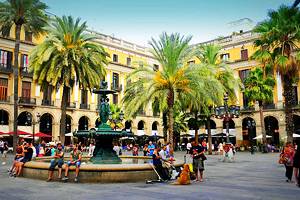
Exploring the Mediterranean Coast : The beaches of Mediterranean Spain are some of the loveliest in the world, one of the most famous being El Milagro in the UNESCO-listed Tarragona , which sits north of Valencia. Iconic Barcelona is just beyond, famous for its medieval Barri Gòtic, Modernist architecture, and sandy beaches.
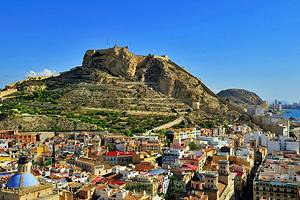
Historic Towns near Valencia: South of Valencia, the Castillo de Santa Bárbara looks down over the extensive beaches and historic town of Alicante . For those who want to venture inland, the art museums of Madrid and cultural diversity of the medieval walled city of Toledo are top picks for sightseeing.
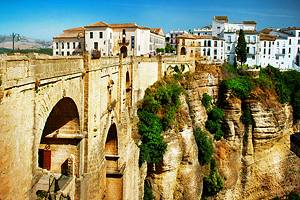
Other Must-See Cities in Spain : A treasure-trove of cultural attractions, Zaragoza boasts ancient Roman ruins, as well as Moorish and Baroque landmarks. West of Alicante, Córdoba is best known for its UNESCO-listed mosque, La Mezquita. To the south, Andalusia 's pride, Granada is a top tourist destination thanks to its vibrant cultural life full of flamenco dancing and cuisine influenced by neighboring Arabian countries. From here, the seaside old-world paradise of Málaga is just a short jaunt to the southern shores.
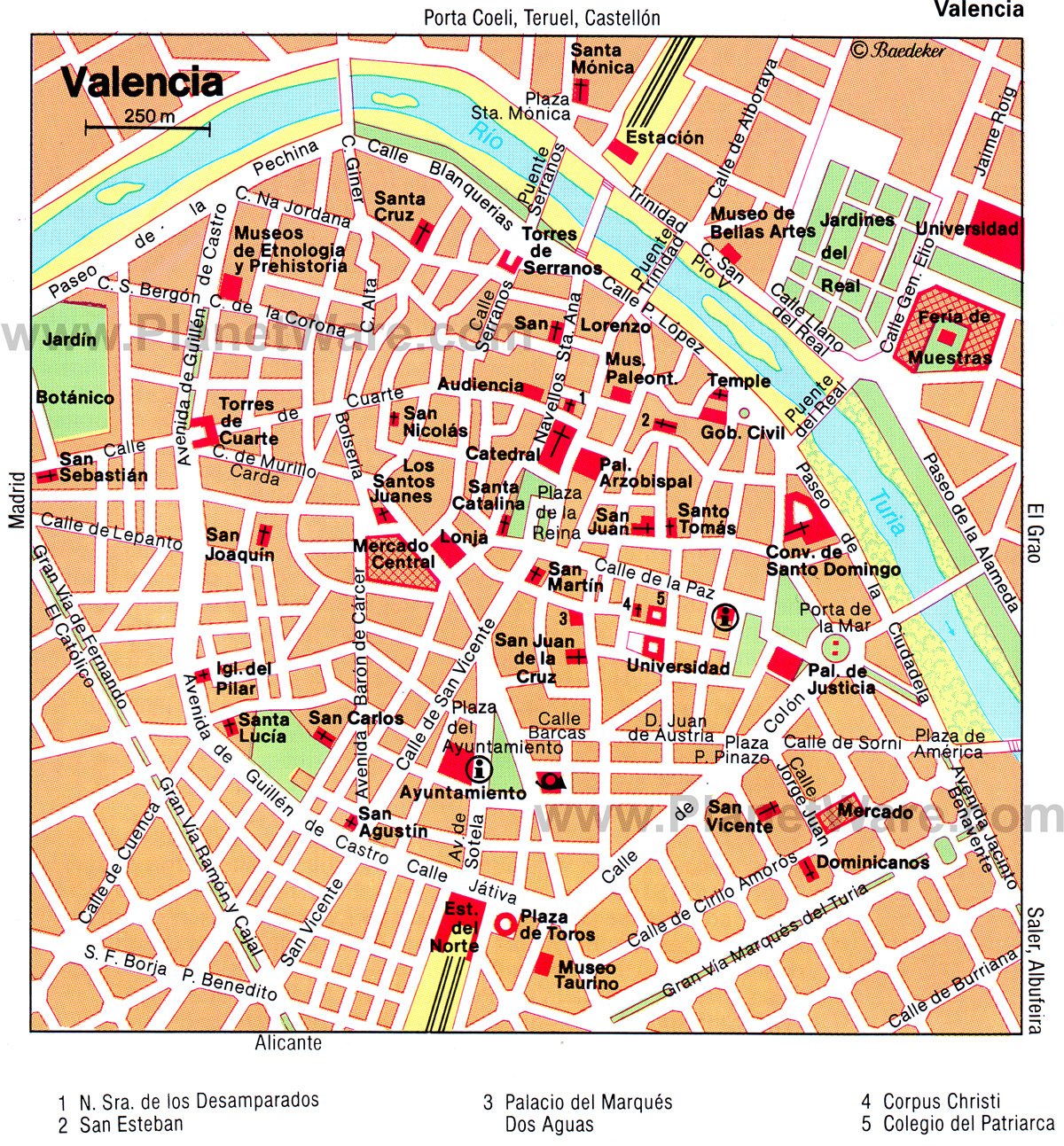
More on Spain


Tourism in Valencia
Disclaimer: Some posts on Tourism Teacher may contain affiliate links. If you appreciate this content, you can show your support by making a purchase through these links or by buying me a coffee . Thank you for your support!
Tourism in Valencia is big business! But why is tourism here so important and why does it matter? Read on to find out!
Geography of Valencia
Valencia is a province located on the eastern coast of Spain, bordered by the provinces of Castellón to the north, Teruel and Cuenca to the west, Albacete to the southwest, and Alicante to the south. The province has a diverse landscape that includes coastal areas, mountains, and plains.

The coastline of Valencia province is known as the Costa del Azahar (Orange Blossom Coast), and stretches for over 120 km. It includes popular tourist destinations such as Valencia city, Gandia, and Benidorm. The beaches along the coast are known for their fine sand and clear waters and are a big reason for the popularity of tourism in Valencia.
Inland, the province is dominated by the Sierra de Espadán mountain range, which runs parallel to the coast. The highest peak in the range is Montí, which stands at 1,106 metres. The Sierra de Mariola is another important mountain range in the province, located in the northwest.
The plains of Valencia province are located in the south and east, and include the Albufera Natural Park, which is a wetland area that is home to many species of birds and fish. The park is also known for its rice fields, which are used to produce the famous Valencian dish, paella.
Valencia province has a Mediterranean climate, with hot, dry summers and mild winters. The region is known for its agriculture, particularly the cultivation of oranges, which are exported all over the world. Other important crops include rice, vegetables, and almonds.
Valencia is also home to several important rivers, including the Turia, which flows through Valencia city, and the Júcar, which runs through the western part of the province. The region is well-connected by road and rail, and is served by Valencia Airport, which is located to the west of the city. These good connections contribute to the success of tourism in Valencia.
Valencia is a popular tourist destination in Spain, attracting millions of visitors each year. Tourism in Valencia is an important sector of the regional economy, generating significant employment and revenue. Here are some statistics on the tourism industry in Valencia:
- In 2019, Valencia received over 10 million visitors, an increase of 4.4% compared to the previous year. Of these visitors, 75% were from abroad and 25% were domestic.

- The most popular month for tourism in Valencia is August, followed by July and September.
- The majority of visitors to Valencia come from Europe, with the United Kingdom, France, and Germany being the top three markets. Visitors from the Americas, Asia, and Australia also make up a significant portion of the tourist market.
- Valencia’s main attractions include its beaches, historic city center, the City of Arts and Sciences, and the Fallas festival.
- The average length of stay for visitors to Valencia is 2.7 days, with an average daily expenditure of €84.
- The tourism industry in Valencia provides employment for over 80,000 people, making up around 9% of the regional workforce.
- The economic impact of tourism in Valencia is significant, contributing over €6 billion to the regional economy each year.
Overall, tourism in Valencia is a vital part of the region’s economy, providing employment opportunities and generating substantial revenue. The city’s diverse attractions and favourable Mediterranean climate continue to draw visitors from around the world.
Why People Travel to Valencia
People travel to Valencia for a variety of reasons, including its rich history, vibrant culture, beautiful beaches, delicious cuisine, and modern attractions. Here are some of the main reasons why people choose to visit Valencia:
- History and Culture: Valencia has a rich history that dates back to the Roman era, and the city’s historic centre is home to many well-preserved landmarks and monuments, such as the Cathedral of Valencia, the Silk Exchange, and the Torres de Serranos. The city also has a vibrant cultural scene, with numerous museums, galleries, and theatres showcasing both traditional and contemporary art and performance.
- Beaches: Valencia’s coastline stretches for over 120 kilometres and is home to some of Spain’s most beautiful beaches, such as Playa de la Malvarrosa and Playa del Cabanyal. These beaches are perfect for swimming, sunbathing, and water sports.

- City of Arts and Sciences: This futuristic complex is one of the most popular attractions in Valencia. It includes a science museum, an opera house, an IMAX cinema, an aquarium, and more.
- Fallas Festival: Every year, Valencia hosts the Fallas festival, a week-long celebration that features large, colourful sculptures, fireworks, and street parties. It is one of Spain’s most famous festivals and attracts visitors from around the world.
- Cuisine: Valencia is known for its delicious cuisine, including paella, a rice dish that originated in the region. Other local specialties include horchata (a sweet, milky drink), fideuà (a noodle-based dish similar to paella), and bunyols (a type of doughnut).
Overall, Valencia’s unique blend of history, culture, natural beauty, and modern attractions make it a popular destination for tourists of all ages and interests.
Most popular Visitor Attraction in Valencia
Valencia offers a variety of popular tourist attractions, ranging from historic landmarks to modern attractions. Here are some of the most popular tourist attractions in Valencia:
- The City of Arts and Sciences: This futuristic complex is one of Valencia’s most iconic landmarks, and it features several world-class attractions, including an opera house, a science museum, an IMAX cinema, an aquarium, and a planetarium.
- Valencia Cathedral: The Valencia Cathedral, also known as the Cathedral of Santa Maria de Valencia, is a beautiful Gothic-style church that dates back to the 13th century. It is home to numerous works of art, including paintings by Goya and frescoes by Palomino.

- La Lonja de la Seda: This UNESCO World Heritage Site is a beautiful Gothic-style building that was once used as a silk exchange. It is known for its stunning architecture and ornate decorations, including intricate carvings and frescoes.
- Mercado Central: The Mercado Central is a bustling marketplace that is home to over 1,000 vendors selling fresh produce, seafood, meat, and other local specialties. It is one of the largest indoor markets in Europe and is a must-visit for foodies.
- Playa de la Malvarrosa: This beautiful beach is one of Valencia’s most popular attractions, and it is a great place to relax, swim, and sunbathe. It is situated close to many bars and restaurants, making it a popular spot for nightlife.
- Fallas Festival: The Fallas festival is one of Spain’s most famous festivals and takes place in Valencia every year in March. It features large, colourful sculptures, fireworks, and street parties, and attracts visitors from around the world.
- Bioparc Valencia: This zoo is known for its immersive, natural habitats that allow visitors to get up close with animals such as lions, gorillas, and elephants.
Overall, Valencia offers a diverse range of popular tourist attractions that showcase the city’s history, culture, natural beauty, and modern attractions, making it a popular destination for tourists from around the world.
Who travels to Valencia?
Valencia is a popular tourist destination that attracts a diverse range of visitors from around the world. Here are some of the types of tourists that travel to Valencia:
- Leisure Tourists: Valencia is a popular destination for leisure tourists who are looking for a relaxing holiday in the sun. Many leisure tourists come to Valencia to enjoy the city’s beautiful beaches, warm climate, and vibrant nightlife.
- Cultural Tourists: Valencia is home to many museums, galleries, historic landmarks, and cultural events, making it a popular destination for cultural tourists who are interested in exploring the city’s rich cultural heritage.
- Nature Tourists: Valencia has several nature reserves and parks, making it a popular destination for nature tourists who are looking to explore the region’s natural beauty, including forests, wetlands, and mountain ranges.
- Gastronomic Tourists: Valencia is known for its delicious cuisine, including the world-famous paella, which originated in the region. Many tourists come to Valencia to explore the local food scene, take cooking classes, and sample traditional dishes.
- Sports Tourists: Valencia is home to several sports teams, including Valencia CF, one of Spain’s top football clubs. The city also hosts several sporting events throughout the year, including the Valencia Marathon and the Valencia Open tennis tournament, making it a popular destination for sports tourists.
- Business Tourists: Valencia is a thriving business hub, and many visitors come to the city for business-related purposes, including conferences, meetings, and trade shows.

Overall, Valencia attracts a diverse range of tourists who are interested in exploring the city’s rich cultural heritage, natural beauty, delicious cuisine, and vibrant entertainment scene
Ten FAQs for tourism in Valencia
Here are ten frequently asked questions about tourism in Valencia:
- What is the best time of year to visit Valencia?
The best time to visit Valencia is during the spring and fall seasons when the weather is mild, and the crowds are smaller. However, summer is also a popular time to visit due to the beaches and outdoor activities.
- What is the currency in Valencia?
The currency used in Valencia is the Euro.
- Is it safe to visit Valencia?
Valencia is generally a safe city to visit, but as with any destination, it’s important to be aware of your surroundings and take precautions to prevent pickpocketing and other petty crimes.
- Do I need a visa to visit Valencia?
If you are a citizen of the EU, you do not need a visa to visit Valencia. Citizens of other countries may need to apply for a visa before travelling.
- What language is spoken in Valencia?
- The official language of Valencia is Spanish, but many locals also speak Valencian, which is a dialect of Catalan.
- What are the main attractions in Valencia?
Some of the main attractions in Valencia include the City of Arts and Sciences, the Central Market, the Turia Gardens, and the Cathedral of Valencia.
- What is the best way to get around Valencia?
Valencia has an excellent public transportation system, including buses, trams, and a metro system. Taxis and bike rentals are also available.
- What is the food like in Valencia?
Valencia is known for its traditional cuisine, including the famous dish paella, as well as seafood, tapas, and local wines.
- What is the weather like in Valencia?
Valencia has a Mediterranean climate, with hot summers and mild winters. Temperatures can reach up to 30°C in the summer months, while winter temperatures average around 15°C.
- How many days should I spend in Valencia?
While it’s possible to see the main attractions in Valencia in a few days, it’s recommended to spend at least 4-5 days fully exploring tourism in Valencia.
To conclude: Tourism in Valencia
As you can see, tourism in Valencia is very important. However, it must be carefully managed in order to be sustainable. If you enjoyed this article about tourism in Valencia, I am sure you will love these too:
- The Catalonia Flag: 13 Fascinating Facts
- Spain’s islands- 15 fascinating facts
- 35 spectacular things Spain is known for
- 13 fun things to do in the Murcia region with kids
- 50 Famous Landmarks in Spain (with photos)
Liked this article? Click to share!
Stay up to date with notifications from The Independent
Notifications can be managed in browser preferences.
US Edition Change
- US election 2024
- US Politics
- UK Politics
- News Videos
- Rugby Union
- Sports Videos
- Photography
- Theatre & Dance
- Culture Videos
Food & Drink
- Health & Families
- Royal Family
- Electric Vehicles
- Lifestyle Videos
- News & Advice
- Simon Calder
- Inspiration
- City Guides
- Sustainable Travel
- Politics Explained
- News Analysis
- Home & Garden
- Fashion & Beauty
- Travel & Outdoors
- Sports & Fitness
- Sustainable Living
- Climate Videos
- Electric vehicles
- Behind The Headlines
- On The Ground
- Decomplicated
- You Ask The Questions
- Binge Watch
- Travel Smart
- Watch on your TV
- Crosswords & Puzzles
- Most Commented
- Newsletters
- Ask Me Anything
- Virtual Events
Thank you for registering
Please refresh the page or navigate to another page on the site to be automatically logged in Please refresh your browser to be logged in
The Independent's journalism is supported by our readers. When you purchase through links on our site, we may earn commission.
Travel guide to Valencia: Where to stay and what to do in Spain’s laid-back coastal city
Visitors to this city in eastern spain will be charmed within minutes by an endearing blend of picture-perfect coastline, a juxtaposition of historic and futuristic architecture, and food that calls for feasting. chris wilson reveals how best to spend time in this understated hub of coastal cool, article bookmarked.
Find your bookmarks in your Independent Premium section, under my profile
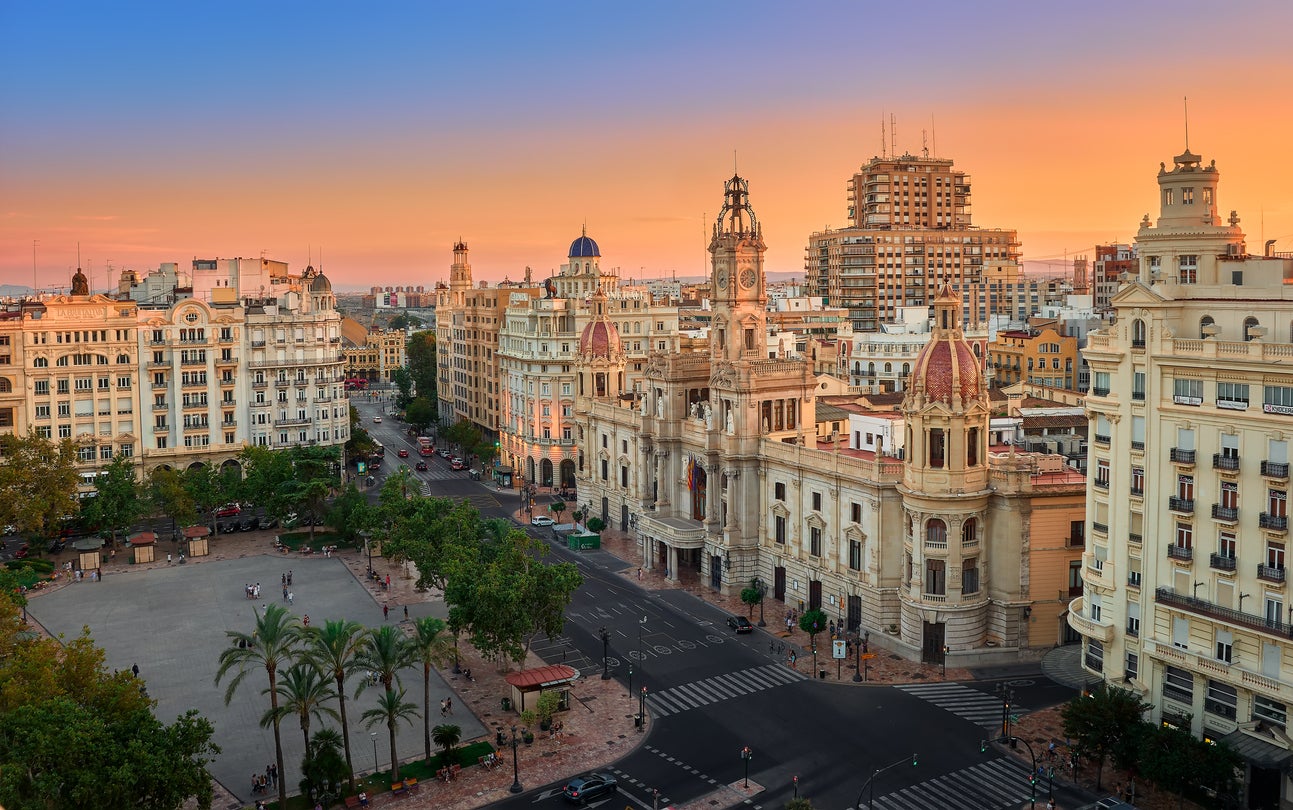
Sign up to Simon Calder’s free travel email for expert advice and money-saving discounts
Get simon calder’s travel email, thanks for signing up to the simon calder’s travel email.
S itting on a beautiful stretch of Mediterranean coast and bisected by a winding six-mile park that follows the old river, Valencia is a city that has seamlessly combined historic features and architectural elegance with the natural features it was blessed with.
Long overlooked in favour of the sprawling capital Madrid or perennially popular Barcelona , Valencia is beginning to show up more on the tourism radar. The city is happy for others to remain the dominant destinations, avoiding the overtourism that has plagued its Iberian neighbours and retaining its delightful balance of nature and city life.
A mix of palm-lined boulevards and tight-knit alleyways dominate its lively Old Town and the surrounding laid-back barrios . Gothic and modernist buildings add to an already abundant sense of Spanish charm, with the City of Arts and Sciences providing a dash of futuristic creativity.
Add in a refreshing lack of crowds, year-round sun and a gastronomic scene that belies its modest size, and Valencia has the ideal recipe for a weekend break (or longer). Discover the best of the city, but be sure to take some time exploring aimlessly, as you never know what you might find here.
Get to know the neighbourhoods
The Old Town, known as Ciutat Vella, is the heart of the city, linked by three squares. Start at Plaza del Ayuntamiento, the largest square in the city and home to the striking 18th-century City Hall, a vast post office featuring an intricate stained-glass ceiling and a daily flower market that has been operating from here since the 20th century.
From here, head north, firstly to Plaza de la Reina – the most scenic square in the city and a great place for a lunch, whether you fancy Italian, tapas or just sandwiches and crepes – and then to Plaza de la Virgen, which looks onto the cathedral and links the Old Town with the Carmen neighbourhood.
Carmen and hipster, international Ruzafa leave behind large plazas and well-known brands in favour of independent shops and hole-in-the-wall bars, hidden among a network of narrow alleys and cobbled streets. These are two of the main nightlife areas, though in the day they serve locals gathering for a quick coffee, a family lunch or a simple perusal of new stock.
Read more on Spain travel :
- Why Spain makes for the perfect flight-free destination
- How to plan the perfect pintxos crawl in Bilbao
- Barcelona city guide: Where to eat, drink, shop and stay in the Catalan capital
Explore by bike
Cycling is the most efficient way to see Valencia, helped by a proliferation of bike rental shops such as Hola! Rent a Bike and Ruzafa Bike Rent (prices from €7 (£6) per day).
Head to Turia Gardens, a park that runs along the bed of the old Turia River, which was diverted after a serious flood in the 1950s. It is now a winding route lined with palm trees, ponds and plant beds, with paths that lead down to the City of Arts and Sciences , the modern-day symbol of the city.
Head to the beach
Valencia’s golden sands and wide promenades are ideal for days spent by the sea, where visitors can rent seats and umbrellas for around €15 (£13) per day. Las Arenas and Malvarrosa are closest to the city centre and contain the majority of beach bars and restaurants, and the wide promenade directly links with Patacona, the quietest and least spoiled stretch, where locals enjoy colourful sunsets at a series of laid-back beach bars.
Wander galleries and landmarks
Valencia is home to an eclectic mix of landmarks. The Gothic cathedral guards the Holy Grail that purportedly Jesus sipped from during the Last Supper, while the Museum of Fine Arts, the second largest gallery in Spain, houses works from some of the country’s most famous artists, including Goya, Velasquez and Valencia’s own Joaquin Sorolla.
The 15th-century Silk Exchange, a large Gothic complex, is one of the most important historic monuments in the city. Made a Unesco World Heritage site in 1996, it is designated a “masterpiece of late Gothic architecture”, seen in its spiralling pillars, cross-vaulted ceilings and marble paving, and harks back to Valencia’s medieval importance as a major mercantile city on the Mediterranean.
Experience Las Fallas
The Fallas festival is the biggest event in the calendar, taking place annually in March. It celebrates Saint Joseph and old carpenters’ traditions between 1 and 19 March, where the daily mascleta show of gunpowder and fireworks takes place at 2pm. On 19 March, the Fallas figures – intricate, often satirical plaster monuments that can reach up to 80ft tall – are burned, having been on show across the city in the days leading up to the event. Visit during this time to see the city at its energetic best.
Where to stay
For easy access to the main station and a short walk to the city centre, Hotel Zenit is a good option, with comfortable, contemporary rooms and a great buffet breakfast.
Rooms available from {{#price}} {{price}} per night {{/price}} {{^price}} Check availability for dates and prices {{/price}}
Rates provided by Booking.com
Hotel Amenities
Health & wellbeing.
The Melia Plaza is located close to most of Valencia’s main attractions, with a rooftop terrace that gives great views over the plaza. Rooms are stylish and modern, making for a pleasant stay.
The Vincci Palace hotel sits just off Plaza de la Reina. This Spanish chain specialises in elegant hotels and this outpost is no different, with opulent decor throughout and spacious, on-trend rooms. For price-quality ratio, this is one of the best places to stay in the city.
The Las Arenas Balneario is up there with Valencia’s most luxurious hotels. Sitting just a few metres from the beach, this glitzy hotel contains indoor and outdoor swimming pools, top-of-the-range spa facilities and large, elegant rooms with terraces.
Casual Vintage has rooms that are spacious considering the price, with decor inspired by pop culture of years gone by. Air-conditioning and a welcoming policy towards pets are a bonus, as is the superb Old Town location.
Where to eat
For breakfast and brunch, choose the delicious cakes and pastries of Dulce de Leche or a dish from Eggcellent , an independent cafe where the quality of the eggs benedict is second to none. Cafes such as Federal offer brunches featuring smashed avocado on toast.
For homemade tapas dishes and Spanish specialties, try Portolito , which serves exquisite tapas and more substantial dishes.
Central Bar is a local favourite, run by a Michelin-starred chef and shrewdly positioned in the middle of the Central Market, with a pared-back menu of around a dozen classic dishes, from blood sausage sandwiches to chicken croquettes.
Locals and tourists alike love the exceptional meats, mixed platters and homemade accompaniments at El Porteno . Alternatively, sample the deep flavours of the pinxtos at Sagardi , or the excellent mix of Spanish and international tapas dishes, from padron peppers to duck samosas, at the eccentric Cafe Infanta . If you’re looking for a wider selection, the stalls at Mercado de la Imprenta sell anything from bao buns to Lebanese cuisine.
Dozens of restaurants and cafes line the mile or so stretch of sand between Las Arenas and Patacona, including the famed La Pepica , where authentic paella – which contains chicken, rabbit and vegetables, not fish – is the highlight, and beach bars such as Destino 56 , which offer a wider range of international dishes washed down with delicious cocktails.
Where to drink
The standard of coffee in Valencia is excellent, from the quick takeaways of Panaria to the various independent cafes. Horchata , a local tiger nut milk delicacy, can be sampled at the long-standing Horchateria de Santa Catalina , in the centre of the city, for an authentic Valencian experience.
Several of the city’s best watering holes are a fusion of morning cafe and late-night bar, best showcased in the quirky, old-fashioned Cafe de las Horas , where sangria is served until the early hours of the morning in a glamorous 19th-century setting.
Valencia has a slew of great rooftop bars too, from the panoramic vistas over the Turia Gardens at Blanq Carmen to the summer parties on the terrace at L’Umbracle, another part of the City of Arts.
The two tapas chains of Cien Montaditos and La Surena provide amazing drink and food deals, such as “everything on the menu for €1” on Wednesdays and Sundays.
Where to shop
The city’s main thoroughfare is the Calle Colon, which is home to international brands and Spanish favourite El Corte Ingles , a large department store. Nearby Calle del Poeta Carol is the place to find high-end brands.
The winding streets of Carmen and Ruzafa are the destination for vintage shops, small boutiques and Spanish favourites such as Natura , a chain that sells a range of clothing, home decor and everyday items. In Carmen, Calle Caballeros is home to clothing stores such as Solea and Luna Nera, while Ruzafa – where you’ll find a vast range of second-hand stores – is the place to go to find quirky souvenirs, whether it’s Sixties posters at Novedades Casino or handmade jewellery at Gnomo .
To live like a local, buy fresh produce at the Central Market . Billed as the largest fresh produce market in Europe, its modernist structure and patterned ceramic tiles have become a symbol of the city. A staple in the life of many valencianos , its stalls welcome hundreds every morning, hunting anything from the catch of the day to deli meats.
Architectural highlight
The avant-garde structure of the City of Arts and Sciences is the modern symbol of Valencia. A collection of buildings that houses Europe’s largest aquarium, the Palau de les Arts cultural centre and several other features, it was inaugurated in 1998, but its design and complexity remain years ahead of its time.
The local architect in charge of the project, Santiago Contralto, often creates works that resemble living organisms. The Hemispheric, which contains a cinema and planetarium, is designed to resemble a human eye, while the Science Museum resembles the skeleton of a whale. The complex is open daily from 10am until 9pm in high season.
What currency do I need?
What language do they speak.
Spanish, but many people speak English.
Should I tip?
Service charges are rarely included, and a tip of 10 per cent is appreciated.
How should I get around?
Getting around the centre is best on foot, though the beaches are an hour away. Many people use bikes, while the metro is well-developed and efficient for longer journeys.
What’s the best view?
The Miguelete is the bell tower of the city’s cathedral, with a terrace around 50 metres up (it costs €2 to access). For a drink with a view, the Atenea Sky bar has sweeping views over Ayuntamiento.
Insider tip
While the siesta tradition has become less prevalent in Madrid and Barcelona, hundreds of businesses throughout Valencia will close for an hour or two in the early afternoon. Avoid doing the bulk of your shopping between 2pm and 4pm.
Read our reviews on the best Spain hotels
Join our commenting forum
Join thought-provoking conversations, follow other Independent readers and see their replies
Subscribe to Independent Premium to bookmark this article
Want to bookmark your favourite articles and stories to read or reference later? Start your Independent Premium subscription today.
New to The Independent?
Or if you would prefer:
Want an ad-free experience?
Hi {{indy.fullName}}
- My Independent Premium
- Account details
- Help centre
Partner content
The Valencian Community: an active tourism paradise for everyone
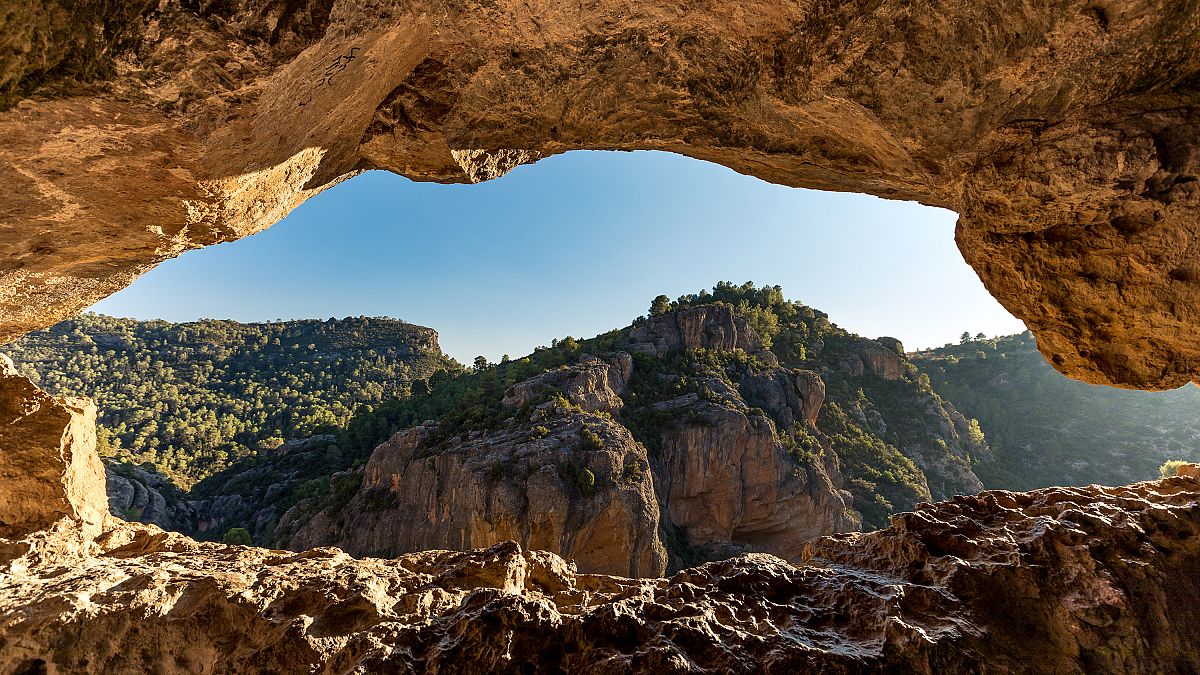
The Valencian Community is an ideal setting in which to enjoy the natural environment; its richness and variety of landscapes provide nature lovers and those who enjoy an active life with days filled with adventure and fun.
In recent years, the Valencian Community has become one of the main destinations in Spain for active tourism. With more than 2500 hours of sunshine a year and an average temperature of between 12ºC and 20ºC in winter and between 24ºC and 35ºC in summer, the Valencian region is a unique setting in which to enjoy fun days filled with hiking, mountain biking, horseback riding, birdwatching or kayaking, among many other things.
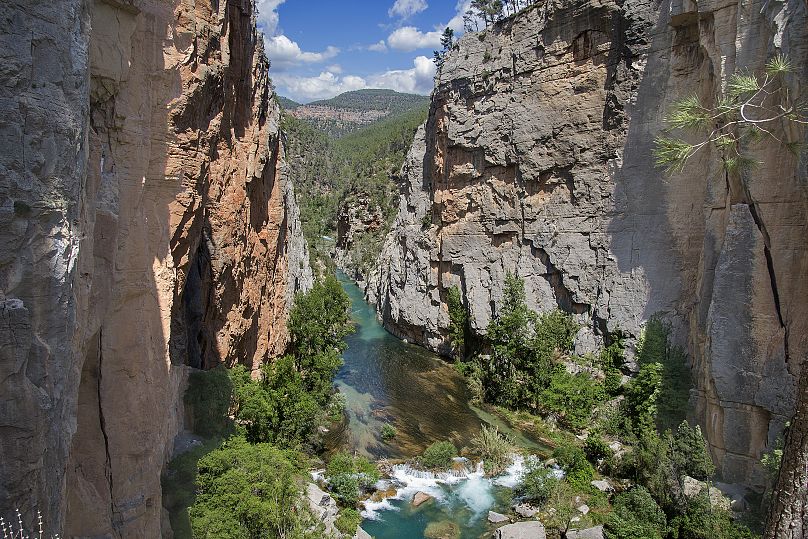
The Valencian Community has a total of 22 natural parks, spread across coastal and inland mountain ranges, islands, wetlands and even a Mediterranean riparian forest, the Turia Nature Park. It is also one of the most mountainous areas in Europe. Even though it does not exceed an altitude of two thousand metres, the region has spectacular orography. All this, together with the fantastic Mediterranean climate, accentuated by the north-south orientation of the region, provides numerous habitats with great biodiversity, giving these spaces an astonishing and incredible charm.
The region boasts incredible vistas from the dozens of villages perched on top of the hills, countless kilometres of blue water beaches, historic medieval castles, prehistoric caves full of cave paintings, royal ravines, ancient bridle paths, 13 greenways and an immense amount of hiking options.
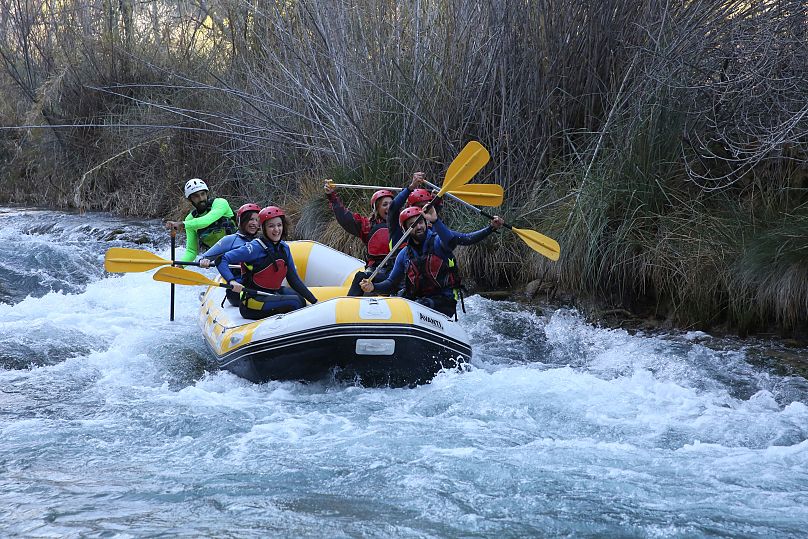
The most daring can go canyoning, bungee jumping or climbing. There is also a wide choice of activities for the whole family, such as canoeing, paddle boarding, rafting or multi-adventure sports. Trekking, hiking and Nordic walking is also an option for those who want to move at a more sedate pace.
The Valencian Community has more than 5000 km of trails between mountain ranges and valleys. There are paths along the cliffs that look out over the sea or that go into the mountains, long-distance trails that take more than a day to travel along, as well as short-distance trails.
There are also 13 greenways to choose from, totalling more than 200 km of charming old railway routes that are an absolute delight for cycling or hiking.
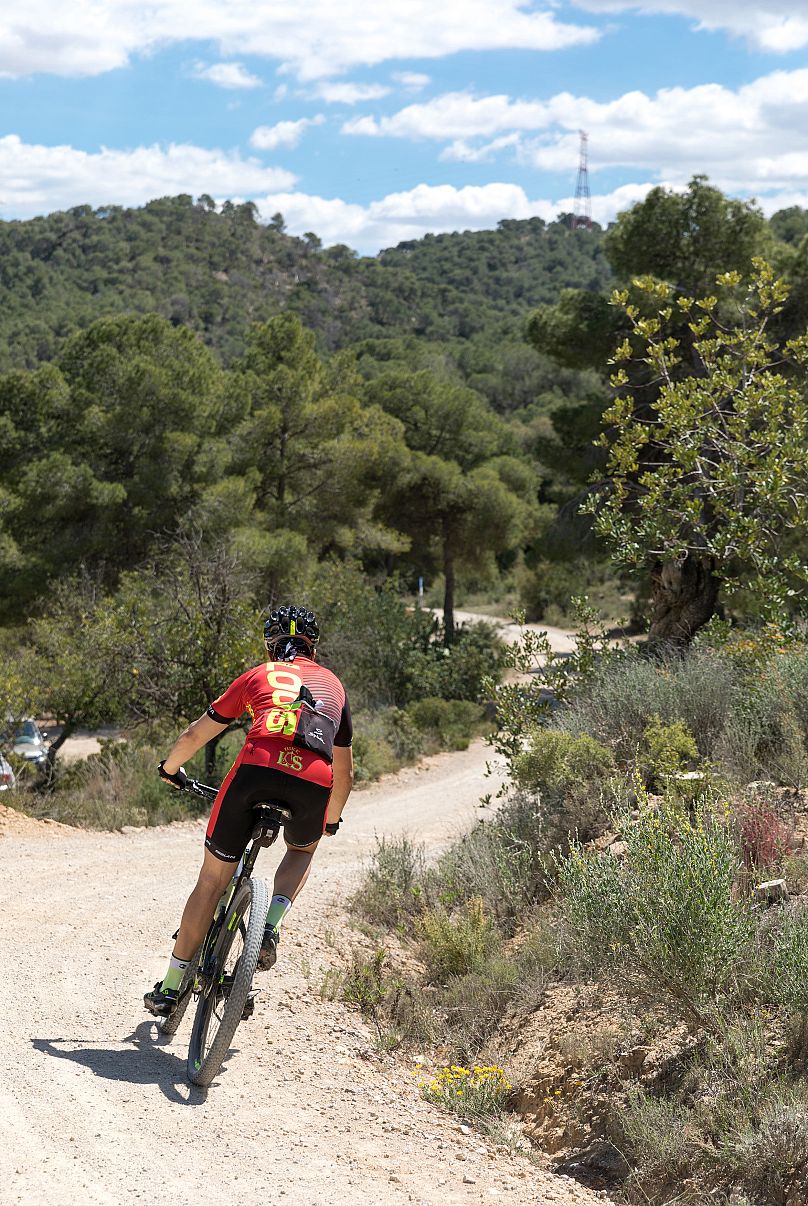
Touring the Valencian Community by bicycle is undoubtedly one of the most pleasant ways to enjoy its landscapes and explore its historical and natural heritage.
Those who are keen climbers will undoubtedly find paradise in Puig Campana, Penyagolosa and Cerro Calderón, or in the more than 20 perfectly preserved via ferratas that are scattered throughout the region. The numerous south-facing walls are ideal during the coldest months of the year.
You will also find well-equipped rock climbing routes for a wide variety of grades: from accessible trails to experiencing the high mountain environment on the renowned alpine trails.
For those who prefer to get wet, there are a number of navigable rivers, canyons, ravines and reservoirs that crisscross the area and where you can go paddle boarding or rafting.
In municipalities such as Sot de Chera, Alborache, Cofrentes, Onil, Ibi, Benitandús, Morella, Montanejos, San Miguel de Salinas, Sant Joan de Moró or Venta del Moro there are adventure parks that combine hanging bridges, zip lines, handrails or Tibetan bridges where you can enjoy a fun-filled day of adventure with the whole family.
There are a number of companies specialising in active tourism that provide the visitor with a safe experience and that offer a very extensive list of options for all tastes, from the more sedate and relaxed to others that are much more intense, but always suitable for people of all ages and physical conditions: multi-adventure routes, trekking, SUP (stand up paddle boarding) in rivers and reservoirs, slow cycling, archery, horseback riding, caving, paintballing... the variety of options is infinite and you can find out more about them all at https://activo.comunitatvalenciana.com/en/active-tourism-valencia-region
Share this article

Valencia or Seville: An Honest Comparison To Help You Decide!
I f you’re looking for fun in the sun, Spain is one of the best destinations to choose. It gets some of the best weather in the whole of Europe, as well as boasting fantastic food and thrilling cultural experience for every visitor.
Valencia and Seville easily rank as two of the top Spanish cities to see. They’re both situated in the southern part of the country, enjoying almost never-ending sunshine and high temperatures, and they both have some super touristic landmarks to check out.
At first glance, these cities may seem to have quite a lot in common. They’re both lively, bustling, beautiful places with decent nightlife scenes and delicious food. But when you start to look a little closer, some big differences begin to emerge.
In Valencia, for example, there’s the truly special City of Arts and Sciences, filled with awe-inspiring, otherworldly structures and fun activities. This city also has beaches – unlike Seville – and is generally better for families.
Meanwhile Seville is a historical haven, with Roman ruins and striking Moorish architecture. Expect a livelier nightlife scene here too, as well as a more romantic vibe due to the gorgeous buildings.
We’ll be highlighting all of those key differences throughout this guide as we put Valencia and Seville side-by-side in several key categories, including activities, nightlife, shopping, food, and much more.
By the end, you’ll have a much clearer picture of what these cities can offer and which one is best for you. Let’s get started!
- A Quick Overview
Which Is Best For Activities?
- Which Is Better For Festivals & Live Events?
Which Is Better For Day Trips?
Which is better for nightlife , which is best for shopping , which has the best food .
- Which Is Better For A Family Trip?
- Which Is Better For Couples?
Which Is Better For Backpackers?
Which is cheaper , where to stay according to your budget.
- Which Has Better Weather?
- Which Is The Better Choice?
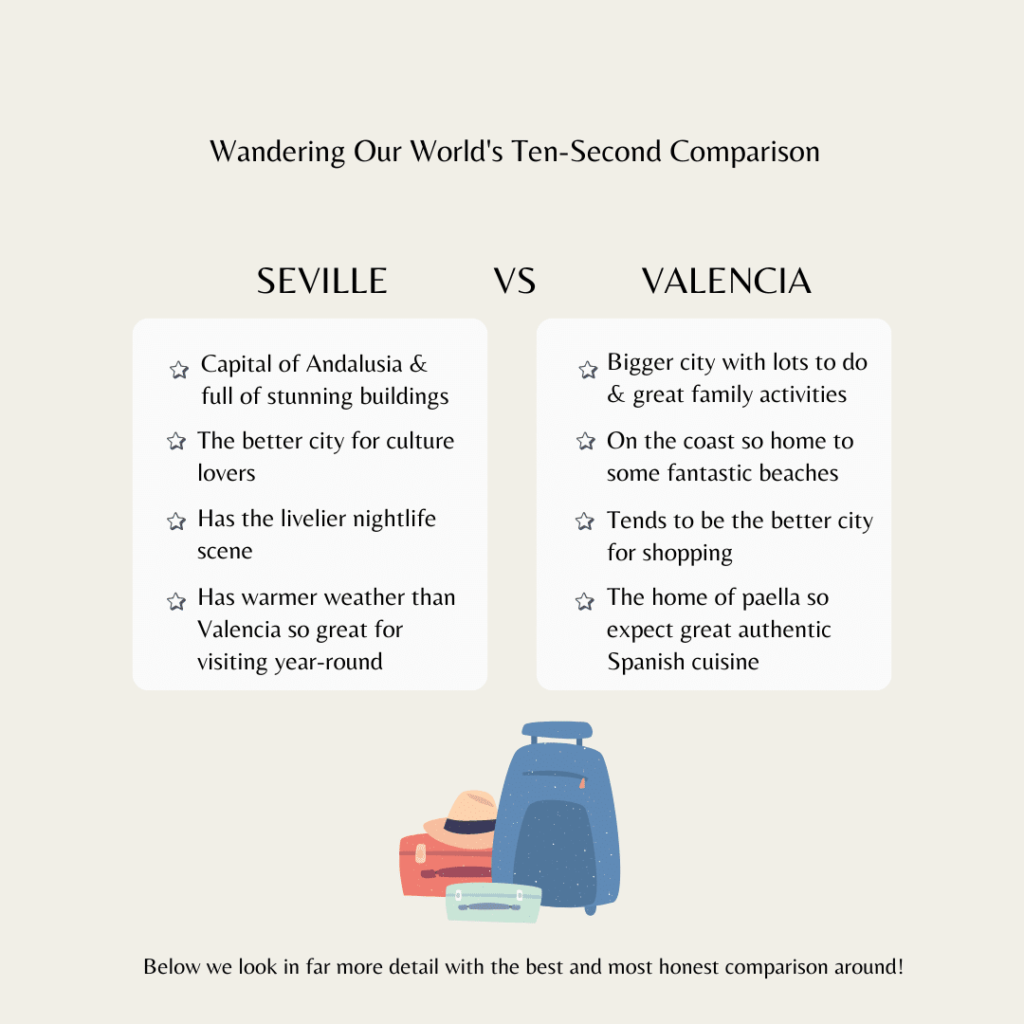
A Quick Overview: Valencia vs Seville
Valencia: a quick overview.
Valencia is Spain’s third-biggest city, trailing only Madrid and Barcelona in terms of its total population; nearly 800,000 people live here, with approximately 2.5 million in the metropolitan area.
The city itself is located in the southeast part of the country, right on the coast, with several miles of sandy beaches.
The history of Valencia goes back over 2,000 years. It was founded by the Romans in 138 BC, and grew slowly over the centuries, enduring many difficult moments.
However, in the 15th century, Valencia experienced its ‘Golden Age’, enjoying huge growth that saw the construction of many iconic landmarks, such as the Serranos Gate and Lonja de la Seda.
Nowadays, Valencia is famed for having a very busy container port and being a key trade hub for the Mediterranean region.
It’s also a cultural and tourist center, renowned for its great mixture of old landmarks and bold new developments, as well as being a popular place for live events and festivals.
Like many large Spanish cities, Valencia has a lively and welcoming vibe, and a lot of the locals here spend much of their time outdoors, soaking up the sun and giving the city a really vibrant, dynamic feel.
It’s also known for being one of Spain’s very best beach cities, with some truly world-class coastal conditions for visitors to enjoy.
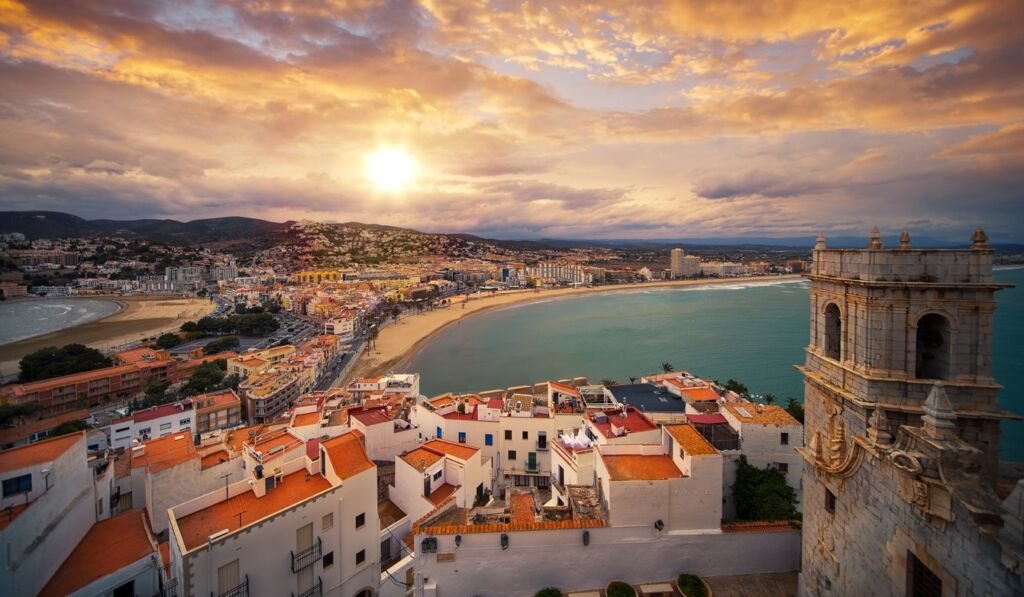
Seville: A Quick Overview
Seville (or Sevilla, in Spanish) is the fourth biggest city in Spain, with a total population just a little smaller than that of Valencia; around 700,000 people live here, with 1.5 million in the metropolitan area.
It’s situated in the southeast part of the country in the Andalusia region, of which it is the capital city.
Like Valencia, Seville’s origins date back to the time of the Roman Empire. It was founded under the name Hispalis, around 2,200 years ago.
In the 8th century, it fell under Islamic rule, and a group called the Almoravids later took over, building grand structures – many of which are still standing – and helping the city become a very beautiful and powerful location at the time.
Seville’s development and evolution continued further in the centuries that followed, with the city emerging as a key location of trade, culture, and economic prosperity.
It’s also known as the epicenter of Andalusian culture and expression – visitors here can enjoy lively traditional festivals, romantic Flamenco dancing, and unique Andalusian recipes.
Tourism is a big part of this city’s economy, and it’s often referred to as one of the most visually impressive cities in Spain.
Seville’s namesake oranges can be spotted growing on trees throughout the city, while a myriad of Moorish buildings, Roman remnants, and intriguing museums provide travelers with plenty of ways to pass the time.
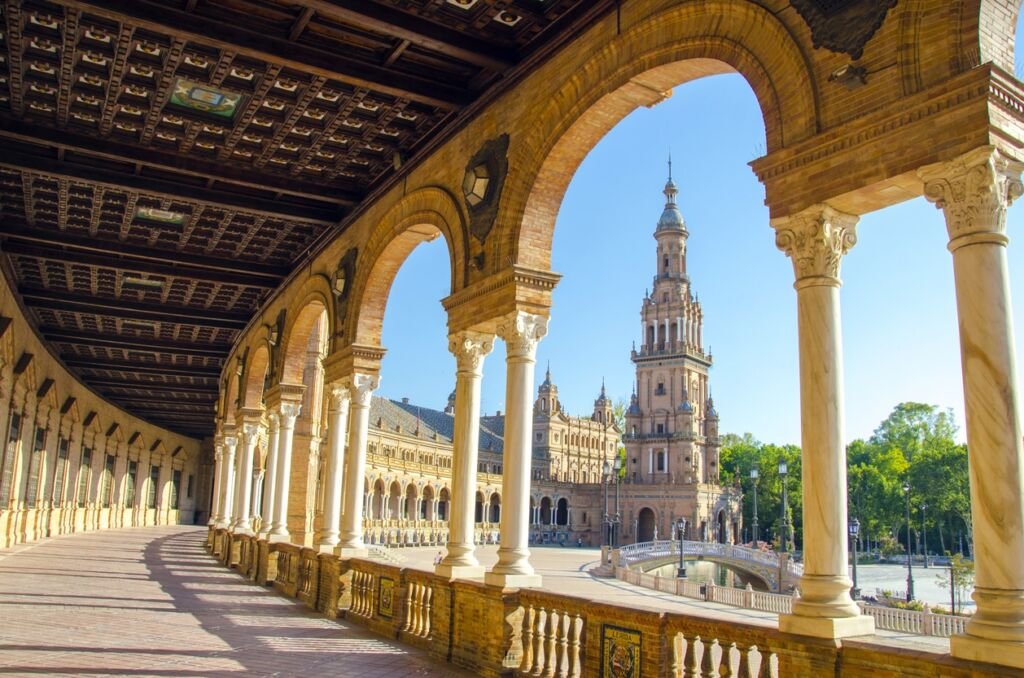
Arguably the most important factor for most people when deciding between two cities is: what do they have to offer? What can you actually do in both of these locations, and what are the very best experiences to have and most impressive landmarks to see?
Well, both Valencia and Seville have plenty of activities and attractions to keep you busy for a few days or even a full week.
But there are some notable differences in this area; Seville, for example, has a wealth of grand historic buildings, including everything from Ancient Roman ruins to Moorish palaces, as well as many churches and one of the world’s biggest cathedrals.
In comparison, even though Valencia has quite a sizable historic center, it doesn’t have quite as many breathtaking historic buildings. Instead, the true star of the show in this city is the ultra-modern City of Arts and Sciences complex, made up of various structures with mind-blowing designs.
Let’s take a closer look at some of the main activities and attractions you can enjoy on your visit to either Valencia or Seville.
Valencia: The Activities
As stated above, the biggest highlight of Valencia has to be the City of Arts and Sciences.
Classed among the 12 Treasures of Spain, this extraordinary park has cost close to €1 billion to create and is made up of a selection of fantastical and futuristic buildings, each housing something different.
There’s L’Hemisfèric, for example, which has its own planetarium and enormous IMAX movie theater, as well as L’Umbracle, with its slender arches perched above a garden, filled with local flora and decorated with artistic sculptures.
You’ll also find a massive opera house here, along with the biggest oceanographic aquarium in Europe and a stunning science museum.
The City of Arts and Sciences really steals the spotlight, but it’s not Valencia’s only treasure.
This city also has some beautiful buildings that date back several centuries, like its fabulous cathedral and the famous Lonja de la Seda (Silk Exchange). The Mercat Central is also worth a visit, and Valencia has many museums focusing on art, history, and more.
Prefer to spend time outside? Valencia has got you covered. It’s one of Spain’s leading beach cities, with the Playa de Las Arenas just a short walk from the city center and several other brilliant beaches right nearby.
T his is a big plus point for Valencia, as Seville is situated inland, over an hour from the coast.

Seville: The Activities
Seville’s long history and wide range of impressive buildings provide plenty of scope for sightseeing, and visitors will want to start off in the Barrio de Santa Cruz area.
This winding web of narrow streets takes you right to the historic heart of the city, with several pretty churches and charming plazas to discover along the way.
Visitors to this city won’t want to miss out on a visit to the extraordinary Alcazar Palace – this is one of the best examples of the city’s distinctive Mudejar architectural style, which blends Islamic, Renaissance, and Gothic elements.
The palace also has extensive, picturesque gardens, and it’s been used as a filming location for shows like Game of Thrones.
Other must-see landmarks include the General Archive of the Indies, which is by far one of the most striking buildings in Seville, as well as Seville Cathedral, where Christopher Columbus lies in rest.
There’s also the Giralda bell tower, which was once a minaret, the Torre del Oro watchtower, the Royal Tobacco Factory, and the Palacio de las Duenas.
Seville also has an array of museums, like the Archaeological Museum and the Museum of Fine Arts, and you can learn more about Andalusia at the Flamenco Art Museum, Bullfighting Museum, or Andalusian Art Center. Plus.
And while Seville may not have any beaches, it has some fabulous parks and gardens, like Maria Luisa Park and Parque del Alamillo y San Jerónimo.
Overall, it’s clear to see that Valencia has the edge in terms of diversity, providing a nice mix of history, modernity, and all of those lovely beaches to soak up the sun.
However, if history and culture are what you’re looking for, Seville is the place to be, with so many churches, museums, and historic structures to admire.
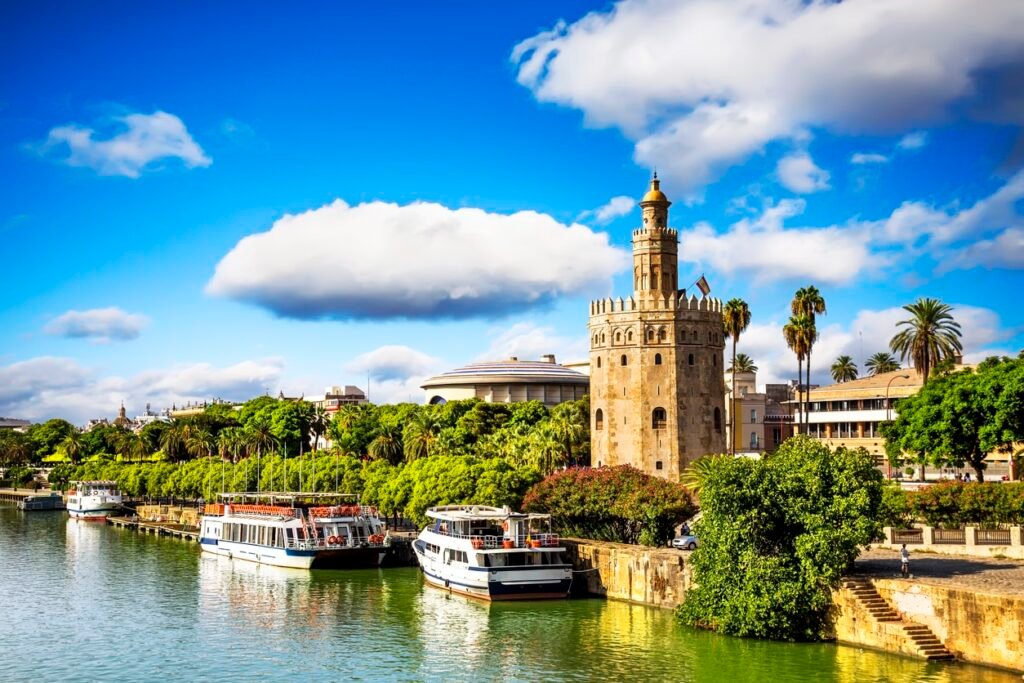
Which Is Better For Festivals & Live Events?
Both Valencia and Seville are famous for their festivals. These cities really come alive at certain times of the year, with parades, fireworks, music, dancing, and more.
And, if you time your visit just right, you can participate in all of those fun things! But which city is the top spot for fiestas and celebrations?
Well, Valencia’s most famous celebration is the Fallas. This is held every March, involving pyrotechnic displays and the creation of artistic monuments – called Fallas – which decorate the streets, before being burned as the event comes to a close on its final day. This UNESCO-listed event is one of Spain’s best cultural experiences.
This city also has terrific Holy Week – or Semana Santa – celebrations, along with a grand July Fair that lasts the whole month, incorporating fireworks and even a fun ‘Battle of the Flowers’, where people parade through the streets on flower-covered floats before plucking and throwing the flowers into the crowd.
Not to be outdone, Seville also has several famous festivals. The city’s Holy Week is known far and wide as the biggest in all of Spain, with multiple parades and processions passing through the city’s streets, along with traditional music and artistic displays.
For religious people, or simply those with an interest in Spanish culture, it’s a very moving and powerful event.
Given that Seville is the capital of Andalusia, it also hosts major Flamenco dance events, like the Bienal de Flamenco, which is one of the largest festivals of its kind in the world.
There’s also the April Fair, also known as Seville Fair, which involves colorful outfits, dancing, amusements for children, and parties throughout the day.
In terms of other live events, Valencia has opera, concerts, and sport, with a successful football team. Seville, meanwhile, has the aforementioned Flamenco dances, many live theatrical performances, and not one, but two successful football teams for sports fans to check out.
Overall, both cities are exceptional for live entertainment and festivities.
The Valencia Fallas is undoubtedly one of the best celebrations in the whole of Spain, but many travelers will also fall in love with Seville’s lively Flamenco dances and religious processions.

Clearly, there’s lots to do during the daytime in both Valencia and Seville, but how about the night?
Well, Valencia has a spectacular nightlife scene, often classed among the best cities in Spain for clubs and bars.
You can take your pick from any of the many nightlife hotspots throughout the Barrio del Carmen, or head down to the sands for wild summer beach parties.
Seville also ranks among Spain’s best nightlife cities, with its own admirable collection of nightclubs and bars. In fact, this city’s nightlife scene is pretty rowdy, with many locals and tourists staying out until 6am in areas like Alfalfa and La Alameda.
There are some intense dance clubs here, and even serious party-lovers might be surprised at how lively Seville can be.
Overall, if you’re looking for a good night out, you won’t be disappointed with either one of these cities.
Seville is a little more hardcore, but Valencia has a fun mix of crazy clubs and more laid-back cocktail lounges.

Feel like leaving Seville or Valencia behind for a day and seeing some other parts of Spain during your visit? If so, you have quite a few options to choose from, as both of these cities have good transport links with the surrounding area.
From Valencia, it’s common for travelers to take day trips to the historic hub of Sagunto, where you can tour an enormous, expansive castle.
Castellón de la Plana is another charming city to visit for a day, and the Albufera Natural Park is a dream location for outdoor adventurers – only 10km from the city, this place is home to Spain’s biggest lagoon for boat trips and more.
From Seville, there are so many options! You could try Jerez to taste amazing sherry and visit a Moorish fortress, for example, or tour the breathtaking city of Ronda, set atop a dramatically deep gorge.
Or, if you want to visit a big city and see the beach at the same time, hop on the train to whitewashed Huelva or the sun-drenched summer-loving city of Malaga.
Overall, both cities have super day trip destinations within easy reach, but Seville might just have the edge, thanks to its wider range of big cities, small villages, and natural areas.

Valencia and Seville are both great shopping cities, with long, pedestrianized thoroughfares, filled with big-brand stores, luxury boutiques, fashion halls, and more.
In Valencia, shopaholics will want to head to the Calle Colon, the city’s primary shopping street – here, you’ll find all the big Spanish and Euro high-street brands.
The city’s Mercat Central is one of the biggest covered markets in all of Europe, while Calle Don Juan is great for high-end fashion and Plaza Redonda is fun for buying gifts and souvenirs
Over in Seville, the Calle Sierpes is the main shopping street, and it’s a top spot for snagging some quirky souvenirs or Spanish fashion.
The Calle Tetuan and Calle Asuncion are also pleasant places to browse major brand stores, while the Calle Feria is best for quirky gifts and unusual finds.
Overall, it’s a close call, but Valencia just about takes the win here, with slightly more exciting markets and a deeper shopping scene overall.

No matter whether you pick Valencia or Seville, you’re guaranteed to have some delicious meals, as both of these cities serve up some of the finest Spanish cuisine.
However, there are some interesting regional specialties to try in each location, and you may have a slight preference for one over the other.
Valencia is the home of paella, and it’s one of the best places on the planet to eat this classic rice dish.
It also has a super menu of additional local delicacies, like fideua – similar to paella, but with noodles – and orxata – a sweet milky drink, adored by the locals. You can get some great sweet treats here too, and there are restaurants, cafes, and bakeries for all budgets.
Seville might not have invented anything quite as iconic as paella, but it’s still got a super food scene. It’s got some of the best tapas bars in all of Spain, with local favorites including fried squid and grilled meat.
This city is also terrific for sampling Andalusian specialties, like gazpacho soup and exceptional seafood, along with some of Spain’s finest wines.
Overall, there’s no clear winner here, and it all comes down to personal taste.
If you want to taste the world’s finest paella, head to Valencia. But if you love the Spanish habit of snacking on tapas, choose Seville instead.

Which Is Better For A Family Trip?
If you’re heading to Spain with children, Valencia is one of the best destinations to choose.
Kids will marvel at the astonishing structures of the City of Arts and Sciences, and there are numerous fun things for families to do together, like meeting the animals at the city’s wonderful Bioparc zoo or admiring marine life in the gigantic Oceanografic aquarium.
Valencia’s Science Museum is also super for kids of various ages to learn about the world around them, while little ones will love the fairy-tale style Gulliver Park and active families can spend hours exploring the Turia Gardens or playing games and swimming in the sea at Valencia’s beaches.
Over in Seville, there are lots of fun play areas dotted across the city, and kids can have fun exploring the sci-fi style Setas de Sevilla structures.
Children can also appreciate the historic palaces and towers of Seville, as well as its science museum and aquarium, among a few other attractions.
Overall, even though Seville isn’t a bad choice for a family trip, Valencia is even better.
It has lots of great things to do for kids of any age, including very young ones, and it also has the key advantage of being right by the sea.

Which Is Better For Couples?
For couples, the choice between Valencia and Seville really comes down to personal preference, as both of these cities can work equally well for romantic getaways and city breaks with someone special.
In terms of romance and beauty, Seville is the clear winner. It’s a sublime city, with so many amazing structures and grand buildings that simply make you stop and stare, and it’s the ideal place for long walks, hand-in-hand with your loved one.
It’s also a dream destination for history lovers, with so many museums to explore and landmarks to check off your list.
Then, there’s Valencia. It may not be as flawlessly attractive as Seville, but this city has lots of things to do.
For active and energetic couples, Valencia is a great place to be, and you can fill up your travel itinerary with trips to the City of Arts and Sciences, tours of the Old Town, and visits to the beach.
Again, it’s tricky to decide on a clear victor here. For traditional romance and unique cultural experiences, choose Seville. For a more diverse selection of activities, including beaches, opt for Valencia.
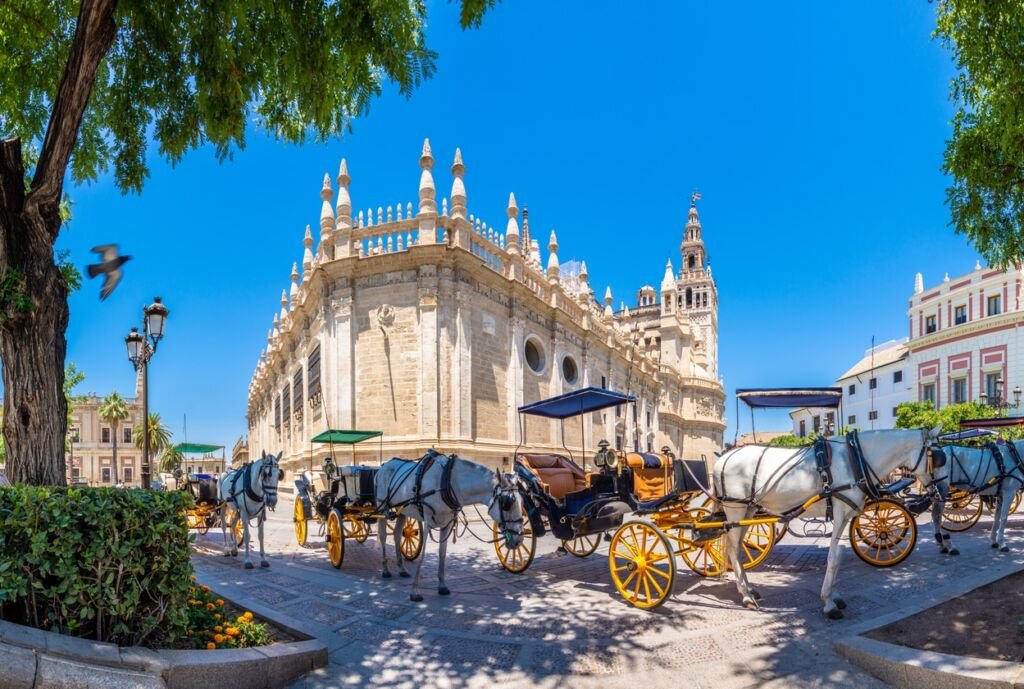
Spain is a great place to backpack, and many of its large cities – including Valencia and Seville – are very safe and welcoming places for travelers from all over the world, with plenty of hostels and warm, friendly locals waiting to greet you.
Valencia has a super selection of hostels around its center, and the local public transport is pretty reliable, so you can easily make your way around and see all the sights with minimal fuss.
It’s also got a solid nightlife scene for backpackers who like to party, and quite a lot of free ways to spend your time, like a day at the beach or a walk in Turia Gardens.
In Seville, you’ll also find no shortage of safe, budget-friendly hostels, and this city is a little more compact, with many of the main landmarks, museums, and sightseeing spots all clustered together, so you may not need to use public transport at all.
The tapas scene is also terrific for backpackers, and it’s a great way to meet some locals or mingle with fellow travelers.
Overall, both cities are great for backpackers and budget-conscious travelers, but Seville’s simple layout and plentiful tapas bars give it the edge.

Finally, let’s discuss costs, as you might be eager to know which one of these two cities is the cheapest to visit.
Well, the fact of the matter is that average prices for Seville and Valencia are more or less identical.
When we look at typical hotel rates, menu prices in restaurants, public transit costs, and even the prices for tours and activities, the two cities are almost exactly aligned with one another, so you won’t need to worry about spending significantly more if you choose Valencia over Seville, or vice versa.
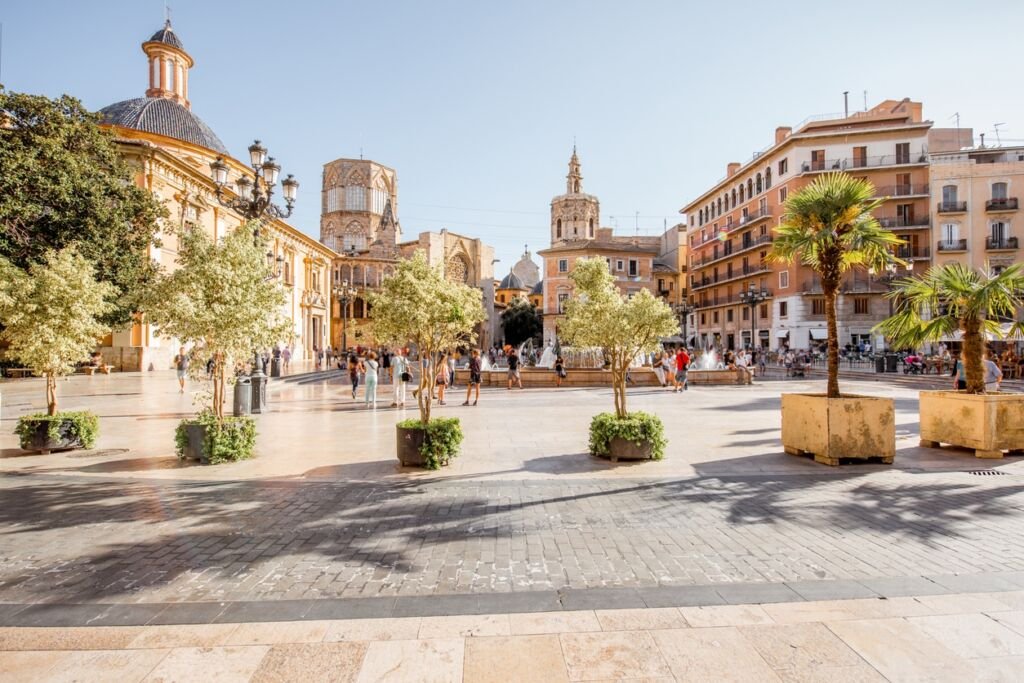
Budget: The 3-star Soho Valencia is a classy hotel in a fantastic central location. Considering the price, location and modern set-up, this hotel easily has one of the best price-quality ratios in the city. See photos and rates!
Luxury: For a taste of luxury in a quirky hotel full of character, then the five-star MYR Palacio Vallier is a must. The location of this boutique hotel is excellent, the service is superb, and the food is excellent. See photos and rates!
Budget: Set in a 16th century building, Hotel Posada del Lucero is located directly in the city’s old town and despite its very reasonable prices, it comes with gorgeous decor, fantastic service and even an outdoor pool. See photos and rates!
Luxury: With world-class service and a gorgeous outdoor pool, Hotel Alfonso XIII is a luxury stay in one of Spain’s most prestigious hotels. The rooms are photogenic and classy, while the location is perfect. See photos and rates!
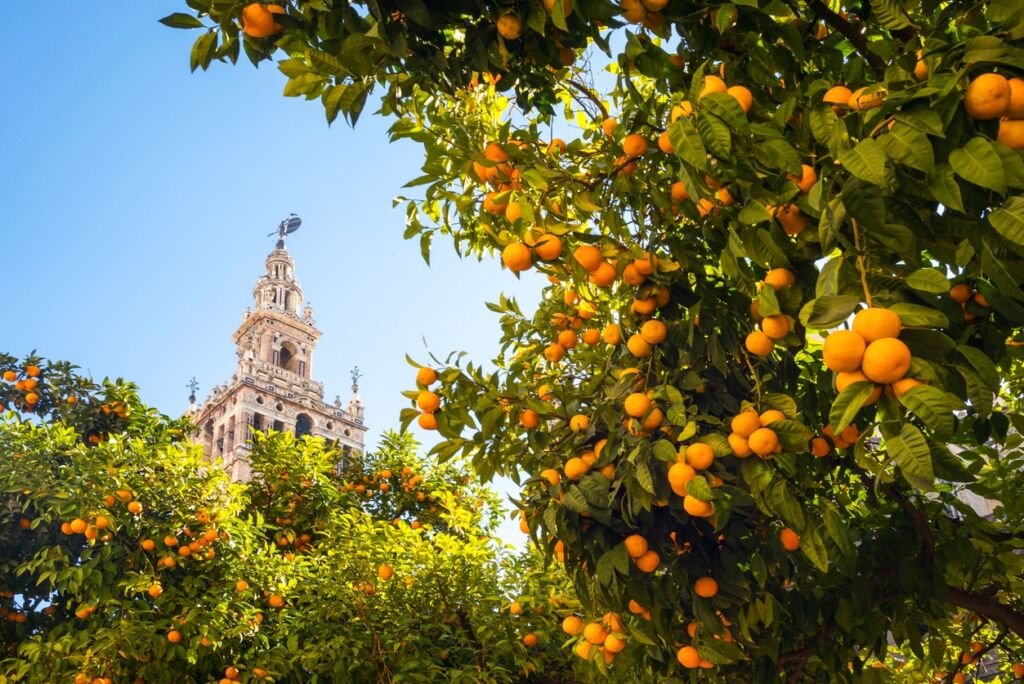
Which Has The Best Weather?
As well as all of the gorgeous architecture and tasty food, the wonderful weather of Spain is one of the key reasons why it’s one of Europe’s most-visited countries. But which city gets the best weather, between Valencia and Spain?
Well, since both of these cities are situated in the southern half of the country, it should come as no surprise that they both see a whole lot of sunshine. However, since Seville is significantly further south, it gets the hottest temperatures, by far.
During the peak summer months, temperatures can approach 100°F (38°C) in Seville. In contrast, average summer highs for Valencia are around 86°F (30°C). So, as we can see, there’s a pretty big difference!
Seville has even been nicknamed the ‘Frying Pan of Europe’, due to its almost overwhelming heat, and some travelers may simply want to avoid the summer months entirely! Valencia, meanwhile, is more bearable.
Winter temperatures are quite similar for both of these cities, but Seville gets more heat in spring and fall.
So, if you want to avoid the summer crowds but still enjoy warm temperatures, Seville is the place to be.
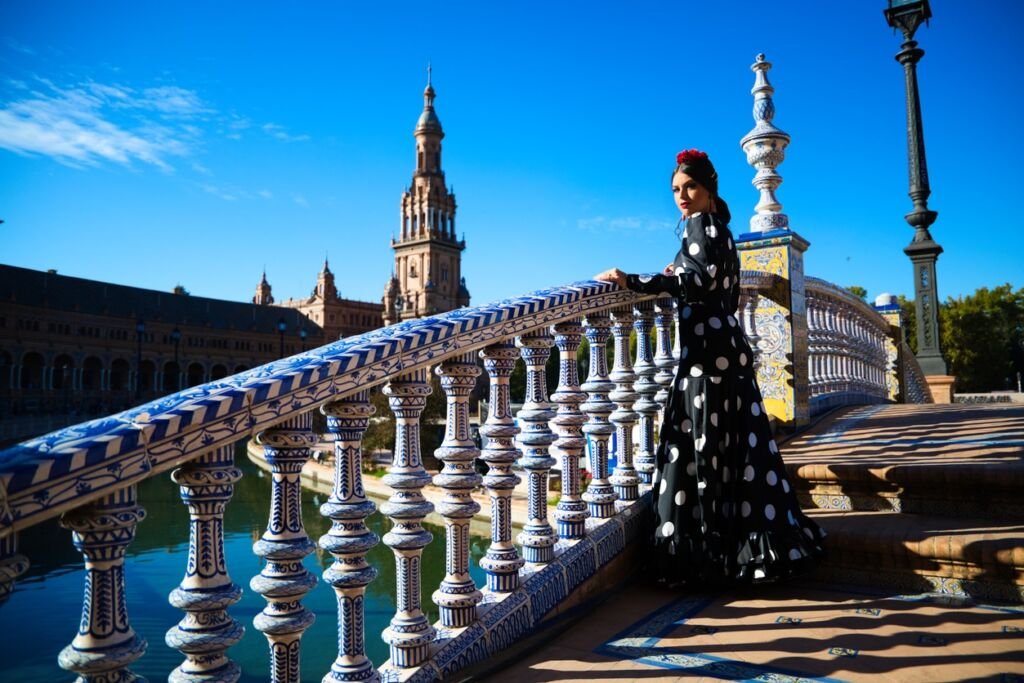
Valencia vs Seville: Which Is The Better Choice?
Before we announce our grand winner of this comparison, it’s important to state that both of these cities are 100% worth visiting.
They’re wonderful places where you can see, taste, and experience some of the very best things that Spain has to offer.
With that said, Valencia is probably the better choice for most travelers for two main reasons. Firstly, it has a wider range of activities to please people with different tastes.
Secondly, it’s on the coast, so you can simply walk to the beach and stretch out on the sand whenever you feel like it, which is such a big advantage, especially with Spain’s sunny, warm weather.
Nevertheless, Seville is still a fantastic city. It’s more scenic than Valencia, with a distinctly romantic vibe in the air, making it an idyllic destination for couples.
Seville also has countless historic landmarks to check out, along with all of those awesome Andalusian customs and traditions.
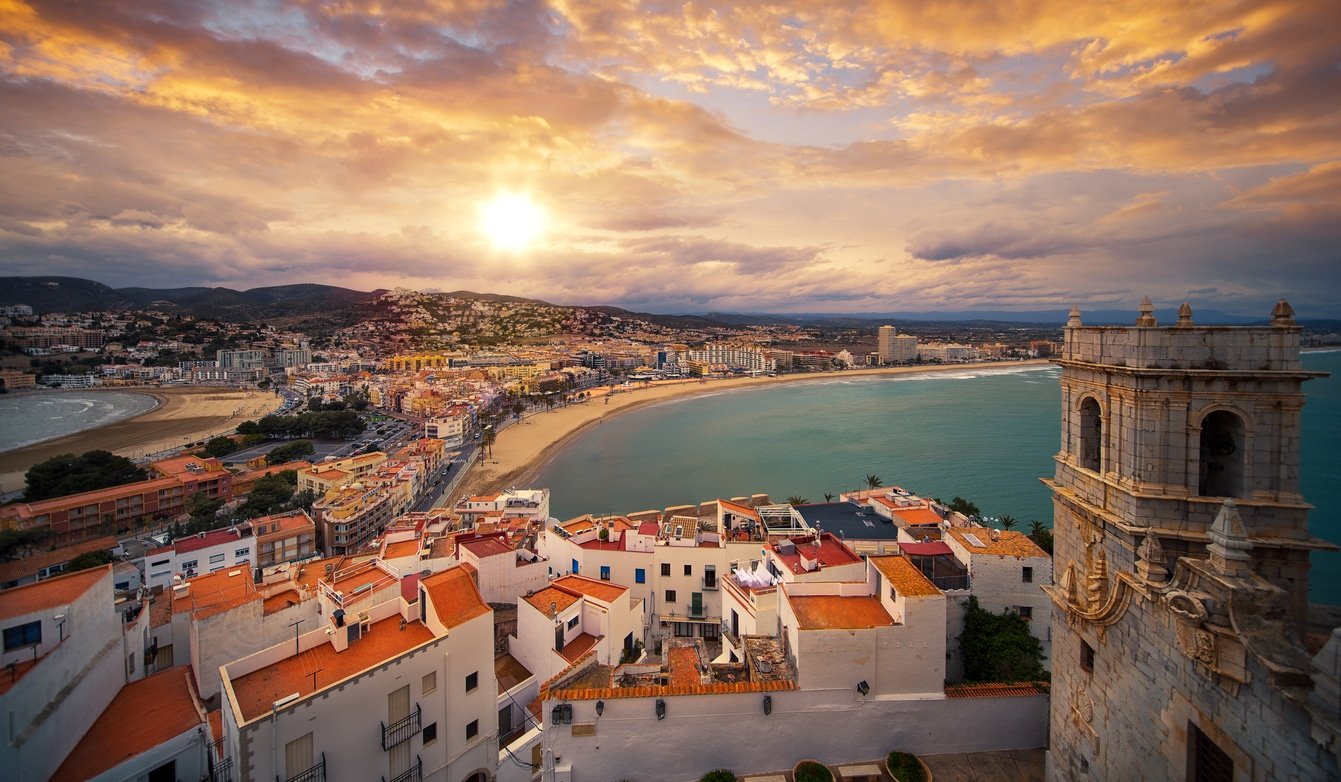
Related Posts
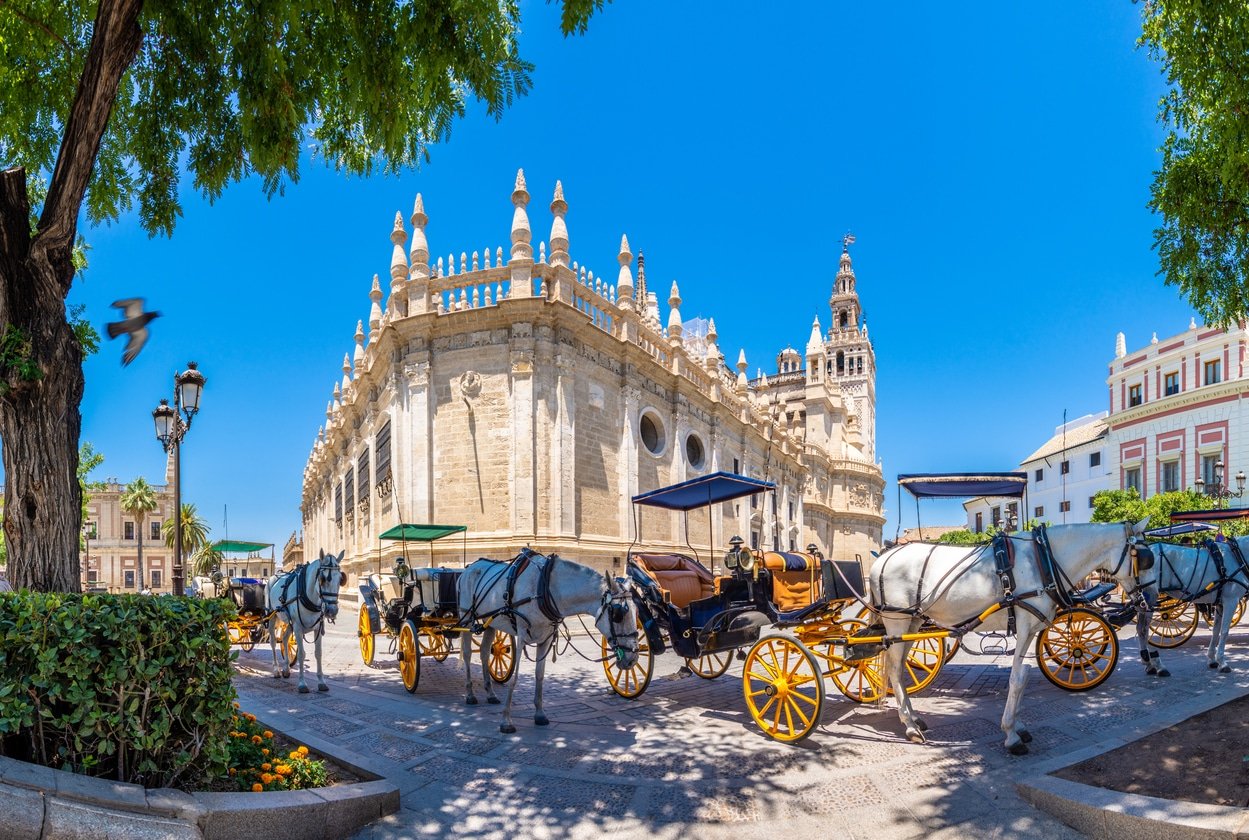
Seville or Madrid: An Honest Comparison To Help You Choose!
Seville or barcelona: an honest comparison to help you choose.

Valencia or Barcelona: An Honest Comparison To Help You Decide!

Lorem ipsum dolor sit amet, consectetur adipisicing elit sed.
Follow us on
- Diversity, Equity & Inclusion at Delta
- Racial and Ethnic Diversity
- LGBTQ+ Diversity
- People with Disabilities
- Veterans and the Military
- Sustainability
- Awards & Recognition
- Global Partners
Delta Air Lines (NYSE: DAL) today reported financial results for the March quarter and provided its outlook for the June quarter. Highlights of the March quarter, including both GAAP and adjusted metrics, are on page five and incorporated here .
“Thanks to the extraordinary work of our 100,000 people, Delta is delivering the best operational reliability in our history, and we have widened the gap to our competitors. We were thrilled to recognize their efforts with $1.4 billion in profit sharing payouts during the quarter,” said Ed Bastian, Delta’s Chief Executive Officer.
"For the March quarter, we delivered record revenue on outstanding operational performance, enabling strong earnings growth. We anticipate continued strong momentum for our business, and in the June quarter, we expect to deliver record revenue, a mid-teens operating margin and earnings of $2.20 to $2.50 per share. We remain confident in our full year targets for earnings of $6 to $7 per share and free cash flow of $3 to $4 billion."
March Quarter 2024 GAAP Financial Results
- Operating revenue of $13.7 billion
- Operating income of $614 million with an operating margin of 4.5 percent
- Pre-tax income of $122 million with a pre-tax margin of 0.9 percent
- Earnings per share of $0.06
- Operating cash flow of $2.4 billion
- Payments on debt and finance lease obligations of $712 million
- Total debt and finance lease obligations of $19.4 billion at quarter end
March Quarter 2024 Adjusted Financial Results
- Operating revenue of $12.6 billion, 6 percent higher than the March quarter 2023
- Operating income of $640 million with an operating margin of 5.1 percent
- Pre-tax income of $380 million with a pre-tax margin of 3.0 percent
- Earnings per share of $0.45
- Operating cash flow of $2.5 billion
- Free cash flow of $1.4 billion
- Adjusted debt to EBITDAR of 2.9x, down from 3.0x at the end of 2023
- Return on invested capital of 13.8 percent on a trailing five quarter average, up 2.8 points over prior year.
Read the full release on PR Newswire or via download .
Forward Looking Statements
Statements made in this press release that are not historical facts, including statements regarding our estimates, expectations, beliefs, intentions, projections, goals, aspirations, commitments or strategies for the future, should be considered “forward-looking statements” under the Securities Act of 1933, as amended, the Securities Exchange Act of 1934, as amended, and the Private Securities Litigation Reform Act of 1995. Such statements are not guarantees or promised outcomes and should not be construed as such. All forward-looking statements involve a number of risks and uncertainties that could cause actual results to differ materially from the estimates, expectations, beliefs, intentions, projections, goals, aspirations, commitments and strategies reflected in or suggested by the forward-looking statements. These risks and uncertainties include, but are not limited to, the possible effects of serious accidents involving our aircraft or aircraft of our airline partners; breaches or lapses in the security of technology systems we use and rely on, which could compromise the data stored within them, as well as failure to comply with evolving global privacy and security regulatory obligations or adequately address increasing customer focus on privacy issues and data security; disruptions in our information technology infrastructure; our dependence on technology in our operations; increases in the cost of aircraft fuel; extended disruptions in the supply of aircraft fuel, including from Monroe Energy, LLC (“Monroe”), a wholly-owned subsidiary of Delta that operates the Trainer refinery; failure to receive the expected results or returns from our commercial relationships with airlines in other parts of the world and the investments we have in certain of those airlines; the effects of a significant disruption in the operations or performance of third parties on which we rely; failure to comply with the financial and other covenants in our financing agreements; labor issues; the effects on our business of seasonality and other factors beyond our control, such as changes in value in our equity investments, severe weather conditions, natural disasters or other environmental events, including from the impact of climate change; failure or inability of insurance to cover a significant liability at Monroe’s refinery; failure to comply with existing and future environmental regulations to which Monroe’s refinery operations are subject, including costs related to compliance with renewable fuel standard regulations; significant damage to our reputation and brand, including from exposure to significant adverse publicity or inability to achieve certain sustainability goals; our ability to retain senior management and other key employees, and to maintain our company culture; disease outbreaks, such as the COVID-19 pandemic or similar public health threats, and measures implemented to combat them; the effects of terrorist attacks, geopolitical conflict or security events; competitive conditions in the airline industry; extended interruptions or disruptions in service at major airports at which we operate or significant problems associated with types of aircraft or engines we operate; the effects of extensive government regulation we are subject to; the impact of environmental regulation, including but not limited to regulation of hazardous substances, increased regulation to reduce emissions and other risks associated with climate change, and the cost of compliance with more stringent environmental regulations; and unfavorable economic or political conditions in the markets in which we operate or volatility in currency exchange rates.
Additional information concerning risks and uncertainties that could cause differences between actual results and forward-looking statements is contained in our Securities and Exchange Commission filings, including our Annual Report on Form 10-K for the fiscal year ended December 31, 2023. Caution should be taken not to place undue reliance on our forward-looking statements, which represent our views only as of the date of this press release, and which we undertake no obligation to update except to the extent required by law.
Not finding what you need?
Sign up for Mission Local's free daily newsletter to stay informed about all goings-on in the Mission District and San Francisco.

Mission Local
Local news for a global city
More businesses join legal battle vs. Valencia center bike lane

Share this:
- Click to share on X (Opens in new window)
- Click to share on Facebook (Opens in new window)
- Click to share on Reddit (Opens in new window)
- Click to share on WhatsApp (Opens in new window)
- Click to email a link to a friend (Opens in new window)
- Click to print (Opens in new window)

Four additional businesses have joined the legal battle opposing the Valencia Street bike lane and filed claims against the city, their attorney Jim Quadra announced at a press conference today.
The businesses — Consumer Auto Body Inc., Tunisian restaurant Gola, Vietnamese fusion restaurant Chic n’ Time, and the closed Phoenix Irish Bar — join three businesses that filed claims in February, contending that street changes that accompanied the new center bike lane have been damaging for business by diverting traffic and limiting parking.
“There should be several more [claims] coming,” Quadra said, speaking at the closed music venue Amado’s on Thursday morning. At least one other business owner who has not yet filed a claim also appeared in solidarity.
The city denied the claims filed by Rossi Art Gallery, Mediterranean restaurant Yasmin, Amado’s, he added, and those business owners are now considering a lawsuit.
A claim is a request for damages or compensation. If the recipient of the claim denies it, the complainant can then file a formal lawsuit to be heard in court.
“When we filed the claims, we hoped that the city would reach out and discuss with us how to remedy this problem,” Quadra said, “but instead they just denied the claims without reaching out, without contacting us, without showing any interest on the impact that this is having on businesses on Valencia.”

The city has 45 days to respond to the new claims. If a lawsuit is ultimately filed, Quadra said the businesses would seek damages for their alleged financial losses due to the bike lane.
A Mission Local analysis found limited evidence that the street changes had a significant impact on business along the commercial corridor.
While sales did drop slightly for the first time in the second quarter of 2023, around the time the bike lane was being implemented, that was the case for much of the 94110 zip code, not just Valencia Street. And overall sales tax increased on Valencia during the construction of the bike lane last summer from the previous quarter.
But the business owners maintain that business is down 30 to 50 percent, Quadra said, and attribute that decline to the new bike lane and other street changes. No evidence of such a decline was provided, besides recent business closures along the corridor.
The city, Quadra said, failed to appropriately assess impacts of the bike lane and parking changes before implementing them last year.
City officials have not claimed responsibility for the alleged drop in business, but say they are assessing the pilot program’s impacts.
“We have talked to the parklet operators on Valencia and received their feedback about their loading needs to inform the design process,” said Municipal Transportation Agency spokesperson Erica Kato. “Our outreach and collaboration will continue through the spring, as we work on solutions that best protect both businesses and bicyclists on the corridor.”
In its first three-month evaluation issued in February, the MTA noted some improvements, like smoother bike traffic with less exposure to vehicle traffic, and less double-parking. But while potential impacts on businesses were not addressed, the report showed that foot traffic dropped slightly three months after implementation, bike traffic increased slightly, and vehicle traffic dropped 17 percent.
Quadra said that the three businesses that previously filed claims allege that the city has retaliated against them since filing the claims. Amado’s owner David Quinby said that his parklet was torn down by the city in recent weeks. Eiad Eltawil, who owns both Yasmin and Rossi, began a hunger strike on Sunday, and said his long-delayed parklet application was suddenly approved.
In a statement, City Attorney’s Office spokesperson Alex Barrett-Shorter said: “The three claims filed in February were denied. Regarding the new claims filed, we are reviewing the claims and will respond in the appropriate timeframe.”

Eleni Balakrishnan
REPORTER. Eleni reports on policing in San Francisco. She first moved to the city on a whim more than 10 years ago, and the Mission has become her home. Follow her on Twitter @miss_elenius.
Leave a comment
Your email address will not be published. Required fields are marked *
We've recently sent you an authentication link. Please, check your inbox!
Sign in with a password below, or sign in using your email .
Get a code sent to your email to sign in, or sign in using a password .
Enter the code you received via email to sign in, or sign in using a password .
- Subscribe to our newsletter
Sign in with your email
Lost your password?
Try a different email
Send another code
Sign in with a password
By signing up, you agree to our Terms and Conditions.
8 found in unlicensed plastic surgery recovery home in Florida, woman charged: Reports

A Florida woman has been accused of running an unlicensed post-op recovery home for those who have received cosmetic surgery, multiple outlets reported.
Daaiyah Alneesha Roundtree, 43, was arrested Tuesday after the Miami-Dade Police Department searched her home in South Miami, according to Local 10.
There were seven post-operative patients and one person awaiting a procedure at the house, according to a report obtained by NBC 6 . The patients told police they received help with personal hygiene care, eating and medication at $250-$350 per night.
Local 10 reported the home catered to patients receiving cosmetic surgery.
Roundtree faces the felony charges of operating an assisted living facility without a license, Florida litter law and hazardous waste violations, as well as two related misdemeanors, court records show. Her arraignment is scheduled for May 9. Her attorney information was not immediately available.
Illegal plastic surgery recovery home: 2 women charged after operating unlicensed cosmetic surgery recovery house in Miami
Cosmetic surgery's impact on medical tourism
Roundtree is not the only one in recent months to receive criminal charges for allegedly running an illegal post-op recovery center in Miami. Two women were charged in October 2023 in an operation known as "Yeni's House. "
Cosmetic surgeries have seen an uptick in recent years and more specifically there appears to be a growing number of people who are traveling to get these procedures .
Traveling after a major surgery can be risky, as sitting for a long time or flying can increase risk of blood-clots . UCLA Health encourages plastic surgery patients to have a caretaker for the first few days after the procedure.
As the Miami Herald reported , a service for this is not widely available, so people coming to Miami from out of town for these elective surgeries must find post-surgery recovery arrangements until their wounds heal.
Florida law does not license for this specific service, the Herald reported, but there is a statute that defines assisted living facility as a facility that provides personal services for more than 24 hours to one more adults who are not adults of the owner of the facility.
Contributing: Bailey Schulz, USA TODAY

IMAGES
COMMENTS
Our experience supports us as we have been offering different tourist services in the city of Valencia since 1999. Tourism Hub is both a physical and digital tourist centre that offers the best excursions and tourist services to do in the city of Valencia: from fun cultural tours in tuk tuk, bike rentals, panoramic tours in double-decker buses ...
En TOURISMHUB le ofrecemos las mejores opciones turísticas para la ciudad de Valencia, aquí podrá encontrar las mejores visitas y excursiones que la ciudad ofrece. Tourism Hub es una marca registrada de Noc Renting, S.L., que a su vez pertenece al prestigioso grupo empresarial Transvia. Nuestra experiencia nos avala ya que llevamos desde ...
Valencia´s tourist information in one place. What to see, special discounts and restaurant promos. Find all the information you need for visiting València. ... Discover the new Hortensia Herrero Art Center From 01/01/2024 to 31/12/2024. Discover the new Hortensia Herrero Art Center. exhibitions The Museum of Fine Arts celebrates the centenary ...
The 34 museums of Valencia are there to suit all tastes. From the second largest art gallery in Spain at the Museo de Bellas Artes, to the IVAM's modern art, including the Museo Nacional de Cerámica, the Fallero, the Centre del Carme or the Bombas Gens art centre. View more.
A cultural stroll: between the classic and the avant-garde. Valencia is perfect to discover on foot One of the most fascinating attractions is the Plaza de la Reina, with the Cathedral and the Miguelete tower, where you should climb the 207 steps for some beautiful views. In the city centre you can also find the Silk Exchange-one of Valencia's most beautiful buildings, a World Heritage Site ...
Check out our travel guide with the most popular tourist and leisure activities in València. Discover our guide with the main tourist attractions of the city with places you should have visited in València. We recommend booking tickets online in advance to avoid queues. If you also want to save money, we recommend the València Tourist Card.
Getting there - From the city center, take the metro to Maritim Serreria and then the tram the rest of the way OR take the tram from Pont de Fusta, depending on where you are located. Even better, cycle! ... Travel on a budget in Valencia, from $320 − $350 USD weekly per person, mid-range $710 − $1710 USD, and high-end from $1630 − ...
Valencia Old Town Tour with Wine & Tapas in 11th Century Historic Monument. (1559 reviews) from $ 82.96. Read More. San Jose Caves Guided Tour from Valencia. (346 reviews) from $ 76.32. Read More ...
VALÈNCIA TOURISM OFFICES. The Tourist Info Network offices are the best support for visitors to Valencia who require any information. There are seven centers spread across the key points of the city, where you can discover events and routes, obtain tourist plans and transport passes, as well as find out about the exclusive discounts of the València Tourist Card.
Valencia has a charming historic center, the Ciutat Vella (Old Town), but the city has entered the 21st century with gusto. The sleek Modern Art Institute, along with the futuristic City of Arts and Sciences immerse visitors into a brave new world of artistic and scientific discovery. ... The top tourist attractions in Valencia are mostly in ...
Here are some statistics on the tourism industry in Valencia: In 2019, Valencia received over 10 million visitors, an increase of 4.4% compared to the previous year. Of these visitors, 75% were from abroad and 25% were domestic. The most popular month for tourism in Valencia is August, followed by July and September.
TourismHub, Valencia. 482 likes. Ofrecemos un servicio al turista personalizado, soluciones profesionales y una atención individuali
Head to the beach. Valencia's golden sands and wide promenades are ideal for days spent by the sea, where visitors can rent seats and umbrellas for around €15 (£13) per day. Las Arenas and ...
Even for those working in tourism there is concern that Valencia could suffer the same fate. Michael Leitz Related article San Francisco was too expensive so they moved to Spain and bought a ...
In recent years, the Valencian Community has become one of the main destinations in Spain for active tourism. With more than 2500 hours of sunshine a year and an average temperature of between ...
Happy Tourist Center Valencia, Valencia. 346 likes · 4 talking about this · 291 were here. Bikes, e-Bikes & e-Scooters Rental & Tours. Private Sightseeing Tours. Unique Souvenirs from local a
Nowadays, Valencia is famed for having a very busy container port and being a key trade hub for the Mediterranean region. It's also a cultural and tourist center, renowned for its great mixture of old landmarks and bold new developments, as well as being a popular place for live events and festivals.
Conference media hub; Startups and technology; ... Halo plans to bring space tourism to a wider audience. The startup aims to service 10,000 passengers by 2030. ... TNW and Startup Valencia are ...
Delta Air Lines (NYSE: DAL) today reported financial results for the March quarter and provided its outlook for the June quarter. Highlights of the March quarter, including both GAAP and adjusted metrics, are on page five and incorporated here. "Thanks to the extraordinary work of our 100,000 people, Delta is delivering the best operational reliability in our history, and we have widened the ...
The path of totality for the 2026 eclipse mostly goes through places Americans can travel visa-free with their passport, so long as they're planning to stay for less than 90 days.
CUP OF JOE-Y. Against Minnesota, forward Joey Anderson chipped in one hit and one takeaway, while ranking fourth among all club forwards with 15:46 of ice time. He now has a career-high 45 hits in ...
For four days, Cleveland is the center of the universe. At least it feels that way in Cleveland. "I see dollar signs, dollar signs, dollar signs everywhere," says Mayor Justin Bibb, gleeful ...
The center bike lane on Valencia Street. Photo by Kelly Waldron. Four additional businesses have joined the legal battle opposing the Valencia Street bike lane and filed claims against the city, their attorney Jim Quadra announced at a press conference today. The businesses — Consumer Auto Body ...
A Florida woman was arrested and is charged with operating an illegal plastic surgery recovery center where 8 patients were found, reports state. 📷 Leaders at the dais 20 years till the next ...